
CROSSCOUNTRY
SKIING IN REIT IM WINKL WITH TOBIAS ANGERER



CROSSCOUNTRY
SKIING IN REIT IM WINKL WITH TOBIAS ANGERER

PRODUCER UP CLOSE WINTER MAGIC IN TIROL
TOP CHRISTMAS MARKETS 2025
MEET THE CREATIVE MINDS OF THE GERMAN BOOK SCENE THE BIG CHRISTMAS GIFT GUIDE
UNIQUE OVERNIGHT STAYS IN SWITZERLAND DESIGN, CULTURE, TRAVEL, BUSINESS & MORE

Kindle & González create surreal visual worlds where memory, imagination, and nature seamlessly intertwine. Their awardwinning series Fragments of a Forgotten Symphony transforms abandoned places into timeless narratives that speak to both history and emotion. Discover their exclusive limited editions and immerse yourself in a universe where reality and imagination intersect to tell stories beyond time.
www.kindle-gonzalez.com

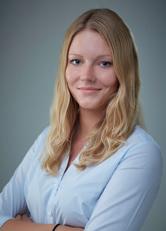
Winter is undeniably here and we’re ready to embrace it to the fullest! What better way to enjoy cosy winter nights than attending a musical, theatre show or concert? One artist that is on tour this month is Marcus Füreder, known as Parov Stelar, this month’s cover star. Credited with founding Electro Swing thanks to his fusion of vintage jazz and electronic beats, the Austrian producer's music is popular worldwide, and his energetic live shows stand out. In our interview, he shares insights into his career, his passion for performing, and his aspirations.
To make winter a little bit more exciting, we explore ice wine, Germany’s rare treat that is shaped by harsh winters, weather, tradition, and plenty of skill. Or, if you look for more active things to do, we have put together a list of the top 12 unusual wintery things to do in Germany. While the country is world-famous for its festive Christmas markets and snow-dusted fairy-tale castles, there’s a hidden side to winter here that beckons the curious and the bold. If you’re a travel enthusiast seeking something beyond the usual, Germany brims with quirky traditions, local secrets and adrenaline-
pumping activities that will transform your winter escape into an unforgettable adventure.
And, if you’re into cross-country skiing, writer and travel photographer Norbert Eisele-Hein travels to Reit im Winkl in Upper Bavaria to explore the region’s famous Nordic Plus concept alongside Tobias Angerer, one of the most successful German cross-country skiers of the 21st century and former overall World Cup winner.
Of course, no winter would be complete without Christmas markets. Thus, we have put together a special theme with some of our favourite ones. We further put a special focus on exciting Christmas gift ideas, the creative minds of the German-speaking book scene, winter magic in Tirol, beautiful accommodations in Switzerland, innovative businesses, exciting hotels and much, much more. Sit back, relax and thanks for reading!
Nane Steinhoff Editor

30 PAROV STELAR
– THE AUSTRIAN ARTIST AND PRODUCER UP CLOSE
Few artists manage to shape an entire genre, but Marcus Füreder aka Parov Stelar has done just that. In this interview, the musician opens up about his creative journey, why he loves live shows, and his big dream as an artist.
16 THE BIG CHRISTMAS GIFT GUIDE
Searching for some great and innovative Christmas presents for your loved ones? Look no fur ther!
42 THE CREATIVE MINDS OF THE GERMAN-SPEAKING BOOK SCENE
From visionary authors to innovative publishers, the German-speaking book scene is coined by authors whose imaginative power and expertise continue to inspire, educate and transform literary landscapes.
68 TOP CHRISTMAS MARKETS 2025
Germany is famous for its beautiful and diverse selection of Christmas markets.
But what is it about these winter wonderland installations that makes them so irresistible? Let’s find out in this special theme.
92 WINTER MAGIC IN TIROL
For some of the exciting winter highlights Tirol has to offer, read this special theme.
111 BEAUTIFUL ACCOMMODATIONS IN SWITZERLAND
From chic alpine lodges to elegant lakeside retreats and luxury hotels, explore distinctive accommodations in Switzerland here.
24 THE FROZEN ELIXIR
Recently, our editor has come across a truly special tale about wine – a tale shaped by weather, tradition, and a lot of skill: Germany’s ice wine. A rare treat, this special wine is known for its bold flavours and the daring way in which it is made.
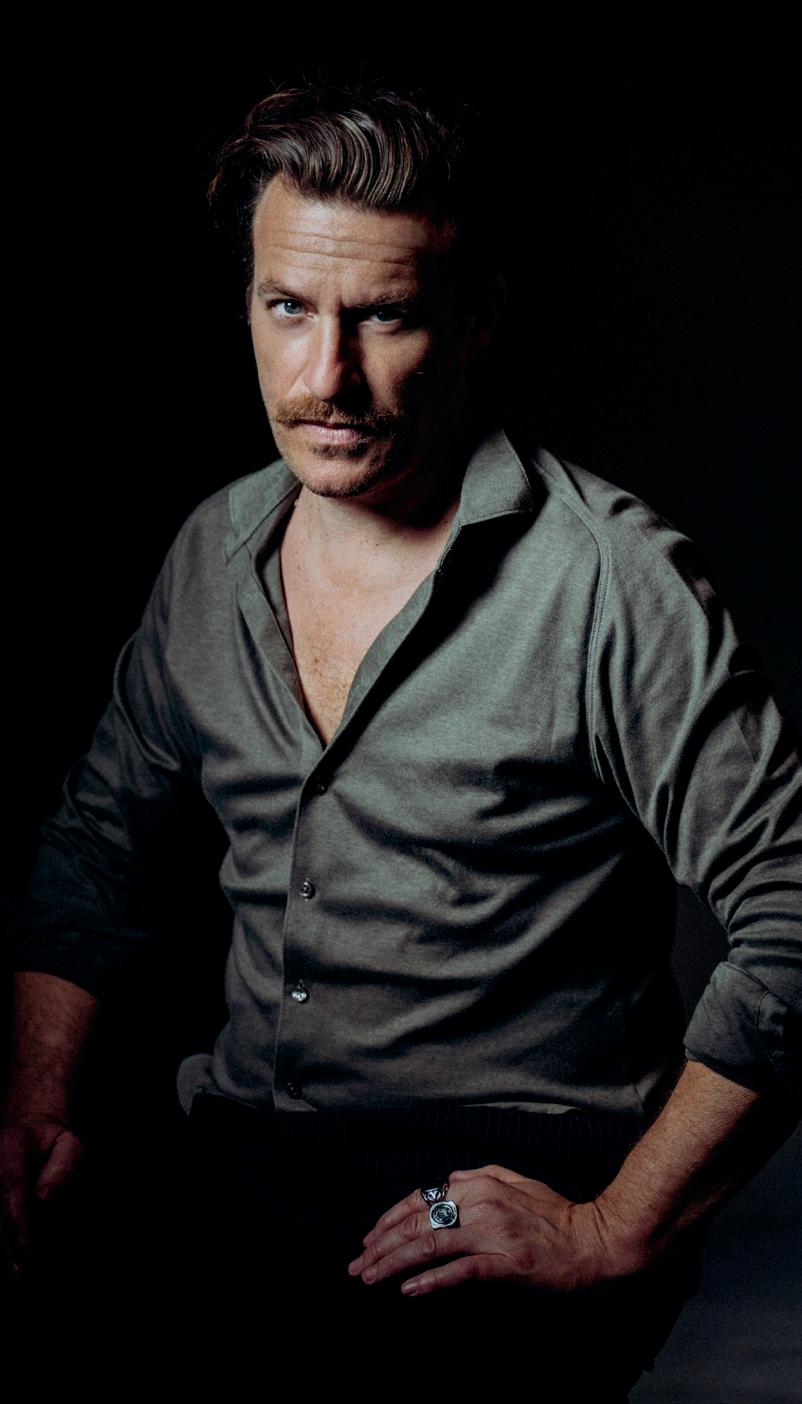
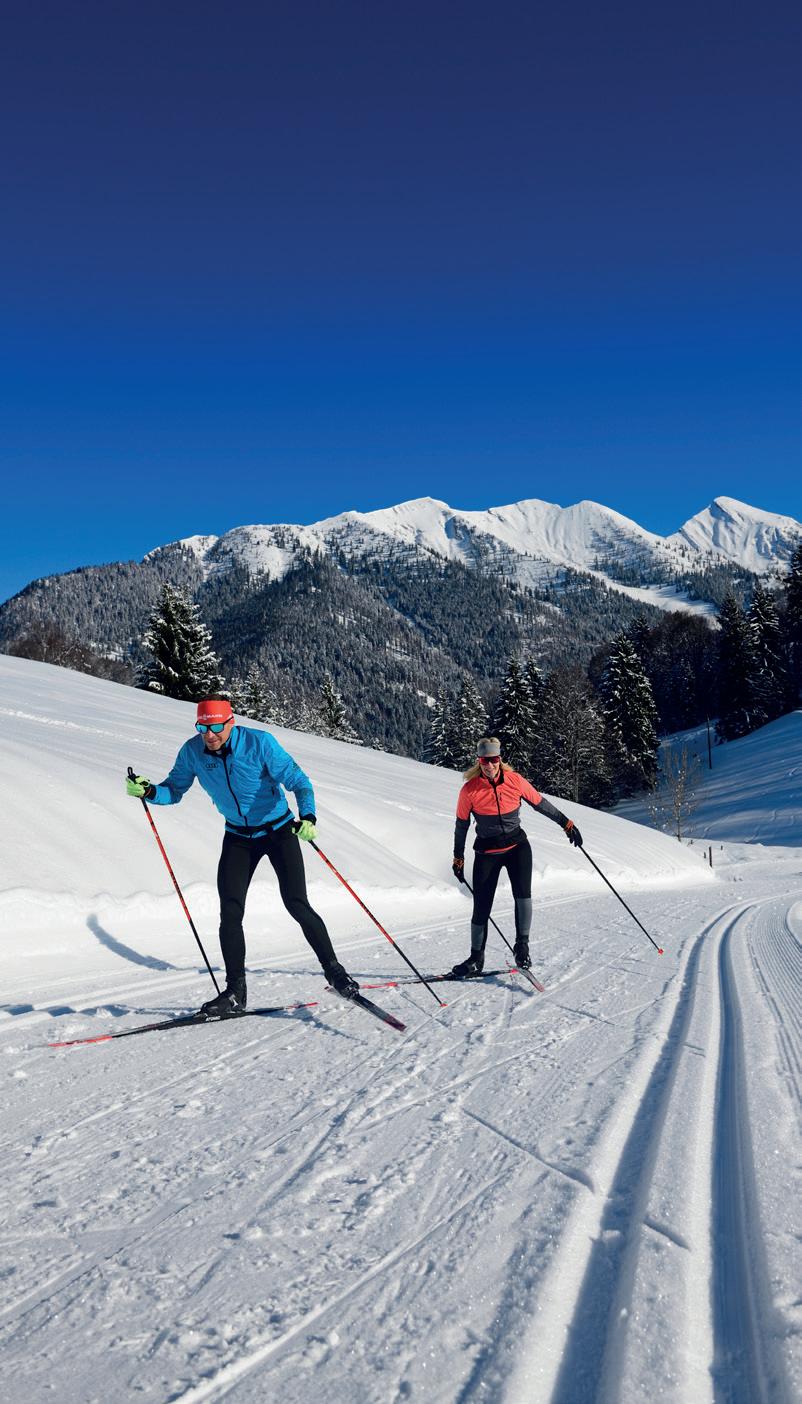
58 A MAGICAL WINTER – TOP 12 UNUSUAL THINGS TO DO IN WINTER IN GERMANY
If you’re a travel enthusiast seeking something beyond the usual, Germany brims with quirky traditions, local secrets and adrenaline-pumping activities that will transform your winter escape.
87 REIT IM WINKL – A WINTER WONDER- LAND FOR CROSS-COUNTRY SKIING
Tobias Angerer, one of the most successful German cross-country skiers of the 21st century, tests Reit im Winkl’s exciting Nordic Plus concept with travel writer and photographer Norbert Eisele-Hein.
106 FROM IRON CURTAIN TO GREEN CORRIDOR
For much of the last century, the Harz Mountains embodied the demarcation of west and east. How has the region turned into a green corridor, and how much of the past can still be experienced here?
6 DEDICATED TO DESIGN & FASHION FINDS
Whether searching for trendy interior items, high-quality jewellery or unique fashion pieces, be sure to take a look at our Design section.
22 WINE & DINE
Looking for culinary highlights for the autumn and winter season? Then our Wine & Dine section is for you.
30 CULTURE
Top shows and exhibitions are in this month’s Culture section.
66 TRAVEL
Hotels and exciting destinations –our Travel section gives you some much-needed travel tips.
124 BUSINESS
Innovative companies and individuals make up our Business section.
125 CULTURE CALENDAR
Discover Germany, Austria & Switzerland’s Culture Calendar is your perfect guide to what not to miss in November.
129 SECRET BERLIN COLUMN
This month, long-term Berlin resident Cornelia Brelowski explores why the capital is often called the ‘city of cyclists’.
130 BARBARA GEIER COLUMN
Here, Barbara Geier writes about a German’s best autumn friend – the omnipresent Übergangsjacke.
Since its founding in 1972, the fashion brand MARC AUREL’s collections have embodied the lifestyle of sophisticated, self-confident women around the world. The brand’s latest autumn/winter collection exudes elegance, while keeping a playful and modern character.
EDITOR’S
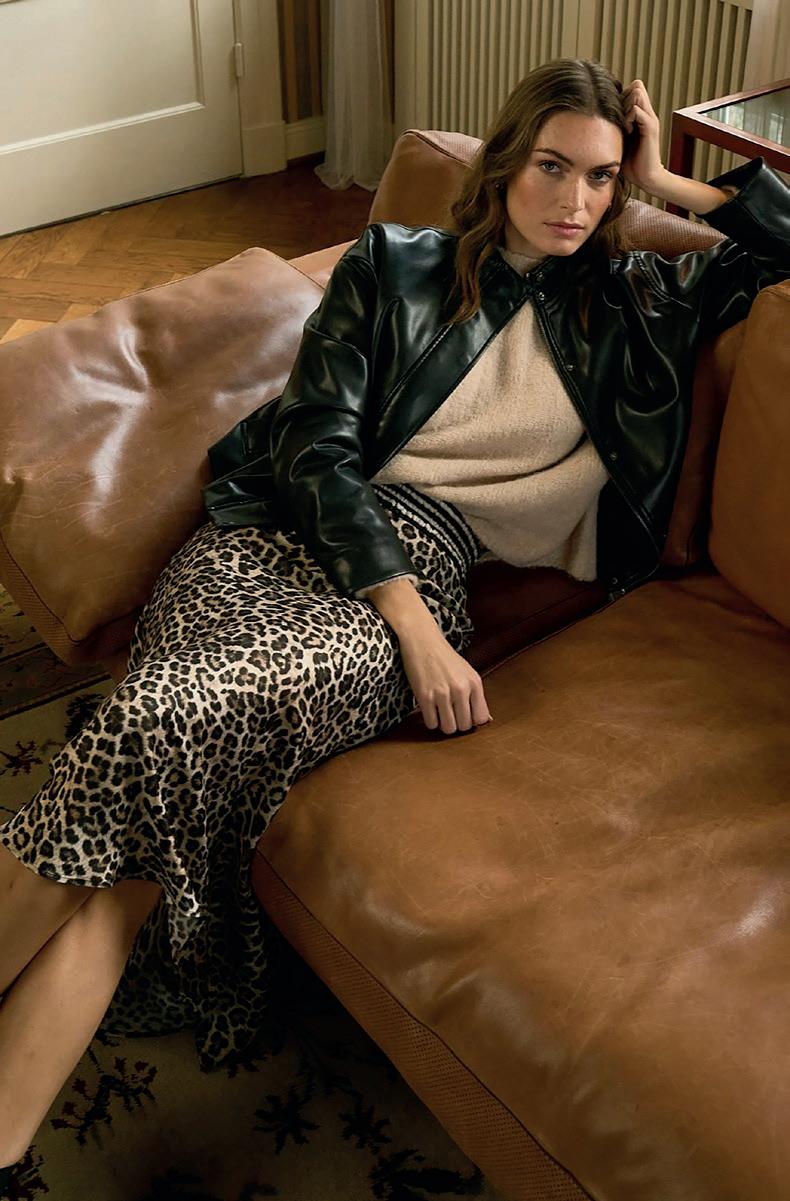

A true editorial standout: this exquisitely designed shirt blends ultra-soft PES mesh with a striking contemporary reptile print, elevating any wardrobe with its on-trend appeal. The refined funnel neck and mesh lining lend an extra layer of sophistication and texture, ensuring a modern silhouette that’s both distinctive and effortlessly stylish. £78.
www.marc-aurel.com
Animal print is here to stay – and we’re in love with the mix of wildness and elegance of this outfit. The midi skirt in viscose satin comes in a slim fit, which creates a feminine silhouette. Pair with this jacket, made from ultra-soft faux leather with a suede underside, for a stylish yet modern look. Jacket £199, sweater £147, midi skirt £129. www.marc-aurel.com
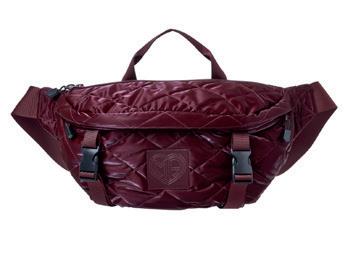
Marrying practicality with high-fashion flair, this bag is crafted from water-repellent outdoor satin, making it the statement piece you’ll want by your side, come rain or shine. Adjustable straps provide styling versatility, ensuring this accessory is as adaptable as it is chic. £104.
www.marc-aurel.com

Turn heads in this eye-catching sweater crafted from a luxuriously soft viscose blend, showcasing a mesmerising Lurex snake jacquard knit. Contemporary side slits and contrasting accents provide a refined edge. £121.
www.marc-aurel.com

For those who dare to stand out, these jeans are a true showstopper. The bold leopard print, enhanced by artful distressed detailing, channels an effortless edge, while the comfort-stretch fabric ensures ease of movement all day long. Finished in a classic 5-pocket style, they offer a nod to timeless denim heritage with a distinctly modern twist. £129. www.marc-aurel.com
A bold statement: this jacket made from vegan patent leather impresses with its minimalist silhouette and modern standup collar. Combined with these wide leg jersey trousers made from a flowing viscose blend, it makes for a comfortable and an elegant look, perfect for stylish casual looks. Trousers £138, jacket £190, jersey t-shirt £69..
www.marc-aurel.com
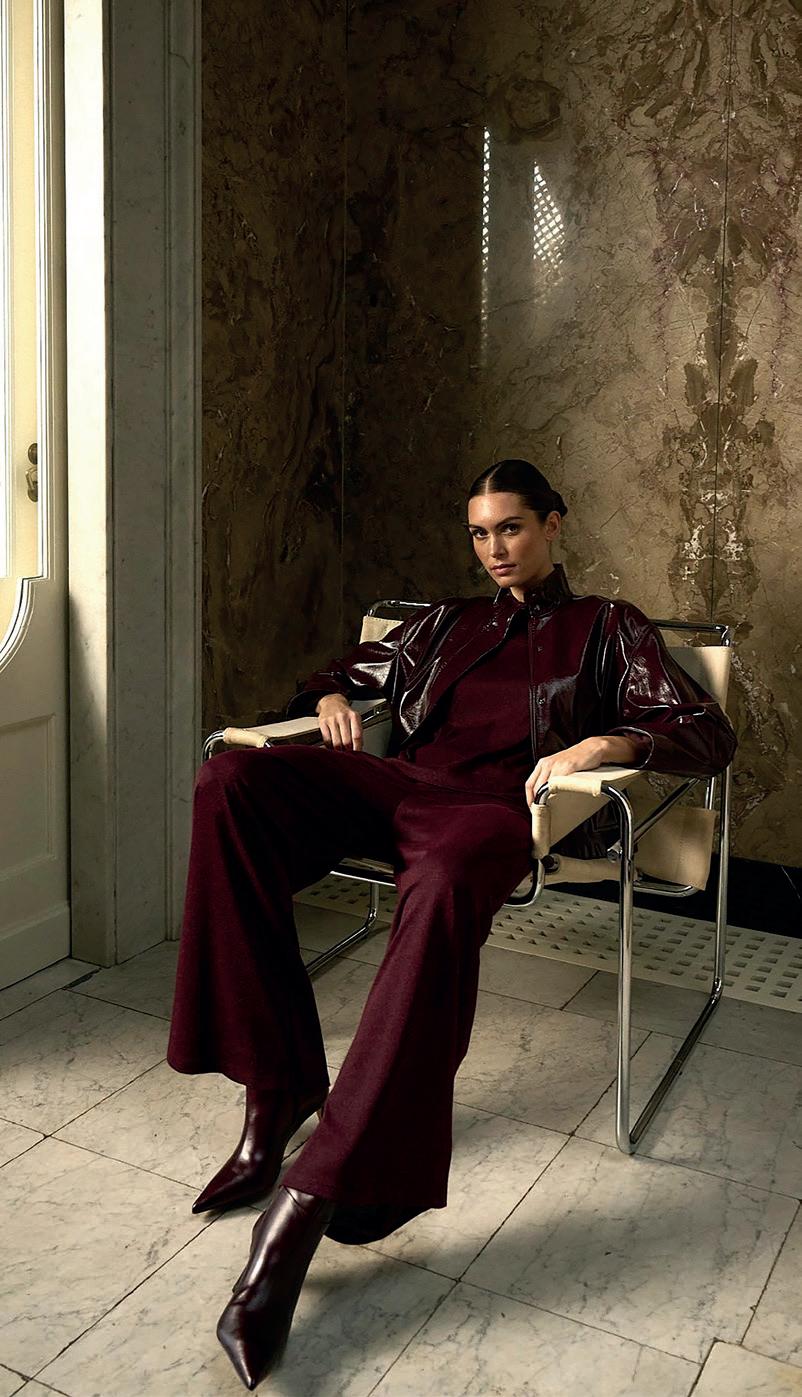
Moody botanicals – that’s an interior trend to look out for this winter. They bring a darker, more dramatic twist to traditional floral styling, combining lush greenery and botanical motifs with rich, atmospheric hues. Think deep emerald green, inky blue, and shadowy plum combined with dark wood, velvet upholstery, and antique-inspired accents.
EDITOR’S PICKS I PHOTOS: PRESS LOFT

In need of a high-quality fabric for new curtains, a tablecloth or cushions? Go with this dreamy, elegant velvet fabric with a wonderfully soft feel and drape. With its elegant shimmer and lush floral pattern, it transforms any space immediately. £23. www.schoener-leben-shop.de

Bring artful and on-trend style to any room with this folk art style vintage black and white print. In a naive painting style, this print will add charm and flair to any wall. £13.50. www.inkanddrop.com
A central piece of MINDTHEGAP’s Transylvanian Manor lighting collection, this floral painterly design comes as a statement lampshade made of natural linen. Finished with gold lining and black looped fringes. Lamp shade £243. www.mindtheg.uk


Want to bring some colour into your space? Since its foundation, the German company Hohenberger has made a name for itself with is exclusive wallpaper designs like the Felice design from the Pepper collection. Vibrant colours, velvety soft contours and a slight shimmer will transform any room. From £147. www.hohenberger-wallcoverings.com
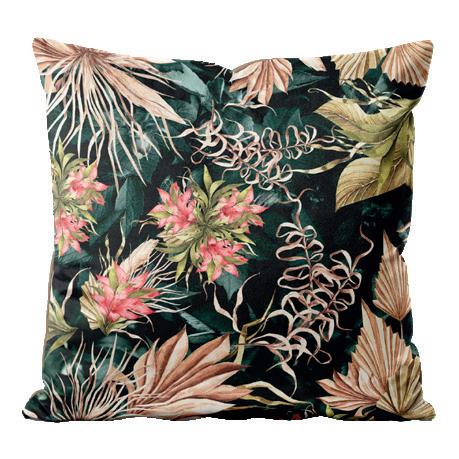
› This gorgeous set of nine framed floral prints features printed illustrations of colourful flowers with green leaves on paper, set within striped fir wood oval frames. £295. www.oka.com
‹ A few well-designed cushions can easily transform the mood of your room. This art cushion is handmade to order and comes in a super soft fauxsuede fabric. £32. www.inkanddrop.com
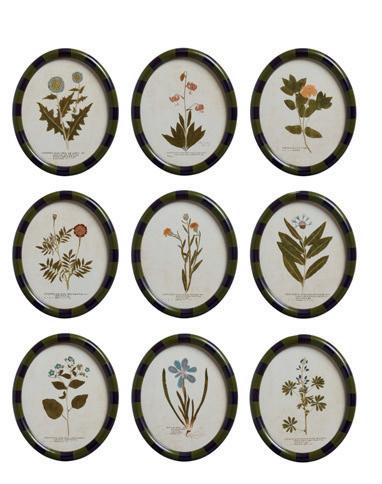
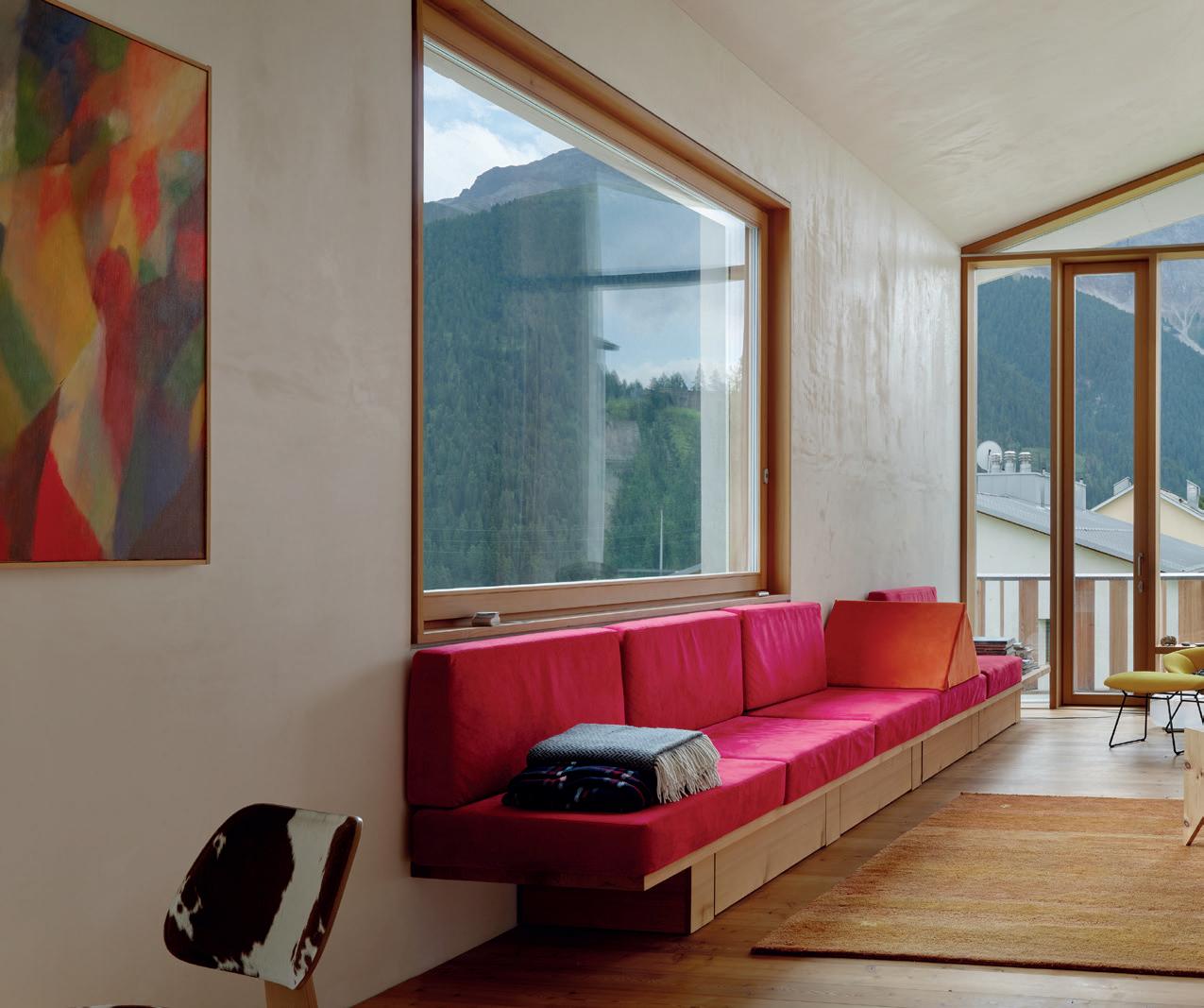
Many towns and villages in Switzerland have their own unique features, building styles and history. To work in this environment, architects need to be aware of the context of the buildings they are creating – no matter whether they are giving renewed life to existing buildings or integrating new developments into their surroundings. Lugano-based architect Jachen Könz and his team see buildings as a public act, where the territorial and urban context set the theme for a project.


All photos on this page: Zuoz Chesa Mariöl.

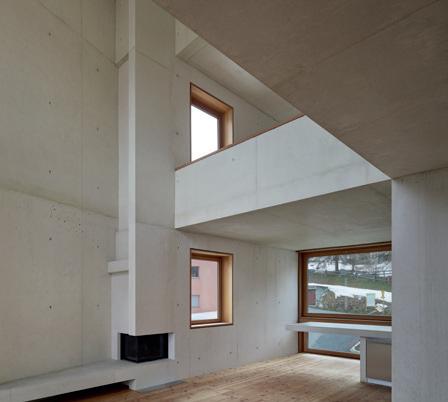

Jachen Könz's architectural approach combines several aspects. He highlights ‘Genius Loci’ as an important factor – that is, the place, the context, and the relationship of buildings to urban and natural landscapes. The private and public space also influence the style, especially when building on a site where the architect has to work with preexisting structures. Born and grown in Ardez, in the Swiss Engadin, Jachen Könz studied architecture in Zurich and Lausanne and has worked in Germany, Barcelona and Bellinzone. In 1992, he founded his own studio in Lugano. His work often brings him back to his roots: the beauty of the Swiss mountains in Engadin, where he realised several buildings, creating new living spaces in close connection to the history of towns and villages.
“Having an old building structure can be a help, like having a partner: the goal is not to invent everything anew, but to react to a presence,” explains architect Jachen Könz. Of course, the quality of existing buildings plays an important role when approaching a new project. One
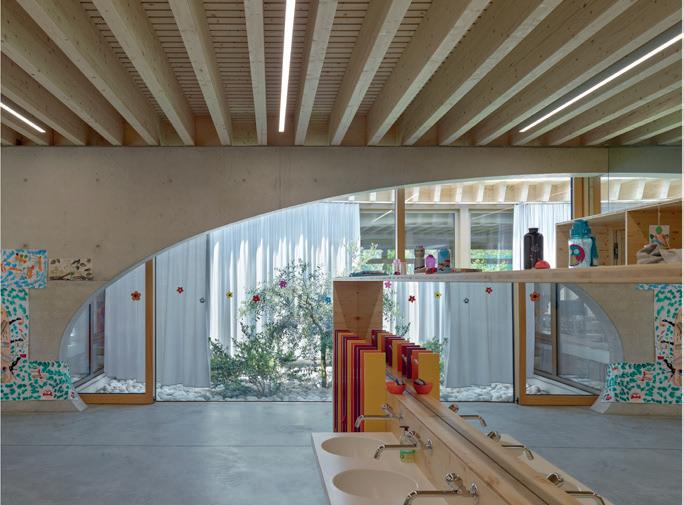
of the projects Könz and his team have been working on in recent years is Chesa Cotschna
S-chanf, a traditional Engadin farmhouse –composed of a part for living and a stable with a hay barn under one roof – situated in the centre of the village.
“It’s important to understand the location and connect it with an updated reality, to transfer it. Interestingly, the opposite of old and new is often an enrichment and can lead to a re-evaluation, a dialogue,” says Könz. This needs critical thinking and the

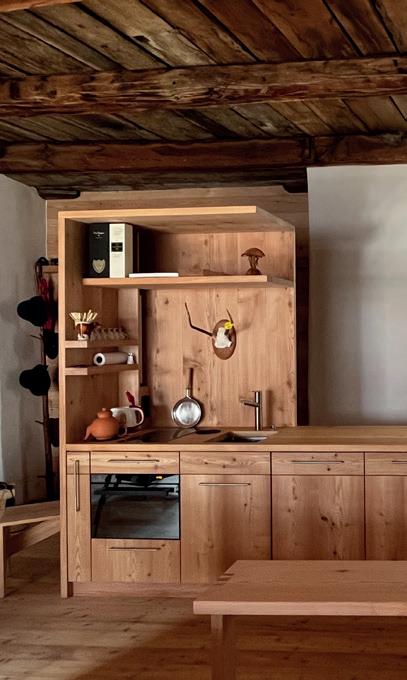

will for a new interpretation of a building’s lived history.
In Chesa Cotschna, using local plain wood, the architects skilfully integrated a new design into the old structures and features that
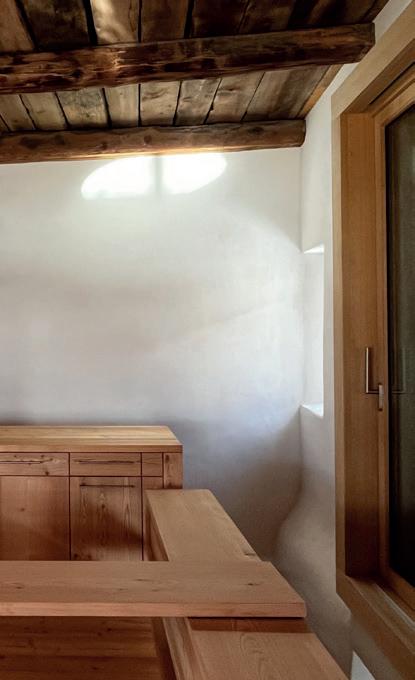
are typical for a farmhouse of this kind. The farmhouse had been refurbished before, which proved to be an additional challenge.
The refurbishment and renovation took place in three steps: first the architects created a new staircase as a central element between the former living quarters and the barn. The

only intervention in the façade is a new large panorama window that helped create a new space for the staircase. Previous refurbishments were removed from the lounge and the upstairs bedrooms, before giving them a new and refreshed life. In a second step, three bedrooms were added to the top floor of the barn, before the barn itself was con-
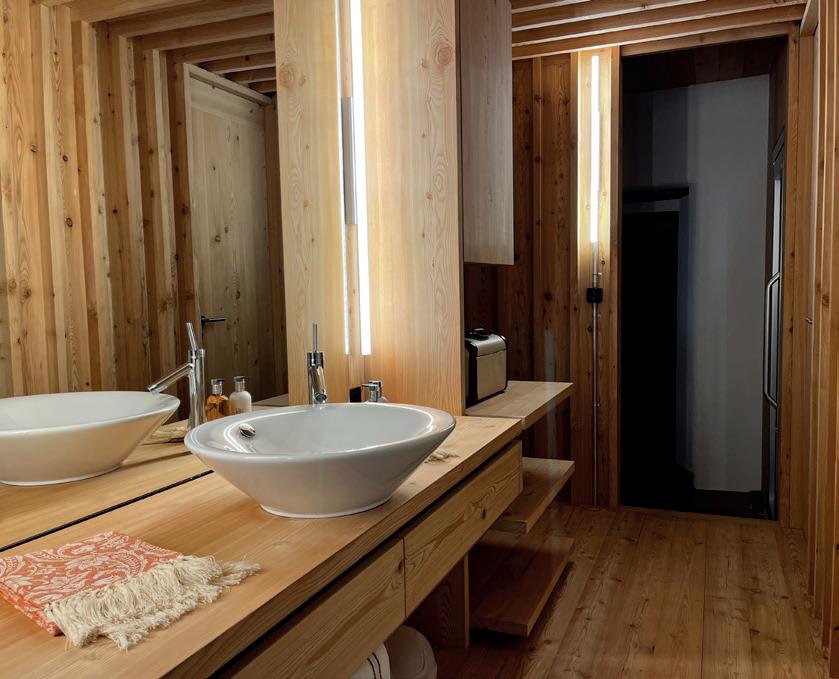
verted into a spacious living area with an additional en-suite bedroom.
Another revitalising project, Chesa Mariöl Sur in Zuoz, the first building of a quarter, came with additional challenges, since it involved the integration of a new building into a historic village centre with its specific Swiss characteristics. Zuoz has one of the most important historic village centres in all of Engadin, with a market place on an incline surrounded by Engadin houses, typical for the area. Here, two roads cross – Talstrasse and Bergstrasse – structuring the whole village and leading downhill towards another village square. Not far from here, at the edge of Zuoz, lies Chesa Mariöl Sur, where Jachen Könz and his team built a new development that takes old structures into consideration.
Initially, the goal was to understand the old village centre in its structure and spatial nature. “After that, it was important to consider which aspects should be further pursued and adjusted to modern requirements,” explains the architect. This included form, functionality and typology and means more than just formally using and adopting existing structures. “The biggest challenge today is to create a public space that includes everyone and not to solely focus on one individual need, on one necessity.” The Chesa Mariöl therefore has two sides and purposes: facing the road, it creates a continuity of other buildings in the public sphere, and towards the back it provides a private space and garden for residents.
Like Chesa Cotschna, the new building S-chanf takes inspiration from the traditional Engadin building style, with 265 square metres of open plan living combined with private rooms in two intimate, introvert wooden cores. The interior is reflected in the exterior, where large panorama windows reflect the open plan living room, while smaller windows provide the same intimacy as the rooms in the rest of the house. The building materials are a combination of modern and traditional as well, with walls in white concrete and larch wood floors. Walls, floors
and ceilings in the bedroom are made from Swiss pine, another local building material.
Naturally, the well-being of future residents should never be overlooked in a building’s design. Residents’ needs are at the heart of every building project. This includes working in a historic structure, and of course also when creating new buildings with different uses.


“One of the greatest appeals of working as an architect is to question humans’ different life functions in society and to give these a new form at different places,” says Jachen Könz about his work. “Every task is a new challenge, a new opportunity. Every task needs its own form.” For Jachen Könz, every new task is additionally determined by its context. “The appeal comes from the challenge to develop and tell a new story. As an architect, you’re an intellectual with a pencil.” In this context he refers to two projects: a kindergarten in Morbio Inferio and a new house in Lugano, a three-generation vertical building with some duplex apartments on a tiny plot – both projects with their own geographic and cultural context, which allow different spatial and formal approaches, “less determined by continuity but as a free expression.”
The mild climate in the region also offered new opportunities for a more open space.
The kindergarten, for example, is structured around two inner courtyards, the building covered by a large roof as a continuous space, designed by the serial superimposed application of wooden beams. The building is arranged on one single floor with an open space, modulated by half-height furniture, ideal for children as main users. In addition, the building is energetically autonomous, making it an ideal new structure for a modern future.
In conclusion, architect Jachen Könz asks and answers an important question: “is it all about new inventions? Does architecture always have to be something special, something new?” Yes and no, or as Jachen Könz says; “yes, but.” New requirements and new technological possibilities allow for new developments, at the same time architects need to take the existing context into consideration, the urban and natural characteristics of its neighbourhood.
“Here lies the difficulty and the challenge. Architecture should renew and at the same time it’s a humble conversation with the existing,” Jachen Könz explains. Existing structures not only tell stories and a history, they also reflect the previous use of materials and climatic conditions, which is useful information for future buildings. The cultural context –that is the ultimate guideline for architects who want to successfully work in the built environment.
www.koenz.ch



Searching for some great and innovative Christmas presents for your loved ones? Look no further! On the following pages, we have put together a special theme that might give you some much-needed gift inspiration for the festive period.

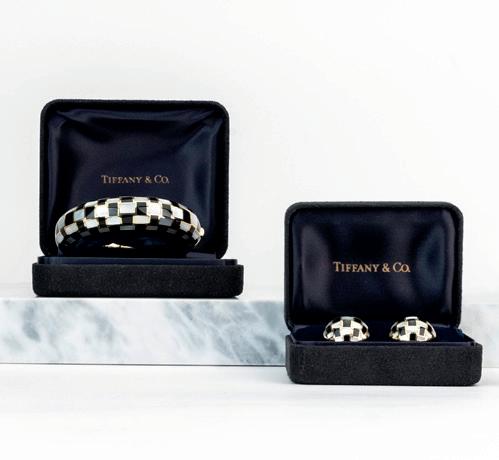
The Founders Auction Group unites tradition and expertise at the highest level.
At its core of the Founders Auction Group are the renowned auction houses Ulrich Felzmann and Dr Reinhard Fischer – both known for excellence in the appraisal and sale of precious collectors’ items for decades. With the addition of the shared brand Rhenumis, their combined knowledge and experience are brought together under one roof for the benefit of discerning consignors and collectors.
Whether philately, numismatics, militaria, phaleristics, watches or jewellery, the Founders Auction Group is a discreet and reliable partner when it comes to valuing, marketing and auctioning individual pieces or entire collections on the international stage. Each year, a wide range of prestigious auctions is held, reaching bidders worldwide through a longestablished and trusted network.
Each house contributes its own area of specialisation. The Ulrich Felzmann auction house is internationally recognised for stamps with a focus on airmail and Zeppelin post, as well as for Chinese philately, autographs and postcards. Dr Reinhard Fischer, meanwhile, is a leading authority on German colonies, occupations during the Second World War and the dispersal of highly specialised collections. Rhenumis adds further expertise in coins, medals and banknotes, alongside militaria, phaleristics, watches and jewellery.
For those wishing to place their collection in the safest of hands – or searching for truly exceptional pieces – the Founders Auction Group offers experience, in-depth expertise and a powerful international network.


Die Founders Auction Group vereint Tradition und Fachwissen auf höchstem Niveau.
Hinter der Unternehmensgruppe Founders Auction Group stehen die renommierten Auktionshäuser Ulrich Felzmann und Dr. Reinhard Fischer – zwei Namen, die seit Jahrzehnten für Kompetenz in der Bewertung und Vermarktung wertvoller Sammlerstücke stehen. Ergänzt durch die gemeinsame Marke Rhenumis bündelt sich hier umfassendes Know-how für anspruchsvolle Sammler und Einlieferer unter einem Dach.
Ob Philatelie, Numismatik, Militaria, Phaleristik, Uhren oder Schmuck –die Founders Auction Group ist ein diskreter und verlässlicher Partner, wenn es darum geht, Einzelstücke oder ganze Sammlungen professionell zu bewerten, zu vermarkten und international zu versteigern. Jährlich finden zahlreiche Auktionen mit weltweiter Reichweite statt, getragen von einem über Jahrzehnte gewachsenen Netzwerk engagierter Käufer.
Die einzelnen Häuser bringen dabei ihre ganz eigenen Schwerpunkte ein: Das Auktionshaus Ulrich Felzmann ist bekannt für Briefmarken mit Fokus auf Flug- und Zeppelinpost sowie internationale Philatelie mit Schwerpunkt China, sowie Autographen und Ansichtskarten. Dr. Reinhard Fischer gilt hingegen als Spezialist für deutsche Kolonien, Besetzungen im Zweiten Weltkrieg und die Auflösung anspruchsvoller Spezialsammlungen. Unter der Marke Rhenumis kommen Münzen, Medaillen und Banknoten hinzu, ebenso Militaria, Phaleristik, Uhren und Schmuck.

Wer seine Sammlung in besten Händen wissen oder gezielt nach außergewöhnlichen Stücken suchen möchte, findet bei der Founders Auction Group Erfahrung, Spezialisierung und ein starkes internationales Netzwerk.


There are many ways to show a special person how much they mean to you. But sometimes it takes more than words. A gift that lasts. For a future we consciously shape.
A diamond has always stood for eternity. But what does forever mean in a changing world? Sometimes it is not just the sparkle that lasts, but also the decision behind it. The choice for something real. For something that will last for generations and can be a promise to our planet.
mandana is exactly that: a gift with attitude, from Germany, created from genuine labgrown diamonds and recycled 18-karat gold. Christine Marhofer, founder of mandana and Nevermined, is behind this idea. As a former buyer in the fashion industry, she knew how fast-paced luxury can be. As a mother of three, the desire for something lasting grew within her. "I wanted to create jewellery that was not only aesthetically pleasing, but also ethically sound. For me, eternity doesn't mean that a diamond grows underground for centuries. It means that we make decisions today that keep our world liveable for future generations," she says.
With Nevermined, she launched one of Europe's first diamond laboratories. At mandana, the Nevermined lab-grown diamonds are used
to create expressive jewellery pieces of a new generation. The advantages of this synergy speak for themselves: true luxury, real diamonds, truly responsible. Ideal for the season of gift-giving – a combination that expresses conscious luxury.
Since 2021, diamonds made of pure carbon –physically, chemically, and optically identical to mined diamonds – have been grown in their own laboratory in Essen under controlled and fair conditions using 100 per cent green electricity. They meet the international 4C standards – carat, colour, clarity, and cut – and are certified by the same renowned laboratories like the IGI. Particularly fascinating are the so-called fancy colours: diamonds in pink, yellow, blue, or green that are as individual as the people who wear them.
At the mandana factory in Pforzheim, where fine craftsmanship meets innovation, diamonds from the Nevermined lab blend with recycled 18-karat gold to create modern designs. Each piece is consciously designed, from the initial concept to the sustainable jewellery case made from Oleatex – a vegan
leather alternative made from waste from the olive oil industry. This makes a gift from mandana more than just a beautiful accessory. It is a statement of responsibility and a piece of infinity that can be passed on.
With this vision, Nevermined and mandana define what true luxury means today: a promise in every facet – for people, for love, for our planet.
www.nevermined-diamonds.com www.mandana-jewellery.com



Es gibt viele Wege, einem besonderen Menschen zu zeigen, was er einem bedeutet. Doch manchmal braucht es mehr als Worte. Ein Geschenk, das bleibt. Für gemeinsame Werte. Für eine Zukunft, die wir bewusst gestalten.
Ein Diamant steht seit jeher für die Ewigkeit. Doch was bedeutet „für immer“ in einer Welt, die sich wandelt? Manchmal ist es nicht nur das Funkeln, das bleibt. Sondern auch die Entscheidung dahinter. Die Wahl für etwas Echtes. Für etwas, das Generationen überdauert und ein Versprechen an unseren Planeten sein kann.
mandana ist genau das: Ein Geschenk mit Haltung, mit Ursprung in Deutschland, erschaffen aus echten lab-grown Diamanten und recyceltem 18 Karat Gold, getragen von Menschen, die mit ihrem Schmuck mehr sagen. Hinter dieser Idee steht Christine Marhofer, Gründerin von mandana und Nevermined. Als ehemalige Einkäuferin in der Modebranche wusste sie, wie schnelllebig Luxus sein kann. Als Mutter dreier Kinder wuchs in ihr der Wunsch nach etwas Bleibendem. „Ich wollte Schmuck kreieren, der nicht nur ästhetisch ist, sondern auch ethisch vertretbar. Für mich bedeutet Ewigkeit nicht, dass ein Diamant über Jahrhunderte unter der Erde wächst. Es bedeutet, dass wir heute Entscheidungen treffen, die unsere Welt für kommende Generationen lebenswert halten“, sagt sie.
Mit Nevermined brachte sie daher eines der ersten Diamantlabore Europas ins Leben. Mit mandana entstehen aus den in Deutschland gewachsenen Nevermined lab-grown Diamanten ausdrucksstarke Schmuckstücke einer neuen Generation. Die Vorteile dieser Synergie sprechen für sich: Echter Luxus. Echte Diamanten. Echt verantwortungsvoll. Ideal für die Zeit des Schenkens – eine Kombination, die bewusstem Luxus Ausdruck verleiht.
Acht Ecken sind das Erkennungszeichen von mandana, weil die ‚8‘ auf der Seite liegend an das Unendlichkeitssymbol erinnert.
Seit 2021 wachsen im eigenen Labor in Essen Diamanten aus reinem Kohlenstoff, also physikalisch, chemisch und optisch identisch mit Minendiamanten, unter kontrollierten und fairen Bedingungen zu 100 % mit Ökostrom heran. Sie erfüllen die internationalen 4C-Standards –Carat, Colour, Clarity und Cut – und werden von denselben renommierten Laboren wie dem IGI zertifiziert. Besonders faszinierend sind die sogenannten ,Fancy Colours’: Diamanten in Pink, Gelb, Blau oder Grün, die so individuell sind, wie die Menschen, die sie tragen.
In der mandana Manufaktur in Pforzheim, wo feine Handwerkskunst und Innovation aufei-
‚All Gens‘ ist mehr als eine Kollektion: Sie ist ein ästhetisches Statement für alle Generationen und Genderidentitäten. Die klaren Designs und nachhaltigen Materialien stehen für mehr Vielfalt.
nandertreffen, verschmelzen die Diamanten aus dem Nevermined Labor mit recyceltem 18 Karat Gold zu modernen Designs. Jedes Piece ist bewusst gestaltet, von der Idee bis zum nachhaltigen Schmucketui aus Oleatex –einer veganen Lederalternative aus Resten der Olivenöl-Industrie. So wird ein Geschenk von mandana mehr als ein schönes Accessoire. Es ist ein Statement für Verantwortung und ein Stück Unendlichkeit, das man weitergeben kann.
Mit dieser Vision definieren Nevermined und mandana, was echter Luxus heutzutage bedeutet: ein Versprechen in jeder Facette – für Menschen, für Liebe, für unseren Planeten.
www.nevermined-diamonds.com www.mandana-jewellery.com


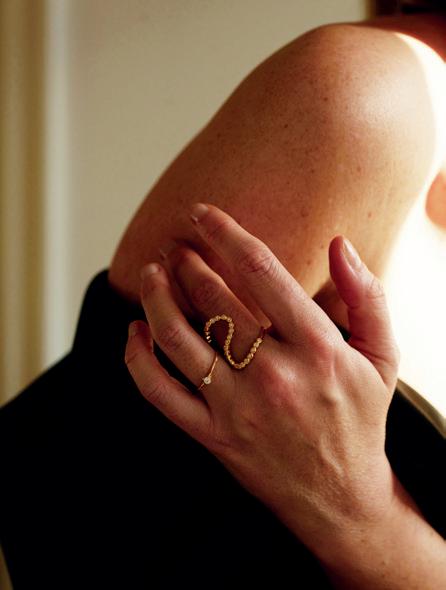
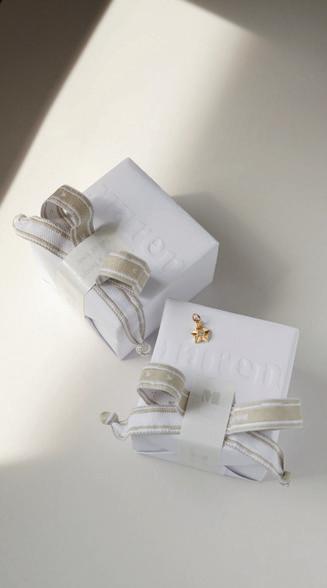
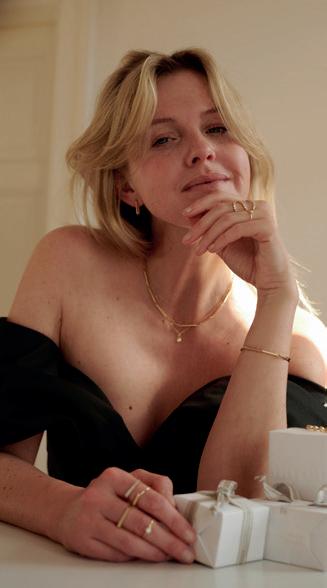
Maren Jewellery steht für eine neue Art von Luxus, bei der Nachhaltigkeit, zeitloses Design und höchste Handwerkskunst miteinander verschmelzen.
Die Gründungsidee für Maren Jewellery entstand aus dem Wunsch, Schmuck zu kreieren, der nicht nur ästhetisch überzeugt, sondern auch Verantwortung für Umwelt und Gesellschaft übernimmt. Als studierte Schmuckdesignerin entwirft Helge Maren Hauptmann jedes Stück selbst und setzt dabei auf dezente, minimalistische Formen, die Liebe, Achtsamkeit und Beständigkeit symbolisieren. „Schon immer war Schmuck meine große Leidenschaft“, so Hauptmann. „Und so habe ich Maren Jewellery gegründet, um meine Vision von modernem, verantwortungsbewusstem Luxus umzusetzen.“
Ein zentrales Element der Unternehmensphilosophie ist die konsequente Nachhaltigkeit. Maren Jewellery ist nicht nur B Corp zertifiziert und Mitglied des Responsible Jewellery Council (RJC), sondern setzt auch auf Kreislaufwirtschaft. So werden alle Schmuckstücke aus recyceltem Gold und Silber gefertigt. Das bedeutet, es werden keine neuen Ressourcen verbraucht und der ökologische Fußabdruck
bleibt minimal. Für die funkelnden Akzente sorgen ausschließlich im Labor gezüchtete, konfliktfreie Diamanten und die gesamte Produktion findet in Deutschland statt, wodurch faire Arbeitsbedingungen und kurze Lieferwege garantiert sind. Auch die Verpackungen spiegeln den nachhaltigen Ansatz wider: Sie sind plastikfrei, bestehen aus recycelten Materialien und können mehrfach verwendet werden. So wird Transparenz entlang der gesamten Wertschöpfungskette großgeschrieben.
Für seine innovativen Ansätze hat Maren Jewellery bereits mehrere renommierte Designpreise erhalten, darunter den German Design Award und den Green Product Award. Zudem wurde Maren Jewellery für den Deutschen Nachhaltigkeitspreis nominiert –ein weiterer Beweis für die Vorreiterrolle in der Branche.
Gerade zur Weihnachtszeit hebt Maren Jewellery die Idee hervor, Werte zu schenken, die bleiben: Nachhaltigkeit, Verant-
wortung und zeitlose Schönheit. „Unsere Schmuckstücke stehen nicht nur für Ästhetik, sondern auch für eine bewusste Entscheidung – für Geschenke, die nicht vergänglich sind, sondern Beständigkeit und Liebe symbolisieren“, sagt Hauptmann. Wer sich also für Maren Jewellery entscheidet, wählt bewusst nachhaltigen, modernen Luxus, der Schönheit und Wertschätzung für die Zukunft verbindet. So setzt die Marke ein klares Zeichen, dass Schmuck mehr sein kann als ein modisches Accessoire – er wird zum Statement für eine bessere Welt.
www.marenjewellery.com
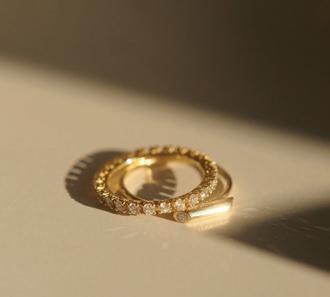


Über 70 Termine in Europa, z.B.:
24.01.2026 Frankfurt
20.02.2026 Dortmund

05.04.2026 Berlin
19.04.2026 Leipzig
26.04.2026 Stuttgart
17.05.2026 Düsseldorf
04.09.2026 Köln
11.09.2026 Hamburg
20.09.2026 Zürich
26.11.2026 Paris
28.11.2026 Nancy
12.12.2026 Wien
13.12.2026 Linz
02.01.2027 Reykjavik

Präsentiert von

Die Besucher sind sich einig:




JETZT Tickets bei allen bekannten VVK-Stellen und

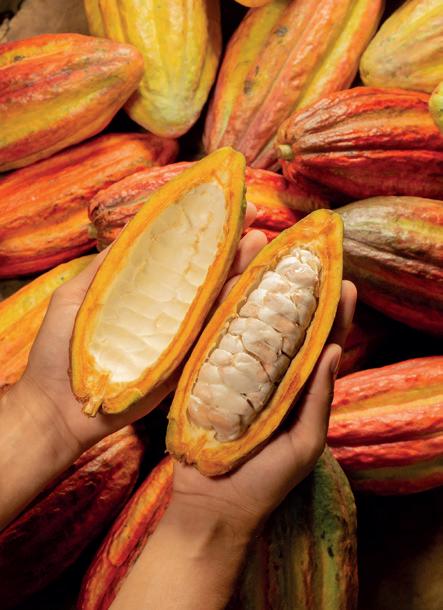
Recent years have shown how important sustainable cocoa cultivation is: three consecutive crop failures have led to cocoa becoming scarce and raw material prices skyrocketing. Crop failures are a major problem for farmers in particular. Ultimately, everyone suffers – including chocolate fans around the world, because chocolate is becoming more expensive.
Chocolate manufacturer Ritter is committed to the principle of partnership. The family-owned company is primarily concerned with ensuring maximum transparency throughout the entire supply chain. The cocoa used in Ritter Sport chocolate is therefore not only certified, but also traceable. This is important to Ritter. Because only those who know where the cocoa comes from can do something to improve the situation for nature and the local people.
People like Francis Obeng. The father of six children is a cocoa farmer in Ghana and participates in the local Ritter Sport cocoa programme. One of the programme's main focuses is to make cocoa cultivation more resilient through sustainable agriculture. In view of climate change, this is urgently needed: "My cocoa yields are declining year after year. Temperatures have risen and there is no longer any stable rainfall," says
Francis Obeng, explaining the situation in his home country. "That's why I've started planting shade trees to protect the cocoa from too much sun and improve the microclimate on my plantation." Over the past two years, around half a million shade tree seedlings have been distributed to farmers as part of the Ritter Sport cocoa programmes.
3 QUESTIONS FOR:
Lydia Frech, responsible for the Ritter Sport cocoa programmes
WHAT ARE THE COCOA PROGRAMMES?
“They are partnerships with cocoa farmers that not only offer producers security through contractually agreed purchase quantities, but also include measures to make cultivation more resilient. It is important that our work is geared to the specific needs on the ground.”
WHERE ARE SUCH PROGRAMMES AVAILABLE?
“We have established programmes in all countries from which we source cocoa and work with over 20,000 farmers in West Africa and Latin America. The principle of partnerships is a tradition at Ritter. The first cocoa programme dates back 35 years.”
WHY IS THIS SO IMPORTANT?
“Increasing extreme weather events, including in cocoa-growing regions, have led to a shortage of raw materials and skyrocketing prices. The connection is quite simple: we need good cocoa to make good chocolate. That is why we must continue our commitment and support the people in the growing regions.”
Every year, the Australian initiative Be Slavery Free assesses the sustainable cocoa sourcing practices of major companies in its Chocolate Scorecard. In 2025, Ritter Sport was once again ranked among the top four companies worldwide and was recognised as “leading the industry on policy and implementation”. For more information, visit: www.chocolatescorecard.com
Wie wichtig ein nachhaltiger Kakaoanbau ist, haben die letzten Jahre gezeigt: Drei Missernten in Folge haben dazu geführt, dass Kakao knapp geworden ist und die Rohstoffpreise explodiert sind. Ernteausfälle sind vor allem ein großes Problem für Bäuerinnen und Bauern. Letztlich leiden aber alle darunter – auch die Schokofans in aller Welt, weil Schokolade teurer wird.
Der Schokoladenhersteller Ritter setzt auf das Prinzip der Partnerschaften. Dem Familienunternehmen geht es vor allem um größtmögliche Transparenz entlang der gesamten Lieferkette. Der Kakao für Ritter Sport Schokolade ist daher nicht nur zertifiziert, sondern auch rückverfolgbar. Das ist Ritter wichtig. Denn nur wer weiß, woher der Kakao stammt, kann etwas dafür tun, dass es der Natur und den Menschen vor Ort besser geht.
Menschen wie Francis Obeng. Der Vater von sechs Kindern ist Kakaobauer in Ghana und nimmt am dortigen Ritter Sport KakaoProgramm teil. Ein Schwerpunkt dabei ist es, den Kakaoanbau durch eine nachhaltige Landwirtschaft widerstandsfähiger zu machen. Angesichts des Klimawandels ist das dringend notwendig: „Meine Kakaoerträge gehen von Jahr zu Jahr zurück. Die Temperaturen sind gestiegen und es gibt keine stabilen Niederschläge mehr“, erklärt Francis Obeng die Situation in seinem Heimatland. „Ich habe deshalb begonnen, Schattenbäume zu pflanzen, die den Kakao vor zu viel Sonne schützen und das Mikroklima auf meiner Plantage verbessern.“
In den letzten zwei Jahren wurden in den Ritter Sport Kakao-Programmen rund eine halbe Million Schattenbaumsetzlinge an Bäuerinnen und Bauern verteilt.
Nachhaltige Landwirtschaft macht den Kakaoanbau widerstandfähiger.
3 FRAGEN AN:
Lydia Frech, zuständig für die Ritter Sport Kakaoprogramme
WAS SIND KAKAOPROGRAMME?
„Das sind Partnerschaften mit Kakaobäuerinnen und -bauern, die nicht nur durch vertraglich vereinbarte Abnahmemengen den Erzeugern Sicherheit bieten, sondern immer auch Maßnahmen beinhalten, um den Anbau resilienter zu machen. Dabei ist es wichtig, dass sich unsere Arbeit an den konkreten Bedürfnissen vor Ort ausrichtet.”
WO GIBT ES SOLCHE PROGRAMME?

„Wir haben in allen Ländern, aus denen wir Kakao beziehen, Programme etabliert und arbeiten mit über 20.000 Bäuerinnen und Bauern in Westafrika und Lateinamerika zusammen. Das Prinzip der Partnerschaften hat bei Ritter Tradition. Die Anfänge des ersten Kakaoprogramms reichen bereits 35 Jahre zurück.”
WARUM IST DAS SO WICHTIG?
„Die zunehmenden Extremwetterereignisse auch in den Kakaoanbauregionen haben dazu geführt, dass der Rohstoff inzwischen knapp ist und die Preise explodiert sind. Der Zusammenhang ist ganz einfach: Für gute
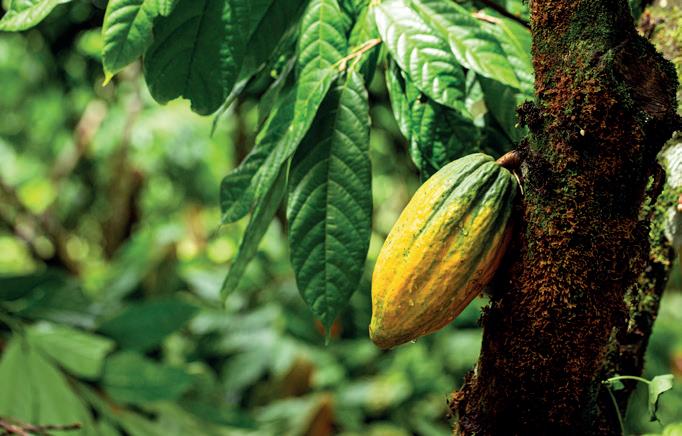
Schokolade brauchen wir guten Kakao. Deshalb müssen wir uns auch weiterhin engagieren und die Menschen in den Anbauregionen unterstützen.”

Lydia Frech betreut bei Ritter die Kakaoprogramme mit Bäuerinnen und Bauern in Westafrika und Lateinamerika.
Die australische Initiative Be Slavery Free bewertet jedes Jahr in der Chocolate Scorecard den nachhaltigen Kakaobezug wichtiger Unternehmen. Auch 2025 zählt Ritter Sport zu den Top vier Unternehmen weltweit und wurde als „Leading the industry on policy and implementation” ausgezeichnet. Mehr unter: www.chocolatescorecard.com

Recently, I have come across a truly special tale about wine – a tale shaped by weather, tradition, and a lot of skill: Germany’s ice wine. A rare treat, this special wine is known for its bold flavours and the daring way in which it is made.
TEXT: NANE STEINHOFF | PHOTOS:
WWW.DEUTSCHEWEINE.DE


Ice wine, or Eiswein as it is known in German, is more than a dessert wine; it is a product of patience, risk, and a touch of luck. Its creation depends on the perfect confluence of weather and willpower, resulting in a golden, aromatic wine with remarkable sweetness balanced by vibrant acidity. The allure of ice
wine lies not only in its flavour but in the drama and unpredictability of its production.
While Canada is the world’s largest ice wine producer due to the country’s ideal climate for that specific type of wine (Canada pro-

duces more ice wine than all other countries combined), Germany and Austria come in second and third place when it comes to the volume of ice wine production.
According to The WineBarn, an award-winning German wine specialist and German wine importer in the UK, German ice wine “is popular for festive occasions, and also makes an exquisite aperitif on its own,” which best complements fruity desserts, ice cream or a cold sorbet.
The production of ice wine is a fascinating and demanding process that sets it apart from other wine styles. It begins with winemakers leaving healthy grapes on the vine well past the usual harvest, often into the depths of winter. The crucial element is the weather: the grapes must freeze naturally at temperatures of -7°C or colder. This hard frost freezes the water inside the grapes but leaves the sugars and other dissolved solids unfrozen, concentrating their flavours and sweetness.
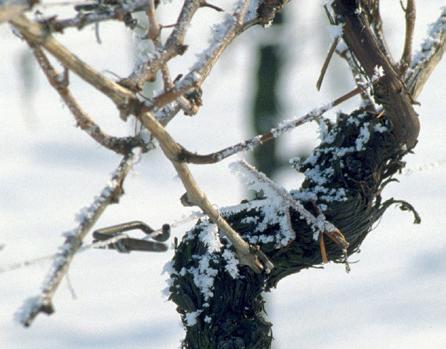
Harvesting ice wine is an exercise in both patience and quick action. Grapes are typically picked in the early morning hours, while still solidly frozen, and pressed immediately. The frozen water content stays behind in the press, resulting in a thick, intensely sweet juice that will become ice wine. Because of the challenging conditions and the small volume of juice extracted, yields are exceptionally low – sometimes less than a tenth of a typical harvest.
The WineBarn explains just how rare the perfect harvest of ice wines really is: “Germany’s 2018 yield produced very large grapes that were particularly healthy, which led growers to chance leaving a portion on the vines in the hope of an Eiswein harvest later. It certainly paid off, as the 2018 vintage has been one of the best in years.”
Fermenting this syrupy juice is also tricky due to the high sugar content, which slows yeast activity and keeps alcohol levels relatively low, often around 7 per cent. Only select grape varieties, such as Riesling and Silvaner, are suited to this method, thanks to their ability to maintain lively acidity and complex aromas throughout the process.
Germany’s association with ice wine dates back to the late 18th century. The first documented ice wine vintage was crafted in 1794 in the Franconia region, when an unexpected frost forced vintners to harvest frozen grapes. It was a lucky accident. Instead of discarding the crop, they pressed the icy fruit, producing a small amount of intensely flavoured wine – a discovery that would become a celebrated tradition.
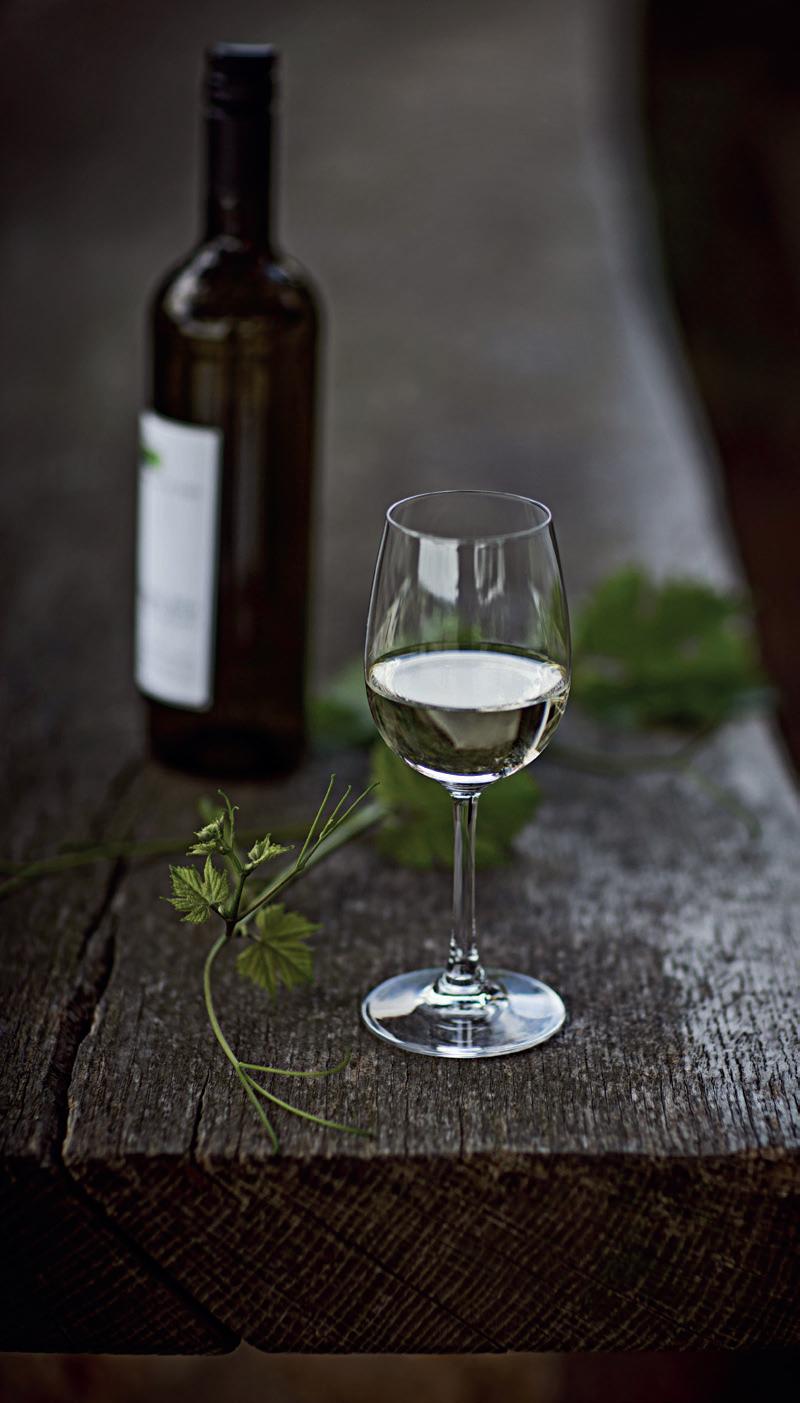
Throughout the 19th and 20th centuries, the practice spread across Germany’s wine regions, evolving from accidental innovation to intentional artistry. By the mid-20th century, ice wine had gained international prestige, with German producers refining techniques and setting benchmarks for quality that inspired winemakers worldwide. Over time, other regions and countries also adapted the idea, notably Canada where in the 1980s vintners realised that their cold winters offered ideal conditions for the production of ice wines. Canada quickly evolved into the world’s largest producer of ice wine.
Germany’s wine landscape is diverse, but certain regions have become synonymous with exceptional ice wine. The Rheingau and Mosel valleys, with their steep slopes and proximity to rivers, offer microclimates that can deliver the critical freeze required for ice wine production. Here, old vines and traditional practices intersect with modern innovation, creating wines of remarkable purity and finesse.
Other regions, such as Pfalz, Nahe, and Franken, have also produced notable ice wines, each reflecting local terroir through
subtle differences in aroma and structure. The interplay of soil, aspect, and weather means that no two ice wine vintages are ever quite the same, making each bottle a unique expression of its origin.
While the drama of harvest has always defined ice wine, recent decades have brought new challenges. Climate change has rendered the reliable freeze increasingly elusive, with milder winters disrupting the delicate balance required for successful ice wine production. Producers must now contend
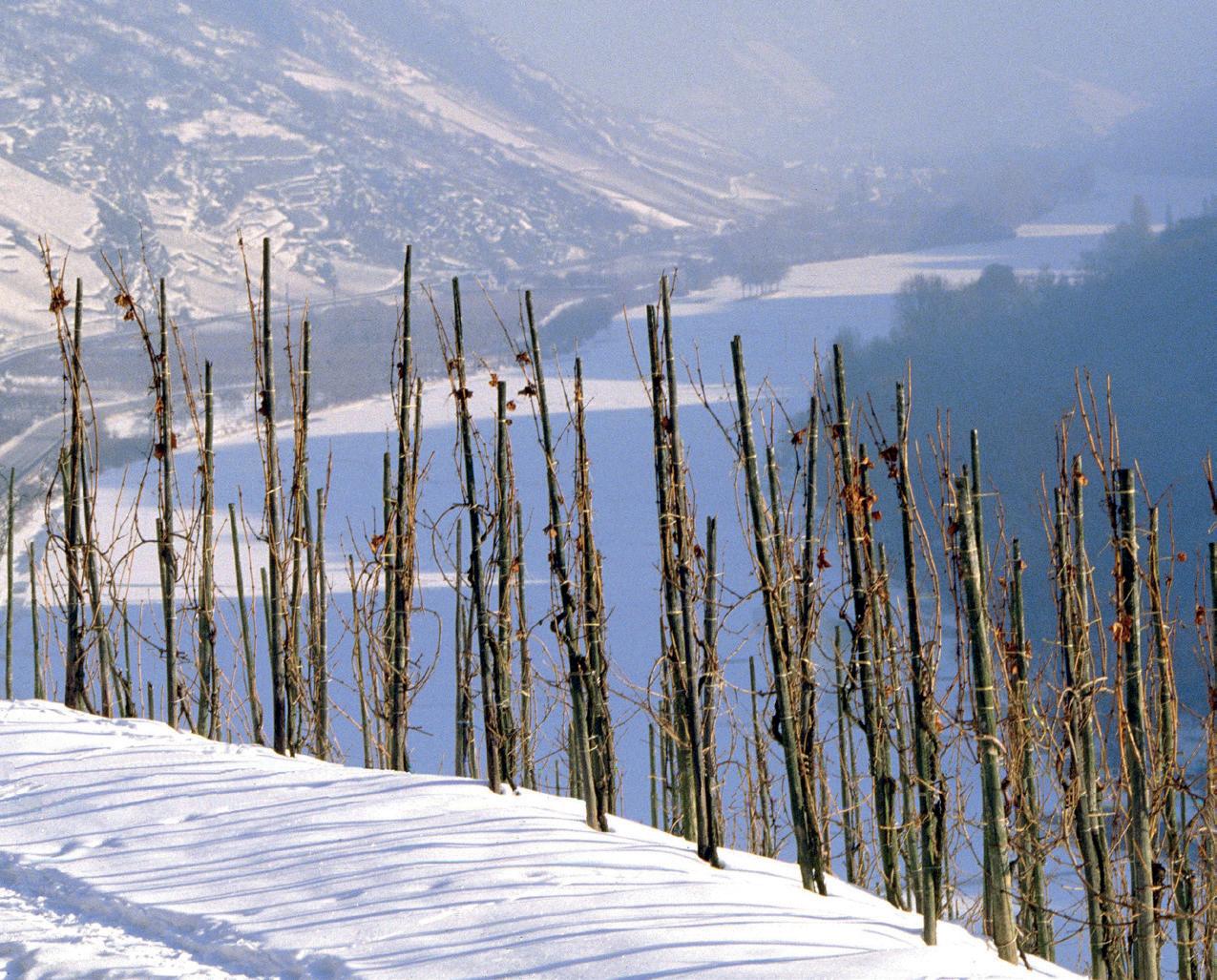
with greater uncertainty, sometimes waiting in vain for temperatures to drop, or risking grapes to rot, birds, or wild animals.
In some years, entire regions may produce no ice wine at all – a stark reminder of the wine’s dependence on nature’s whims. As the frequency of suitable freezes declines, German winemakers are exploring new approaches, such as site selection at higher elevations, or experimenting with alternative grape varieties that better withstand variable conditions. There is growing interest in hybrid grape varieties and adaptive vine-

yard management, as well as collaboration across regions to share best practices for safeguarding ice wine’s legacy.
Technology, too, is playing a role, from advanced weather tracking to innovations in vineyard design that improve the odds of a successful freeze. Some producers have begun to diversify, focusing on other styles of sweet wine or exporting their expertise to colder climates abroad. Yet, there remains an inherent risk; ice wine is, and always has been, a gamble.
Despite its rarity, German ice wine occupies an outsized place in the global wine market. Coveted by collectors and connoisseurs, it commands premium prices and has become a hallmark of German winemaking excellence. Its reputation for purity and balance sets it apart from ice wines produced elsewhere, particularly those made using artificial freezing techniques.
Within Germany, ice wine is both a source of regional pride and a cultural touchstone, often enjoyed on special occasions or paired with fine desserts. Its presence at auctions and in luxury hospitality further cements its status as a wine of celebration and distinction. However, as supply diminishes, there is an increasing awareness that every bottle represents not just craftsmanship, but also an encounter with nature’s generosity.
German ice wine is a testament to the interplay between climate, culture, and creativity. Its history is marked by both accidental fortune and deliberate mastery, while its production remains one of the wine world’s most daring pursuits. In the face of climate change and market pressures, the spirit of ice wine or Eiswein endures – defined by resilience, innovation, and a willingness to embrace risk for the sake of extraordinary reward.


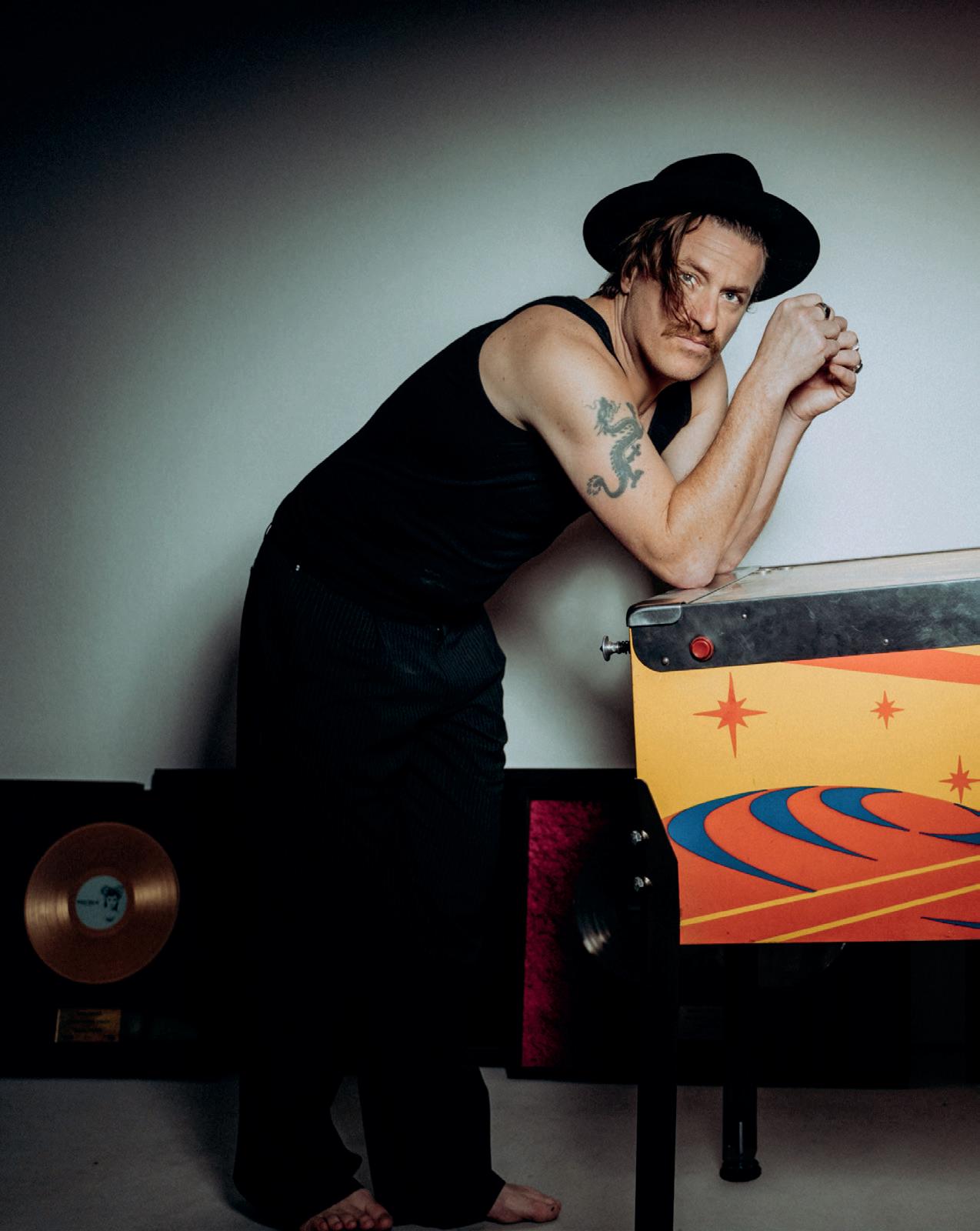

PAROV STELAR:
“EVERYTHING I’VE ACHIEVED SO FAR IS JUST A MILESTONE ON MY JOURNEY”
Few artists manage to shape an entire genre, but Marcus Füreder aka Parov Stelar has done just that. Known as the founder of Electro Swing, the Austrian producer and artist blends vintage jazz and swing with crisp electronic beats, creating a sound that feels both timeless and modern. His tracks have become global dance floor favourites, and his live shows are celebrated for their extraordinary energy. In this interview, Parov Stelar opens up about his creative journey, why he loves live shows, and his big dream as an artist.
SILKE HENKELE | PHOTOS: TANJA SCHALLING
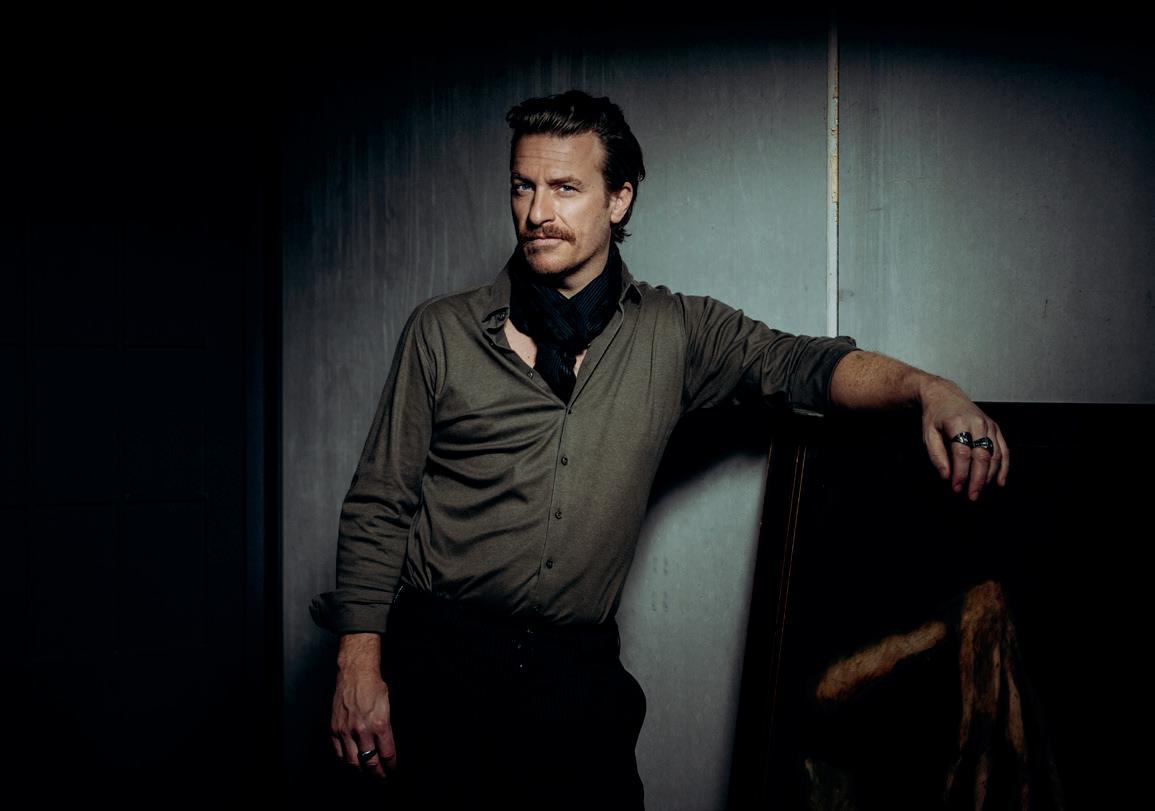
DISCOVER GERMANY: Parov, thanks for taking the time to speak with us. You’ve got quite a lot happening at the moment: Your new book Trip is about to be released, your new album Artifact comes out on 14 November, and you’re also on tour.
Parov Stelar: Thanks, it’s a pleasure. I’m looking forward to our chat.
DG: You’re one of Austria’s internationally most successful musicians. For readers who may not yet know you, could you share a little about your roots and how it all began?
PS: I grew up in a small Austrian village and nothing really pointed towards a career in music. My mother is an artist, so I was surrounded by creativity all my life, but I never felt drawn to follow in her footsteps. My father worked in IT, and at first, I wanted to become a professional tennis player. Things changed
when I started studying. I always liked drawing and was asked to design posters for techno concerts. I thought that this type of music all sounded the same, so I made a bet with a friend that I could produce a techno track myself. He took me up on it. That’s how it all began. I soon discovered how challenging it was to create a techno track and how much creative energy it required. This creative process fascinated me then, and it still keeps me inspired today.
DG: Let’s talk about Electro Swing, the genre you’re credited with creating. Was it a conscious decision to shape a new genre?
PS: Not really. Electro Swing was more the result of coincidence and creative curiosity. After a few years, I felt the need to change perspective and open myself up to new influences. That’s when I discovered the irresistible energy of 1920s Swing. Its wildness
captivated me instantly. At first, people around me were sceptical that this would work. Well, it does, doesn’t it?
DG: How would you describe the genre?
PS: That’s tricky, because for me, Electro Swing is more of a feeling. At first glance, Techno or House has nothing to do with Swing. But when I think of the 1920s, I see the first ravers in history: their wild dances, their energy, their zest for life. Just like today’s rave culture, Swing was about breaking free of conventions. So, Electro Swing, to me, is exactly that: a wild, joyful celebration of life.
DG: You started your career nearly 30 years ago and are now firmly established in the music scene. Many contemporary artists often struggle to find a foothold and build a loyal fan base. How do you balance your
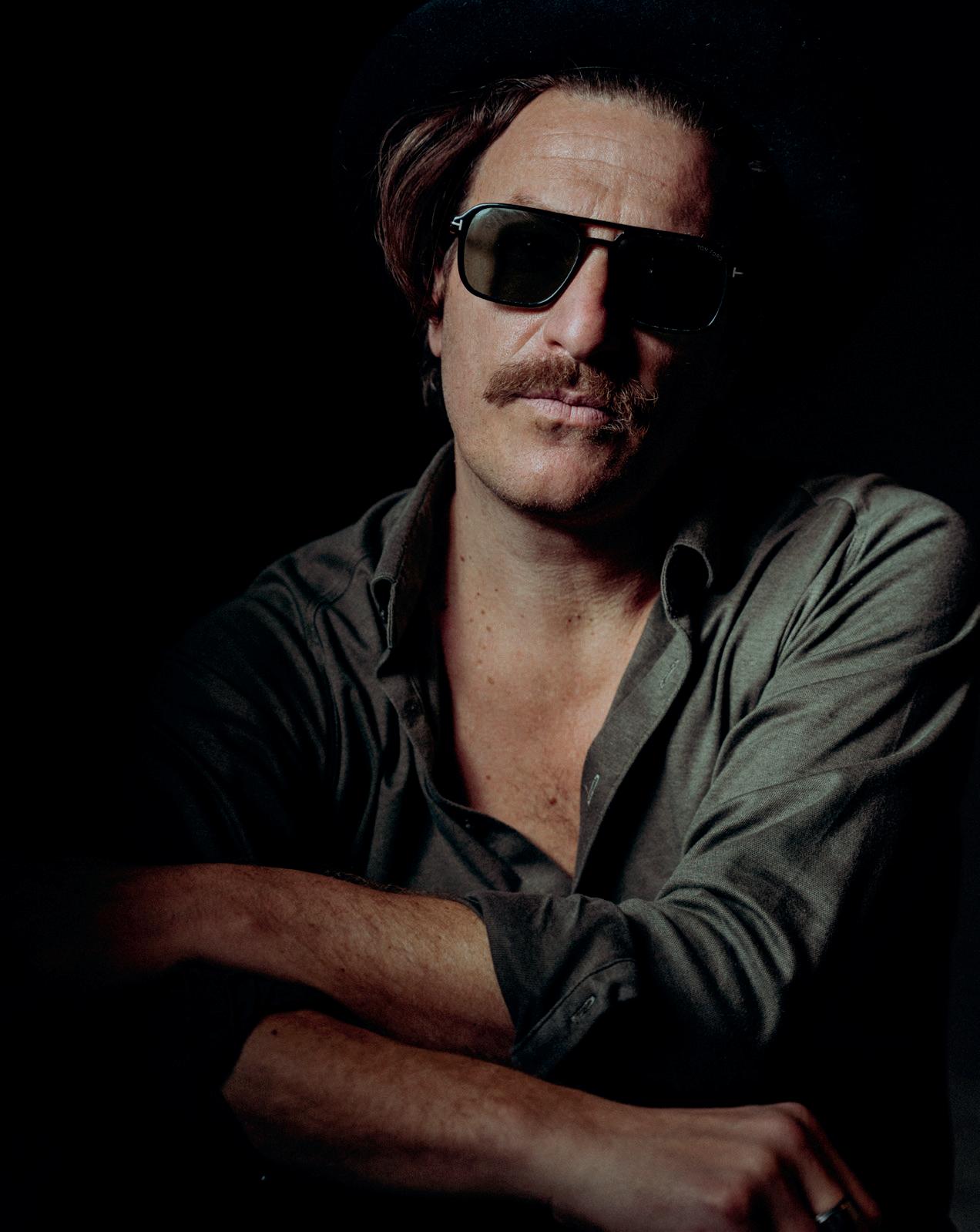


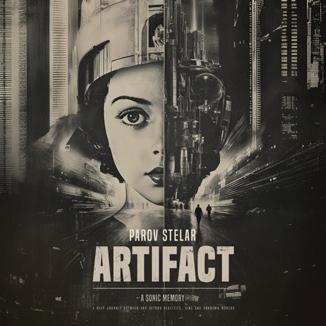
artistic ambitions with today’s music industry challenges?
PS: The industry today is completely different from when I began in the late ’90s. We live in a time where consumption is fast and often superficial, and everything is constantly under scrutiny, including musicians. To build a real fan base, you need to earn people’s trust, and that’s harder than ever in such a profitdriven environment. Successful formulas get repeated endlessly until they stop working, and then the artist is dropped. There’s little space for experiments.
I was fortunate to start at a time when I was allowed to experiment. My audience could grow with me, discover different sides of my music, and connect with my artistic evolution. Today, the conversation about what an artist actually stands for is often missing, which makes music feel more interchangeable and arbitrary. I’m grateful that my career has given me the freedom to experiment and follow my own ideas, without chasing the next hit or being afraid of making mistakes.
DG: Was there ever a moment when you thought: ‘This is it. I’ve made it’?
PS: No. I agree with Picasso, who said that he was afraid to ever finish a painting. For me, finishing means stopping. I don’t feel my creative journey has come to an end yet. Everything I’ve achieved so far is just a milestone. I’d be sad if one day I thought, ‘I’ve made it’. That would mean that my journey is over.
DG: Beyond being a musician, you’re also a painter. How do painting and music compare for you?
PS: I don’t see them as separate or comparable. I painted long before I started making music, and they inspire each other constantly. They are both my children. They’re like symbiotic twins that enrich one another. Often, while painting, a musical idea will come, and I’ll run upstairs to record it. And vice versa. Painting and music are equally important parts of my creativity.
DG: You have worked with huge names like Bryan Ferry, Lady Gaga and Lana del Rey. What was that like?
PS: Well, I was really honoured. And at first nervous of course. But once I’m in the creative process, nerves fade, and it’s about making the right artistic decisions. I’m an artist through and through. For me, it’s never about a particular person or celebrity, it’s always about the art. That might be part of my success: I’m authentic. If I can’t contribute anything meaningful, or if a track’s direction doesn’t feel right, I stop. Even if that costs me money. Art always comes first.
DG: You are currently on tour through Europe. How has it been so far?
PS: Fantastic! Thanks to my audience and fans, the energy at the shows has been incredible. I’m usually a very private person, so going on the stage is always a challenge. Also because I get an immediate reaction to my music, which can be overwhelming and deeply moving. There is a saying that love is happiness in action. I find that a live concert comes close to that.
Touring and live concerts for me are always a mix of love for the art, joy for the moments
Upcoming tour dates 2025:
3 November: Wiener Konzerthaus (Vienna, Austria)
4 November: Wiener Konzerthaus (Vienna, Austria)
13 November: Georg Elser Halle (Hamburg, Germany)
14 November: Uber Eats Music Hall (Berlin, Germany)
15 November: E-Werk (Cologne, Germany)
and pride in overcoming my natural shyness. An overall amazing experience. Even if travelling between gigs can be tiresome sometimes. I’m looking forward to the upcoming shows in Austria and Germany, which will keep me busy until the end of the year.
DG: Your new album Artifact is out on 14 November. What can you tell us about it?
PS: The singles Artifact, Rebel Love, Six Feet Underground and Shiver are already out and the response has been fantastic. Describing the new album is difficult. I’m definitely chartering new waters and showing a side that listeners haven’t seen yet. Artifact is driven by curiosity and a sense of wonder. I’m an organised person. I hate the unplanned. But for this project, I kept asking myself: ‘What happens if I try things in a different way?’ I welcomed the unplanned, the organic, the human side of creativity. I simply let things unfold and new ideas, images and sounds emerged. The album was recorded with a 35-piece orchestra, which added an incredible energy to the process. Honestly, I’m still so immersed in it that I find it hard to put into words. I’d rather let the listeners decide what it means to them.
DG: One last question: You’ve performed on stages worldwide. Is there a location you still dream of playing?
PS: Yes. Sweden and Ireland are still missing from the list, so I’d love to play there. And then, of course, there is the ultimate dream, the holy grail of music – Wembley Stadium in London! Playing there would be a once-in-alifetime experience.
www.parovstelar.com

Mumbai-based artist Shilpa Gupta is one of the most influential voices of contemporary media art. For the first time, her works are presented in a major solo exhibition in Germany.
Under the title we last met in the mirror, Kunsthalle St. Annen in Lübeck presents around 25 works by this year’s Possehl Prize for International Art laureate Shilpa Gupta, until 1 March 2026. The exhibition presents works that engage with some of the most pressing themes of our time: power and belonging, language and freedom of expression, and ultimately the question of how borders shape our lives.
Born in Mumbai in 1976, Shilpa Gupta’s art takes a stand against censorship and exclusion. Her works link the local with the global, are rooted in the social and political realities of South Asia while opening up to universal questions. “we last met in the mirror explores the many layers of perception and meaning-making, questioning the limits of fixed definitions in the ever-changing, fluid space we live in,” explains the artist.
The theme of borders is a recurrent theme in Gupta’s oeuvre. For example, she counts her steps between the Wailing Wall, the Al-Aqsa Mosque and the Church of the Holy Sepulchre in Jerusalem – a quiet mapping of religious

and political tensions. The result, 2652, shines in the exhibition as a neon sculpture. The work 1:14.9, a round sculpture made from threads, makes the border between India and Pakistan tangible in fragile materiality. Furthermore, Gupta invites visitors to take wax stars from her work Stars on Flags of the World: a poetic gesture against rigid affiliations and national symbols.
Gupta’s artistic investigations often draw on experiences and observations of life in Mumbai, a city where social and religious tensions, colonial histories and global dynamics intersect. The megacity becomes a focal point for
examining the complexities of coexistence within layered social, cultural and political contexts. In doing so, the artist raises fundamental questions about individual and collective freedom and belonging; questions of growing relevance across Europe today. “Shilpa Gupta works open spaces for dialogue and connect people across places, inviting them to reflect on their own histories in exchange with others,” emphasises Noura Dirani, director of Kunsthalle St. Annen.
The Possehl Prize for International Art, awarded every three years by the Possehl Foundation, is endowed with €25,000 and recognises outstanding figures in contemporary art worldwide. Here, Shilpa Gupta follows in the footsteps of Doris Salcedo (2019) and Matt Mullican (2022).
www.kunsthalle-st-annen.de www.possehl-stiftung.de
On the occasion of the awarding of the Possehl Prize for International Art 2025:
Shilpa Gupta | we last met in the mirror 27 September 2025 – 1 March 2026 Kunsthalle St. Annen, Lübeck
Die in Mumbai lebende Künstlerin Shilpa Gupta zählt zu den prägendsten Stimmen der zeitgenössischen Medienkunst. Erstmals sind ihre Werke in einer großen Einzelausstellung in Deutschland zu sehen.
Unter dem Titel we last met in the mirror präsentiert die Kunsthalle St. Annen in Lübeck noch bis 1. März 2026 rund 25 Werke der diesjährigen Possehl-Preisträgerin für Internationale Kunst. Ausgestellt sind Arbeiten, die sich den zentralen Themen unserer Zeit widmen: Macht und Zugehörigkeit, Sprache und Meinungsfreiheit und nicht zuletzt der Frage, wie Grenzen unser Leben prägen.
Shilpa Gupta, 1976 in Mumbai geboren, setzt in ihrer Arbeit Zeichen gegen Zensur und Ausgrenzung. Ihre Arbeiten verbinden das Lokale mit dem Globalen, nehmen Ausgang in den sozialen und politischen Realitäten Südasiens und öffnen sich zugleich universellen Fragestellungen. „we last met in the mirror untersucht die Vielschichtigkeit von Erkenntnis und Bedeutungsbildung und hinterfragt die Grenzen eindeutiger Definitionen in einem sich ständig verändernden, fluiden Raum, in dem wir leben“, erklärt die Künstlerin.
Das Thema der Grenzen zieht sich wie ein roter Faden durch Guptas Schaffen. Beispielsweise
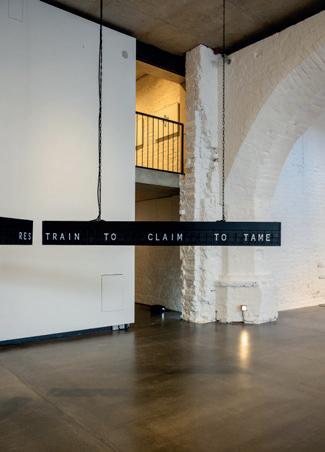

zählt sie ihre Schritte zwischen Klagemauer, AlAqsa-Moschee und der Grabeskirche in Jerusalem – eine stille Vermessung religiöser und politischer Spannungen. Das Ergebnis 2652 leuchtet als Neonskulptur in der Ausstellung. Das Werk 1:14.9, eine zu einem Ball gewickelte Fadenskulptur, hingegen macht die Grenzziehung zwischen Indien und Pakistan in fragiler Materialität greifbar. Darüber hinaus lädt Gupta Besucher:innen ein, von der Arbeit Stars on Flags of the World einzelne Wachssterne mitzunehmen: eine poetische Geste gegen starre Zugehörigkeiten und nationale Symbole.
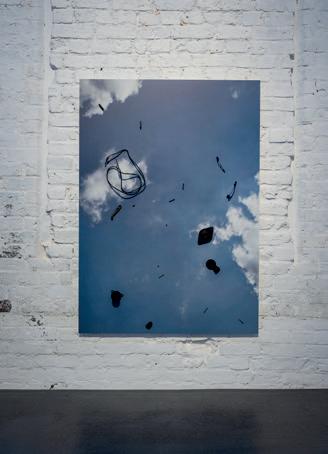
Ausgangspunkt von Guptas künstlerischen Auseinandersetzungen sind häufig Erfahrungen und Beobachtungen ihres Lebensortes Mumbai, einer Megacity, in der gesellschaftliche und religiöse Spannungen, koloniale Brüche und globale Dynamiken aufeinandertreffen. Ihre Heimatstadt wird zum Brennglas für das Zusammenleben in komplexen sozialen, kulturellen und politischen Strukturen und Fragen von individueller wie kollektiver Freiheit und Zugehörigkeit werden sichtbar –Themen, die auch Europa zunehmend herausfordern. „Shilpa Guptas Werke eröffnen Räume für Austausch und verbinden Menschen an unterschiedlichen Orten, um die eigene Geschichte im Dialog zu betrachten“, betont Noura Dirani, Direktorin der Kunsthalle St. Annen.
Der mit 25.000 Euro dotierte Possehl-Preis für Internationale Kunst wird alle drei Jahre von der Possehl-Stiftung an herausragende Vertreter:innen der internationalen Gegenwartskunst verliehen. Shilpa Gupta folgt damit auf Doris Salcedo (2019) und Matt Mullican (2022).
www.kunsthalle-st-annen.de www.possehl-stiftung.de
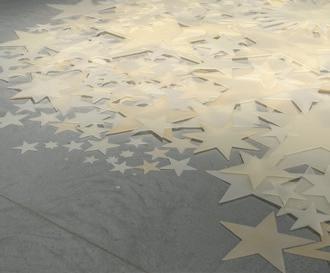
Stars on Flags of the World 2012/2023 in Wachs gegossene Sterne im Verhältnis zum Volumen des Körpers des Künstlers, Maße variieren Courtesy: the artist © Shilpa Gupta Foto: Sebastian Bach
Anlässlich der Verleihung des PossehlPreis für Internationale Kunst 2025: Shilpa Gupta | we last met in the mirror 27.09.2025 – 01.03.2026 Kunsthalle St. Annen, Lübeck
For many years, the Grand Classic Ballet has enchanted audiences with its traditional winter tour across Germany. For many ballet enthusiast, it has become a cherished part of the pre-Christmas season. From mid-November to the end of January, the great classics The Nutcracker and Swan Lake fill theatres from north to south, east to west and bring sparkle and magic.
What began as an ensemble idea has grown into a true tradition, reaching its peak this season: with a record-breaking 181 performances in 48 cities, the 2025/26 tour is the biggest in the Grand Classic Ballet's history.
The performances are not just about breaking records. Every year, the tour is a journey into people's hearts, into the diversity of cities, a meeting of culture and audience. For
many families, an evening with the Grand Classic Ballet has become as much a part of the Advent season as the wreath, story time, or Christmas music with the family. “Each year, the company's dancers are thrilled to bring their art into new locations, to absorb the energy of different places, and always bring a piece of the well-known and ballet history to the stage,” says project manager Maria Berns.
Seit vielen Jahren zieht das Grand Classic Ballet mit seiner traditionellen Wintertournee durch Deutschland und hat sich längst zu einem festen Bestandteil der Vorweihnachtszeit entwickelt. Von Mitte November bis Ende Januar füllen die großen Klassiker Der Nussknacker und Schwanensee die Theater in Nord und Süd, Ost und West mit Glanz und Magie.
Was als Ensembleidee begann, ist zu einer echten Tradition geworden, die in dieser Saison ihren Höhepunkt erreicht: Mit rekordverdächtigen 181 Aufführungen in 48 Städten ist die Tour 2025/26 die größte in der Geschichte des Grand Classic Ballet.
Doch es geht bei den Aufführungen nicht allein um Rekorde: Jedes Jahr aufs Neue ist die Tournee eine Reise in die Herzen der Menschen, in die Vielfalt der Städte, eine Begegnung von Kultur und Publikum. In-
zwischen gehört ein Abend mit dem Grand Classic Ballet für viele Familien genauso selbstverständlich zur Adventszeit wie der Adventskranz, Märchenstunden oder Weihnachtsmusik im Familienkreis. „Die Tänzerinnen und Tänzer der Companie sind jedes Jahr erneut begeistert, ihre Kunst in immer wieder neue Räume zu tragen, die Energie fremder Orte aufzunehmen und dabei doch stets ein Stück Heimat und Ballett-Geschichte auf die Bühne zu bringen“, erzählt Projektmanagerin Maria Berns.


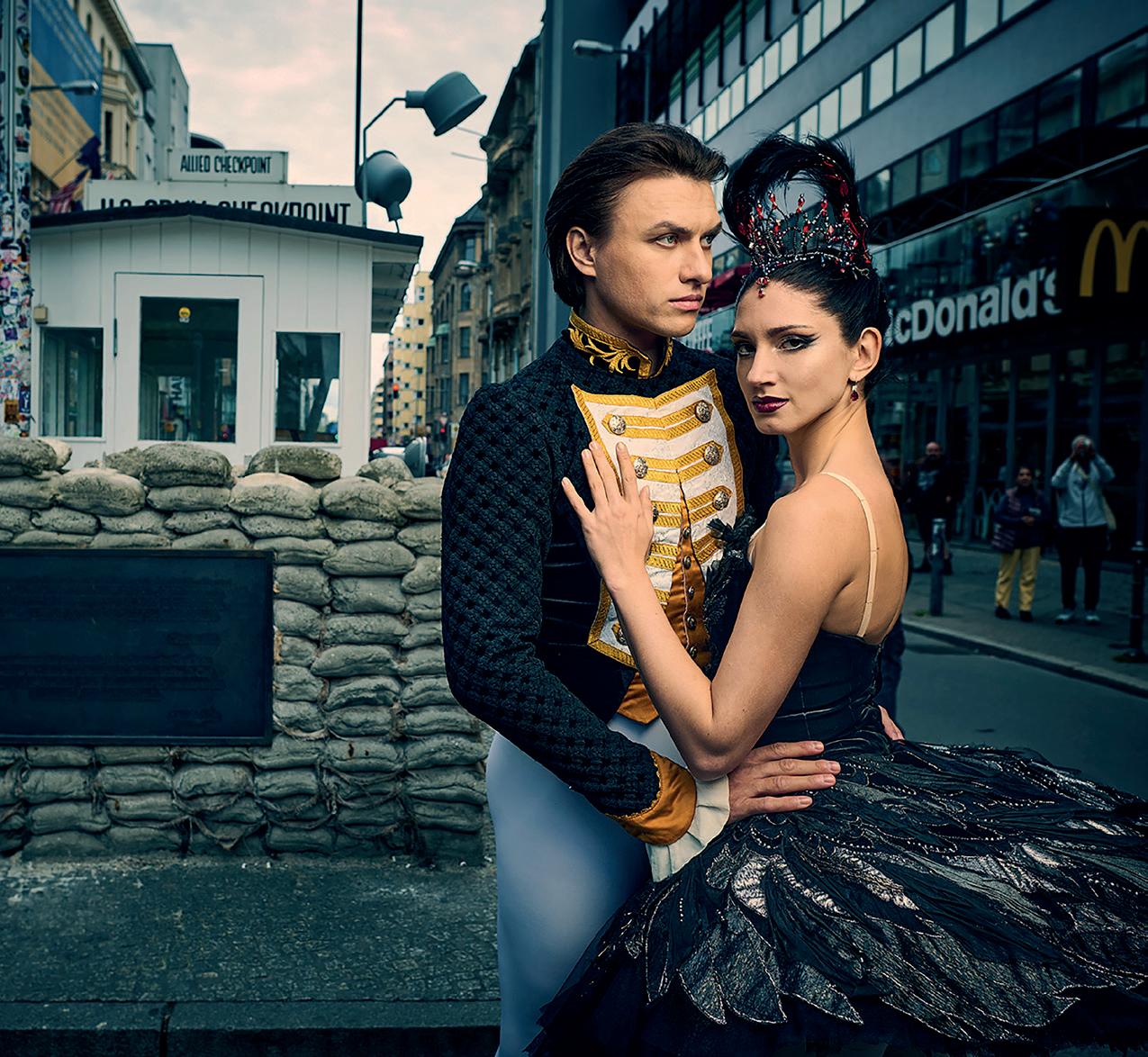


To showcase this special feeling beyond the theatre, the company has created a remarkable new photo series in Berlin that uniquely connects tradition and modernity, the stage and the street. Berlin’s city centre, as representative for other German cities, serves as a backdrop for an extraordinary artistic encounter: classical ballet icons step out of their familiar world and move through the streets of our modern world.
Suddenly, it becomes possible to encounter the Nutcracker not just in the theatre but against the silhouette of a metropolis. Odette

Um dieses besondere Gefühl auch außerhalb der Theater zu zeigen, hat die Compagnie in Berlin eine herausragende neue Fotoserie geschaffen, die Tradition und Gegenwart, die Bühne und die Straße auf ungewöhnliche Weise miteinander verbindet. Die Stadt Berlin dient dabei stellvertretend für die verschiedenen Städte Deutschlands als Kulisse für eine künstlerische Begegnung der besonderen Art: Ikonen des klassischen Balletts treten aus ihrer gewohnten Welt heraus und bewegen sich mitten im Straßenleben unserer modernen Welt.
Plötzlich begegnet man dem Nussknacker nicht nur im Theater, sondern vor der Silhouette einer Metropole. Odette tanzt nicht am Schwa-
no longer dances by a swan lake but between the facades of a big city. The mysterious black swan seems to glide through underground train shafts, while a corps de ballet moves fairy tale-like across squares that are otherwise occupied by real-life people. “Figures from the world of ballet leave the stage and step into reality – a magical interplay between fantasy and reality,” says Maria Berns about the series.
Visually, the photo series is almost cinematic: classic costumes and characters appear in urban landscapes, creating a tension that does not highlight opposites, but builds bridges.
Here, the festive touches the mundane, the timeless touches the fleeting. It is a dialogue that captures the essence of travel: being on the road, discovering new horizons, and yet staying true to oneself.
The series shows what the tour itself is all about: the constant interplay between the familiar and the new. Although the same ballet classics are at the centre of each year’s tour, no performances and no cities are alike. “There's magic in every new encounter, a fresh perspective in every backdrop,” says Maria Berns. It is precisely this contrast between the beauty of tradition and their reflection in the present that makes the winter tour so special.

nensee, sondern zwischen den Fassaden einer Großstadt. Der geheimnisvolle schwarze Schwan scheint durch U-Bahn-Schächte zu gleiten, während ein Corps de Ballett märchenhaft über Plätze wandelt, die man sonst nur aus dem realen Alltag kennt. „Die Figuren der Ballettwelt verlassen die Bühne und treten hinaus in die Wirklichkeit – ein magisches Spiel zwischen Fantasie und Realität“, sagt Maria Berns über die Bilderserie.
KLASSIK KOMBINIERT MIT MODERNE: BILDERSERIE REFLEKTIERT DEN KERN DER TOURNEE
Visuell ist die Fotoserie fast filmisch inszeniert: Klassische Kostüme und Figuren erscheinen in urbanen Landschaften, und es entsteht eine Spannung, die nicht etwa Gegensätze betont, sondern Brücken schlägt. Hier berührt das Festliche das Alltägliche, das Zeitlose das Flüchtige. Es ist ein Dialog, der die Essenz des Reisens einfängt: unterwegs sein, neue Horizonte entdecken und sich selbst doch treu bleiben.
Die Serie zeigt damit, was die Tournee selbst ausmacht: das ständige Wechselspiel zwischen dem Vertrautem und dem Neuem. Zwar stehen jedes Jahr die gleichen Werke im Mittelpunkt, doch ist keine Aufführung und keine Stadt wie die nächste. „In jeder Begegnung steckt ein neuer Zauber, in jeder Kulisse ein frischer Blickwinkel“, so Berns. Genau dieser Kontrast der Schönheit der Tradition im Spiegel der Gegenwart macht die Wintertournee so besonders.

In the photo series and on stage, the Grand Classic Ballet celebrates the same value: the joy of sharing culture with others. During the winter tour, every city becomes a part of this dialogue. Each performance is not just a show, but an invitation to the audience to be amazed, to dream, and to rediscover ballet time and again.
With 181 performances in 48 cities, the upcoming season will not only be a logistical masterpiece but, above all, a celebration of togetherness. For the company, one thing is clear: “Traditions only live on if they are constantly reborn.” Thus, every Grand Classic Ballet winter tour becomes a ritual that connects: artists and audience, past and present, the stage and the world.
Would it not be wonderful to walk through the city and suddenly think a ballerina might just float around the corner? If so, the Grand Classic Ballet's photo series has achieved exactly what the tour aims to do: to make the magic of classical ballet tangible everywhere.
Das Grand Classic Ballet feiert in Bildern und auf der Bühne dasselbe Thema, nämlich die Freude, Kultur mit anderen zu teilen. Jede Stadt, in der die Tournee Halt macht, wird ein Teil dieses Dialogs. Jede Vorstellung ist nicht nur eine Aufführung, sondern auch eine Einladung an die Zuschauer zu staunen, zu träumen und das Ballett immer wieder neu zu entdecken.
WINTERLICHE DEUTSCHLANDTOUR: VORSTELLUNGEN IN 48 STÄDTEN
Mit 181 Vorstellungen in 48 Städten wird die kommende Saison nicht nur eine logistische Meisterleistung, sondern vor allem ein Fest des Miteinanders. Für die Companie ist klar: „Tradition lebt nur dann weiter, wenn sie immer wieder neu geboren wird.“ So wird jede Wintertournee des Grand Classic Ballet zu einem Ritual, das verbindet: Künstlern und Publikum, Vergangenheit und Gegenwart, die Bühne und die Welt.
Wäre es nicht schön, wenn man bei einem Spaziergang durch die Stadt geht und plötzlich den Gedanken hat, dass vielleicht gleich eine Ballerina um die Ecke schweben könnte? Dann hat die Fotoserie des Grand Classic Ballet genau das erreicht, was auch die Tournee erwirken möchte: die Magie des klassischen Balletts überall spürbar zu machen.

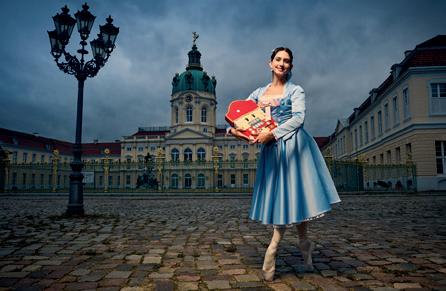

www.grandclassicballet.com
Instagram: @grandclassicballet

18-23 November
Oberhausen, Metronom Theater 29 November - 3 December
Munich, Showpalast 16-19 December
Cologne, Maritim Hotel 22-26 December
Berlin, Uber Eats Music Hall 20-23 December
Duisburg, Theater am Marientor 25-28 December
Bremen, Metropol Theater 13-18 January
Munich, Cuvillies Theater
And in many other cities...
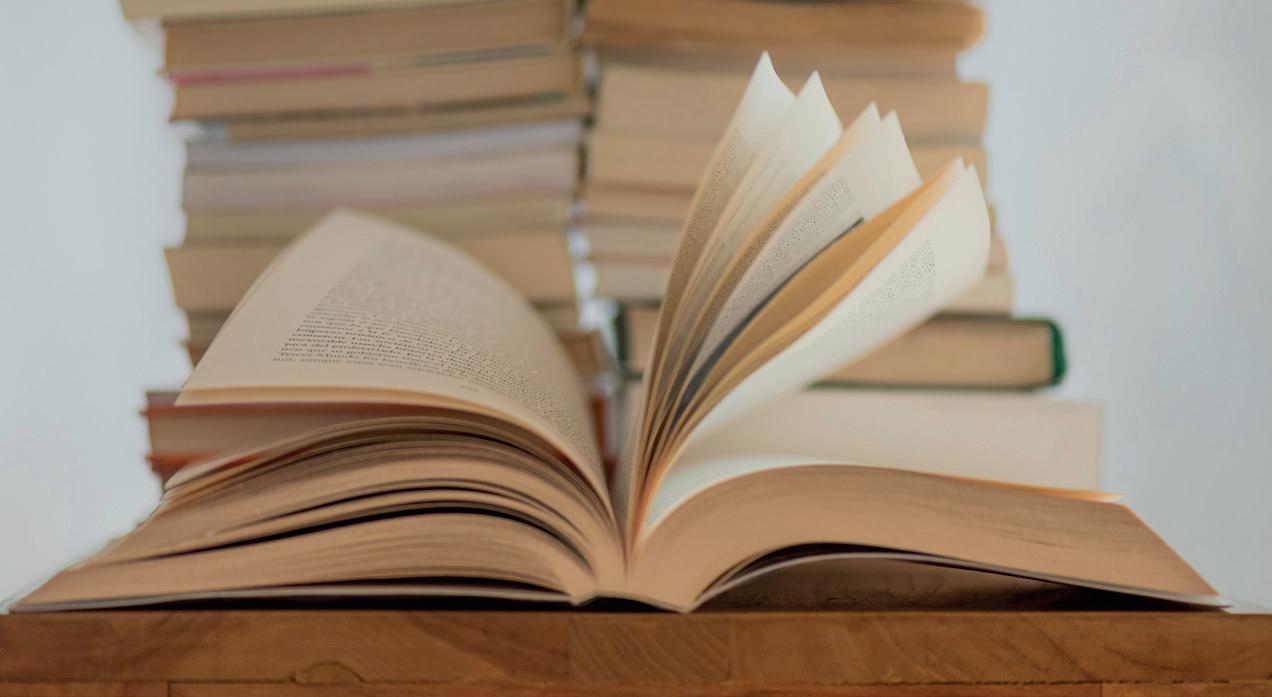
From visionary authors to innovative publishers, the German-speaking book scene is coined by authors whose imaginative power and expertise continue to inspire, educate and transform literary landscapes. In the following special theme, join us as we delve deeper into the stories, ideas and creative minds shaping Germany’s book scene.

Gökan Isik bietet authentisch-poetische Einblicke in Gefühlswelten, die sonst oft übersehen werden – für Menschen, die auch hinter die Fassade schauen.
„Meine Bücher sind roh, ehrlich und ungeschönt“, erklärt der Autor. „Sie sprechen Dinge aus, die oft verschwiegen werden –Gefühle von Anderssein, Neurodivergenz, gesellschaftlicher Druck – aber auch Liebe, Wut, Zynismus und Verletzlichkeit.“
Isik begann schon früh damit, Gedanken aufzuschreiben – zunächst als Selbstgespräch und Ventil „Richtig ernst wurde es, als ich merkte: Das, was ich mit mir selbst bespreche, bewegt auch andere.“ Seine Leser:innen sind Menschen, die sich in den eher stillen Ecken des Lebens wiederfinden: „Sogenannte Außenseiter, Nachdenker oder Menschen mit Neurodivergenz – und Leser:innen, die mutig genug sind, hinter die Fassade zu schauen.“
Für 2026/27 plant Isik, seine Reihe durch weitere Bände zu ergänzen. Parallel arbeitet er an einem multimedialen Universum für seine Geschichten: Bücher, Musik und visuelle Inhalte sollen ineinandergreifen und so ein noch dichteres Erlebnis für die Leser:innen schaffen. „Ich schreibe nicht, um perfekt zu klingen, sondern um authentisch zu sein. Jede Seite ist ein Spiegel meiner inneren Welt, die sonst niemand hört – deswegen rede ich mit mir selbst.“
Das Poesie-Werk Keiner hört zu - Also red ich mit mir selbst ist seit September im Buchhandel erhältlich.
www.echoabenteuer-verlag.de

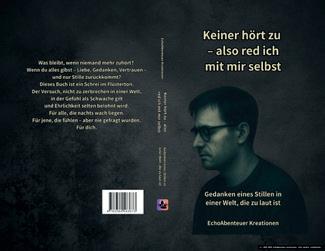
Von Werbung über Exposés bis hin zu Romankorrekturen aller Art – bei Svenja Bartsch ist jeder Text in guter Hand.
„Dadurch, dass ich zwei verschiedene Korrektorate anbiete, können die Kunden individuell entscheiden, was genau sie für ihr Projekt brauchen“, erklärt die Korrektorin. So können neben Rechtschreibung und Grammatik auch zusätzliche Feinheiten, wie z.B. das Kontrollieren der Menge an Füllwörtern oder Wortwiederholungen problemlos mitberücksichtigt werden – ganz gleich für welchen Text: „Neben Romankorrekturen biete ich auch Korrekturen für Werbe- und Webseitentexte, Leseproben, Exposés, Bewerbungen und Hausarbeiten an.“
Svenja Bartsch hatte schon während der Schulzeit viel Spaß am Schreiben: „2020 habe ich meinen ersten Roman veröffentlicht und während der Pandemie meine Deutschkenntnisse weiter vertieft. 2022 fiel
dann die Entscheidung, in diesem Bereich auch Dienstleistungen anzubieten.“
Ihren ersten Korrekturauftrag erhielt Bartsch für das Kinderbuch Veit, der Feuerspucker von Helen E. Wolf. Es folgten verschiedene Romance- und Krimiautoren, u.a. Michèle Friedrichs mit ihrer Reihe Fräulein Charot. Doch es kamen auch Studenten mit Haus- und Bachelorarbeiten: „Es sind grundsätzlich alle willkommen, die Unterstützung für ihren Text oder ihr Werk brauchen!“
Für Anfang 2026 stehen bereits mehrere Projekte von Lilyana Ravenheart sowie eine Masterarbeit auf dem Programm. Weitere Termine sind noch zu vergeben. Bei Interesse können diese über das Kontaktformular, per E-Mail an sv-bartsch@web. de oder ganz bequem über Instagram unter
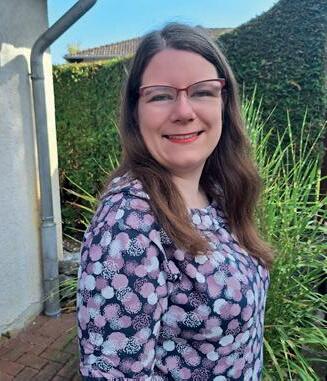
@korrektorat_svenjabartsch angefragt werden.

www.svenjabartschautorin.wordpress.com/ svenja-bartsch-textkorrektur

„Heilung für die Seele“ – mit ihrer Plattform hat Johanna Hess einen Ort geschaffen, der Frauen dazu einlädt, innezuhalten, nach Innen zu lauschen und sich selbst daran zu erinnern, dass Heilung Zeit braucht. Ihre Angebote sind bewusst als Selbstlernkurse gestaltet – Frauen können sie in ihrem eigenen Tempo und ganz in Ruhe zu Hause durchlaufen.
Die Themen reichen von Trauerbewältigung über mehr Selbstwertgefühl bis hin zu erfüllteren Partnerschaften. Gerade Frauen stehen oft unter dem Druck, allem gerecht werden zu müssen, und verlieren dabei sich selbst. Johanna Hess verbindet in ihrer Arbeit Psychologie mit Spiritualität und sagt: „So kreiere ich einen Raum, in dem Frauen sich selbst neu begegnen dürfen. Meine Kurse sind lebendige Erlebnisse, die Herz und Sinne ansprechen.“
DIE EIGENEN ERLEBNISSE BEEINFLUSSEN
DIE ARBEIT UND INHALTE DER SELBSTLERNKURSE
Geprägt ist ihr Weg von eigenen Erfahrungen mit Verlust und Neuanfang. Bereits
Anfang zwanzig begleitete sie ihren Vater bis zu seinem Krebstot. Später wurde ihre Mutter plötzlich zum Pflegefall, sie selbst erlebte Burnouts, finanzielle Unsicherheit, Mobbing – und wurde über Nacht zur Witwe. „Doch gerade durch diese Tiefen habe ich gelernt, wie Heilung von innen wächst“, sagt sie. „Darum weiß ich genau, wovon ich in meinen Selbstlernreisen spreche.“
In unserer schnellen Welt voller Erwartungshaltungen und Druck fällt es vielen schwer, auf die eigene Stimme zu hören. Doch Themen wie innere Ruhe, Selbstwert und Loslassen sind lebenswichtig. „Meine Kurse verbinden psychologische Klarheit, spirituelle Tiefe und praktische Übungen. Wer mit mir
arbeitet, trifft auf eine Begleiterin, die nicht belehrt, sondern erinnert – und mit Herz und Achtsamkeit an deiner Seite geht.“
NEUER RATGEBER FÜR FRAUEN: INNERE UND ÄUSSERE ORDNUNG FÜR MEHR HARMONIE
Auch das äußere Umfeld spielt eine Rolle für das innere Gleichgewicht. In ihrem Ratgeber Aufräumen – Wie du dein Zuhause von Chaos in Harmonie verwandelst zeigt Johanna Hess, wie äußere Ordnung und innere Ruhe Hand in Hand gehen. „Raum schaffen bedeutet, Heilung zu ermöglichen“, fasst sie zusammen.
Mehr unter: www.heilung-für-die-seele.de

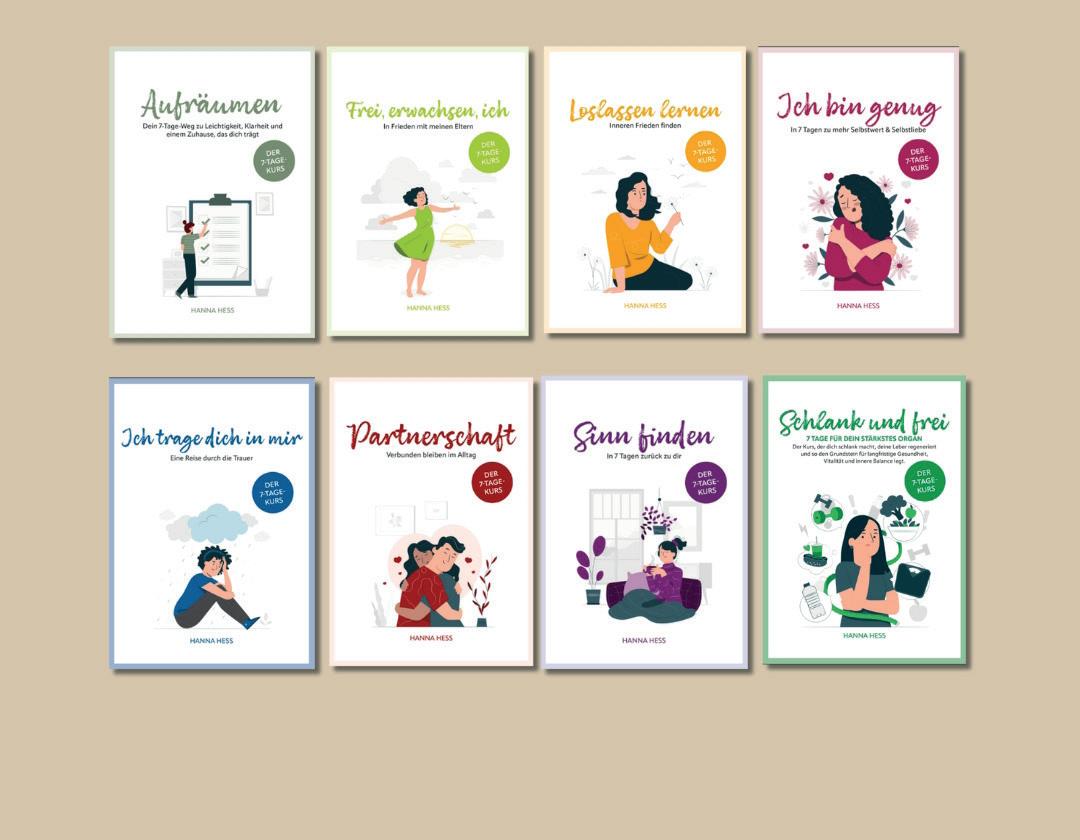
(Zu innerem Frieden, neuer Kraft und innerer Balance.) Website:




Elmar Wieland Vogel is a sculptor, poet, songwriter, author and blogger. Rooted in generations of artistic tradition, he brings together craftsmanship, creativity and philosophy. Through his blog, he conveys the timeless meaning of Jesus’ message in a non-dogmatic way.
Already during his training with his father, a formally trained sculptor, Elmar Vogel was immersed in visual language and symbolism. His family has been working in crafts and the arts for six generations – a tradition that shaped him and eventually led to his involvement in major projects such as the reconstruction of Dresden’s Frauenkirche.
Inspired by thinkers such as Meister Eckhart, Spinoza and Simone Weil, Vogel engages deeply with the Old and New Testament. From a collection of reflections on the Sermon on the Mount came his book Essences – The Message of Jesus. “My aim is to make Jesus’ timeless message comprehensible and accessible beyond church dogma,” he explains. “I want to offer a clear and convincing
picture of his teaching, something I often find lacking in established faith communities.”
His writings focus on central questions: Why does Jesus encourage self-reflection rather than judging others? What do guilt and forgiveness mean outside of ritual practice? What relevance can the crucifixion of an innocent man two thousand years ago have for us today? Vogel also repeatedly returns to the problem of theodicy: the question of why God allows suffering.
Since 2019, his reflections on Christian philosophy appear regularly on his blog CHRISTOPHILOS, alongside poetry, prose and songs. Writing from a position of authenticity and beyond denominational bounda-
ries, he seeks not only to stimulate thought but also to move his readers. “Authenticity is what matters to me, what people once called truthfulness,” says the sculptor and author. “My attention is on what is genuine, grounded and timeless. Authenticity is at the heart of all creative expression that has value and permanence.”
Vogel sees his interpretations as a form of practical guidance, helping people in their search for meaning. He is currently working on a new book on Christian philosophy, expanding and deepening the ideas he has developed so far.
Elmar Vogel remains an artist and thinker who connects old traditions with lasting relevance: open, concrete, non-denominational, and always faithful to the essence of Jesus’ message.
www.christophilos.de
Elmar Wieland Vogel ist Bildhauer, Lyriker, Liedermacher, Autor und Blogger. Seit Generationen in der Kunst verwurzelt, verbindet er Handwerk mit Kreativität und Philosophie. Auf seinem Blog macht er die zeitlose Bedeutung der Botschaft Jesu auf undogmatische Weise erfahrbar.
Bereits während seiner Ausbildung bei seinem Vater, einem studierten Bildhauer, kam Elmar Vogel mit Bildsprache und Symbolik in Berührung. Die Familie ist seit sechs Generationen handwerklich und kunstschaffend tätig – eine Tradition, die ihn prägte und die unter anderem dazu führte, dass er an so namhaften Projekten wie dem Wiederaufbau der Dresdner Frauenkirche mitwirkte.
Inspiriert von Denkern wie Meister Eckhart, Spinoza und Simone Weil setzt sich Elmar Vogel tief mit den Inhalten des Alten und Neuen Testaments auseinander. Aus einer Textsammlung zur Bergpredigt, entstand sein Buch Essenzen – die Botschaft Jesu „Mein Antrieb ist, die zeitlose Botschaft Jesu jenseits kirchlicher Dogmatik verständlich und zugänglich zu machen“, erklärt er. „Ich möchte ein plausibles, Bild seiner Lehre vermitteln, etwas, das ich in etablierten Glaubensgemeinschaften vermisse.“
In seinen Veröffentlichungen widmet er sich zentralen Fragen: Warum rät Jesus zur
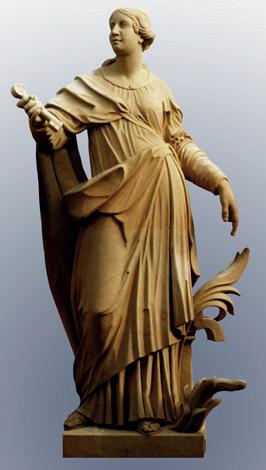
Selbstreflexion statt zum Verurteilen anderer? Was bedeutet Schuld und Vergebung abseits ritueller Handlungen? Welche Bedeutung kann der Kreuzestod eines Unschuldigen vor 2000 Jahren für uns überhaupt haben? Auch die Theodizeefrage, also warum Gott Leid zulässt, ist ein Leitmotiv seiner Ausführungen.
Seit 2019 erscheinen seine Beiträge zur christlichen Philosophie regelmäßig auf dem Blog CHRISTOPHILOS, ergänzt durch lyrische Texte, Prosa und Lieder. Überkonfessionell und aus einer Haltung der Authentizität heraus möchte er dort nicht nur Denkanstöße geben, sondern auch berühren. „Mir liegt Authentizität am Herzen – das, was früher als Wahrhaftigkeit bezeichnet wurde“, erzählt der Bildhauer und Autor. „Dem, was echt, begründet und zeitlos ist, gilt meine Aufmerksamkeit. Authentizität ist der Kern allen kreativen Ausdrucks von Wert und Bestand.“
Seine Auslegungen versteht er als konkrete Lebenshilfe, die Menschen auf ihrer Suche
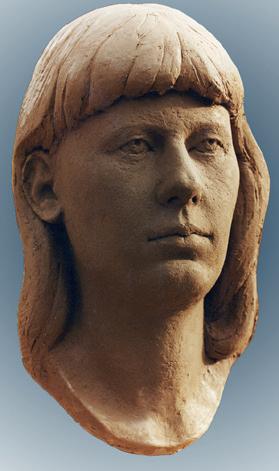
nach Sinn begleiten sollen. Derzeit arbeitet er an einem neuen Buchprojekt zur christlichen Philosophie, das seine bisherigen Gedanken vertieft und erweitert.
So bleibt Elmar Vogel, ein Künstler und Denker, der alte Traditionen mit zeitloser Relevanz verbindet: offen, konkret, überkonfessionell und dabei stets dem Kern der Botschaft Jesu verpflichtet.
www.christophilos.de
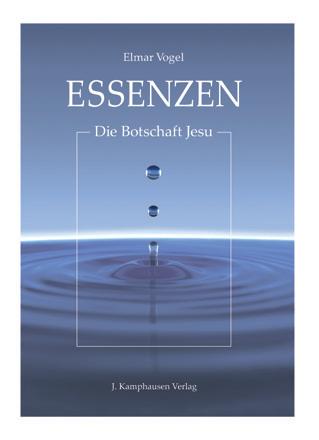
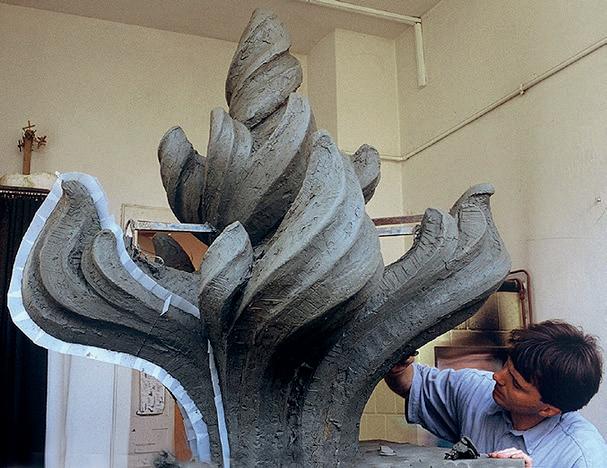
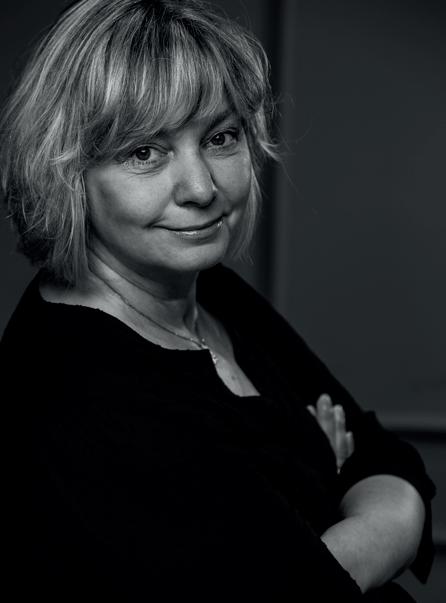


Katie McLanes Liebesromane reichen von sanftem Prickeln über intensive Leidenschaft bis hin zu überwältigendem Verlangen – und treffen mit ihren Emotionen mitten ins Herz, bis zum Happy End.
„Ich habe immer viel gelesen und mir schon als Teenager Geschichten ausgedacht“, erinnert sich McLane, „dabei habe ich diverse Genres ausprobiert und mein Thema gefunden: die Liebe.“ Hauptberuflich war die Romance-Autorin bis 2023 im Personalbereich tätig, auch als Abteilungsleiterin, doch ihre Leidenschaft blieb das Schreiben. 2016 besuchte sie einen Kurs für Kreatives Schreiben, wo sie vom Selfpublishing erfuhr. Der erste Roman wurde unter dem Pseudonym Sontje Beermann veröffentlicht, danach folgten drei Titel im Verlag.
DURCHBRUCH IM SPICY ROMANCE-SEKTOR
„2019 wagte ich mit Katie McLane und Spicy Romance in amerikanischem Setting einen neuen Schritt und erzielte 2022 den Durchbruch.“ Seitdem finden sich Katie McLaneRomane regelmäßig in den Erotik-Best-
sellerlisten der Buchhandel-Onlineshops, manchmal sogar an deren Spitze, inklusive tolino eBook Bestseller-Button, „weshalb ich 2024 auch Teil der ersten KreuzfahrtLesereise der ‚Nr. 1 im Premium-All-inclusiveSegment‘ war.“
Leserinnen von Katie McLane-Romanzen sind Frauen zwischen 18 und 65 Jahren, die in mitreißende, emotionale Liebesgeschichten eintauchen und dabei auch sinnliche Szenen genießen möchten: „Es sind Geschichten, in denen sich die Charaktere auf Augenhöhe begegnen. Egal, ob cozy, contemporary, extra heiß, dramatisch oder dark.“ Zu erstehen sind die Bücher als Print, E-Book oder Hörbuch.
NEUER LOOK UND NEUE SERIEN
Neuerungen geben, zum Beispiel die Printausgaben als elegantes Paperback mit Farbschnitt, Cover-Innendesign sowie Spicy Page Overlay: „Schon am ersten Januar erscheint mein 50. Buch, der Auftakt zu einer neuen Reihe rund um die zauberhafte Kleinstadt North Haven an der Küste Maines –wo Miteinander, Hilfsbereitschaft und die Liebe zu Hause sind.“ Ende Februar startet eine Sports-Romance-Reihe rund um ein New Yorker Football-Team und danach folgt die Trilogie Sins of Power: „Da ist der Name Programm.“
Wie jedes Jahr gibt es auch ein Weihnachtsbuch – McLanes heimliche Leidenschaft –und zum Jahreswechsel erscheint eine weitere neue Reihe: New Adult – spicy, aber mit Charme: „Mein Herz schlägt für starke Heldinnen und Männer, die nicht nur für Herz-
Im September 2026 feiert die Autorin ihr 10jähriges Jubiläum und es wird einige klopfen sorgen. Deshalb schreibe ich Romance –für alle Sinne.“
www.katie-mclane.de

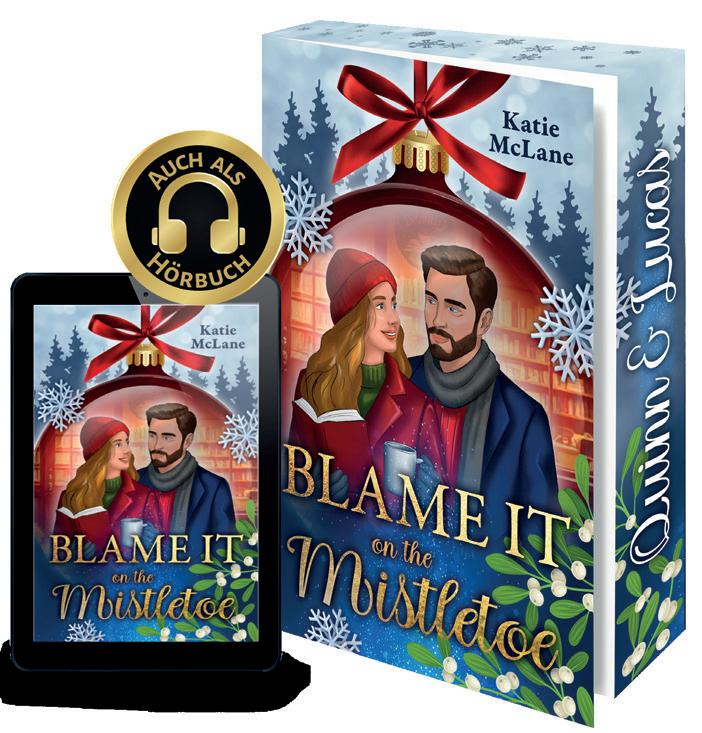
Ein charmantes Buch-Café, ein CEO mit großen Plänen und ein Kuss, der alles verändert.
“Delaney’s Books & Brews” ist mehr als nur ein Coffeeshop mit Büchern. Es ist Heimat, Rückzugsort, ein Teil Torontos. Nun soll es einem seelenlosen Shopping-Komplex weichen.
Ich dürfte darin zwar ein Lokal eröffnen, aber angepasst an deren Konzept, glattgebügelt und beliebig. Ohne Seele und Magie? Oh, nein, nicht mit mir!
Weil ich den Verkauf ablehne und das Projekt blockiere, reist der CEO der New Yorker Investmentfirma persönlich an. Ausgerechnet in der Vorweihnachtszeit.
Perfektes Timing, um ihm mit “Christmas Mocha”, Geschichten und einem Hauch Weihnachtszauber zu zeigen, dass Herz wichtiger ist als Profit.
Allerdings taucht kurz vor seiner Ankunft ein Amerikaner in meinem Café auf – charmant, aufmerksam, viel zu attraktiv. Und der Kuss unter dem Mistelzweig bringt alles ins Wanken.
Nur ahne ich da noch nicht, wer er wirklich ist.
Eine

Buchverrückt, hoffnungslos romantisch und ein bisschen weihnachtsverliebt. Ihre Christmas-Romance-Geschichten handeln von starken Heldinnen und Männern, die nicht nur für Herzklopfen sorgen. Dazu eine Prise Spice und ein Happy End. Die perfekte Lektüre für einen gemütlichen Tag auf der Couchbis zum letzten Wohlfühlmoment.
Mehr Spicy Romance unter www.katie-mclane.de
Überall erhältlich als Paperback mit Farbschnitt, E-Book und Hörbuch.
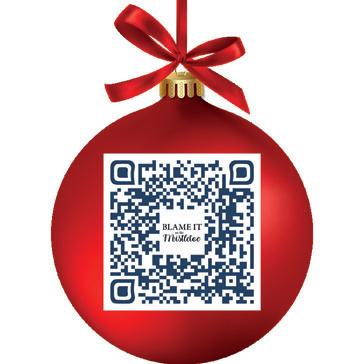



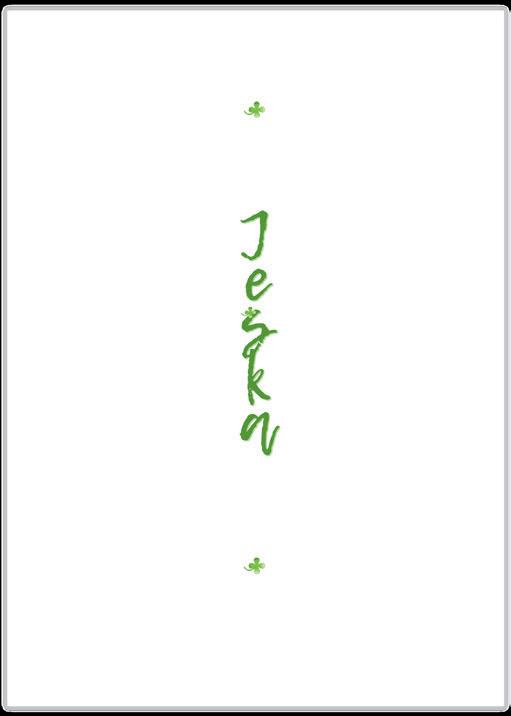




www.jeska.online In the woods or in your dreams, let kindness be you r guide, A nd just like Jeska, find joy with friends by your s ide.

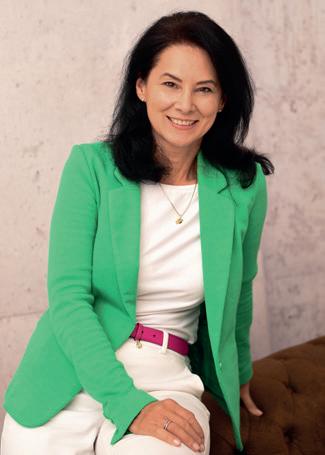
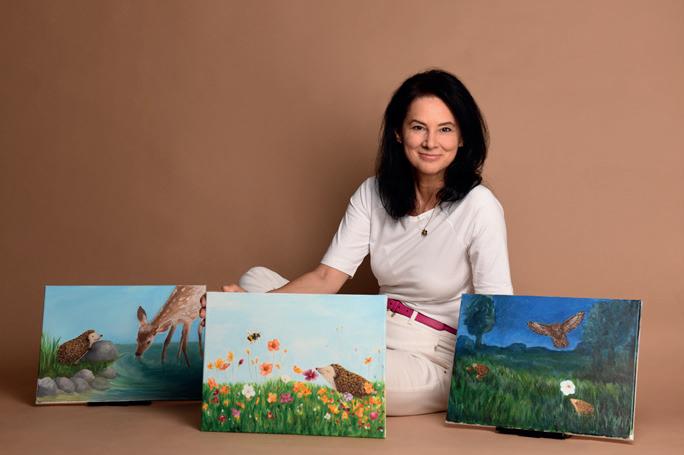
Kindness, friendship, and respect are the core messages of Vesna Blötz's new children's book: Jeska – The Lucky Hedgehog. Published in English and German and suitable for children from the age of two, the board book comes to life through the author’s colourful illustrations – images that invite discovery, naming animals, and shared storytelling.
A real-life encounter sparked the idea for the debut children's book. “Unexpectedly in 2020, a tiny baby hedgehog in distress came into my life,” explains author Vesna Blötz. “This 68-gram wonder needed hourly feeding, travelled everywhere with me in a box, and quickly became part of my daily routine. I grew incredibly fond of it.” This fondness led to the first hedgehog illustration. “After that, I sketched more scenes, imagining how Jeska enjoys life in nature and encounters other animals in the forest.” From memory and imagination, a whole illustrated world unfolded.
“Colours make me happy; they are the language I use to express the world,” says Vesna. For her book, the artist painted animals true to life, so that young readers can easily recognise them in the wild. “No pink cats, no blue horses – just authentic colours, real shapes, and genuine potential encounters."
Vesna carefully observes every detail, adding loving touches and creating images that allow children to feel a connection with nature. The author is already excited to capture Jeska's next adventures. Who knows where the little hedgehog's next journey will lead? In spring 2026, Jeska will be ready for new discoveries in nature.
www.jeska.online
Güte, Freundschaft und Respekt – das sind die Botschaften des neuen Kinderbuchs von Vesna Blötz: Jeska – Das glückliche Igel-Mädchen. Erschienen auf Deutsch und Englisch richtet sich das Pappbilderbuch an Kinder ab zwei Jahren und lebt von den farbenfrohen Illustrationen der kunstbegeisterten Autorin. Illustrationen, die zum Entdecken, Benennen und gemeinsamen Erzählen einladen.
Die Idee zum Debüt-Kinderbuch entstand aus einer Begegnung im wahren Leben: „Ein kleines, in Not geratenes Igelbaby zog in 2020 in mein Leben“, erzählt Autorin Vesna Blötz. „Dieses 68-Gramm-Wunder musste alle paar Stunden gefüttert werden, reiste im Karton mit mir durch den Alltag, wurde schnell Teil meines täglichen Lebens und wuchs mir unendlich ans Herz.“ Aus dieser Verbundenheit entstand das erste Igelbild. „Danach skizzierte ich weitere Szenen und stellte mir vor, wie Jeska das Leben in der Natur genießt und weiteren Tieren im Wald begegnet.“ Aus der Erinnerung und Fantasie wuchs eine ganze Bilderwelt.
„Farben machen mich glücklich, die sind die Sprache, mit der ich die Welt erzähle“, sagt Vesna. Für ihr Buch malte die Künstlerin Tiere naturgetreu, sodass ihre jungen Leser die Tiere in freier Natur einfach wiedererkennen. „Keine rosa Katzen, keine blauen Pferde — echte Farben, echte Formen, echte mögliche Begegnungen.“
Jedes Motiv beobachtet Vesna aufmerksam, sie fügt liebevolle Details hinzu und gestaltet Bilder, in denen Kinder eine Verbindung zur Natur spüren. Inzwischen freut sich die Autorin darauf, Jeskas weitere Abenteuer in Bildern festzuhalten. Wer weiß wohin die nächste spannende Reise des Igelmädchens führt? Im Frühling 2026 geht Jeska auf neue Entdeckungstouren in der Natur.



DAPHNE MAJOR takes readers on a literary journey with her novel Mentiroso – a South America-infused road trip full of atmosphere, adventure and deadly secrets.
Vanessa Kavitha, an author from the Rhineland, who writes under the pen name DAPHNE MAJOR, combines two passions in her writing: travelling and storytelling. Her thrillers do not just unfold gripping crime plots, they also double as what she calls ‘sofa journeys’ to places she has experienced first-hand.
In Mentiroso, she takes readers on the road through South America. “A Californian couple sets out to dive for gold,” she explains. “But mistrust pushes them to the limits of their past. The dream trip to paradise turns into a deadly nightmare, as the search for truth drags them into a relentless current of lies, conflict and crime.”
Travel is central to her life and her writing. Professionally, she deals with CO2 reporting, which makes her travel more consciously these days. Privately, encounters with nature, locals and going on physically demanding adventures shape her view of the world. “My drive is to step out of my comfort zone and change the way I look at everyday life. When I write, I invent characters and switch perspective just as I do when I travel – guided by those experiences.”
Mentiroso is for anyone ready to dive into an authentic adventure, brimming with South American flair, road trip vibes, and a finale no one will see coming.
www.daphnemajor.de

DAPHNE MAJOR entführt ihre Leserinnen und Leser mit ihrem Roman Mentiroso auf eine literarische Sofareise voller SüdamerikaFlair, Roadtrip-Abenteuer und tödlicher Geheimnisse.
Die Rheinländerin Vanessa Kavitha, die unter dem Pseudonym DAPHNE MAJOR schreibt, verbindet in ihren Romanen zwei Leidenschaften: das Reisen und das kreative Erzählen. Ihre Thriller führen Leserinnen und Leser nicht nur in spannende Kriminalgeschichten, sondern, wie sie selbst sagt, auch auf literarische ‚Sofareisen‘ an Orte, die sie bereist hat.
In ihrem aktuellen Buch Mentiroso nimmt sie die Lesenden mit auf einen Roadtrip durch Südamerika. „Ein kalifornisches Paar will in Südamerika nach Gold tauchen“, erzählt die Autorin. „Unterwegs geraten sie durch Misstrauen an die Grenzen ihrer Vergangenheit. Der Roadtrip ins Paradies wird zum tödlichen Albtraum. Die Suche nach der Wahrheit zieht das Paar in einen unaufhaltsamen Strom aus Lügen, Konflikten und Verbrechen.“
Reisen spielen für Vanessa Kavitha eine zentrale Rolle, sowohl im Leben als auch im Schreiben. Beruflich mit CO2-Bilanzen befasst, betrachtet sie Reisen zunehmend bewusster. Privat sind es Naturerlebnisse, Begegnungen mit Einheimischen und körperlich herausfordernde Reisen, die ihre Sicht auf die Welt prägen: „Meine Motivation liegt darin, die Komfortzone zu verlassen, um den Blickwinkel auf das Alltägliche zu ändern. Beim Schreiben erschaffe ich Figuren und wechsle mit ihnen die Perspektive – gelenkt von den Eindrücken meiner Reisen.“
Mentiroso richtet sich an alle, die in ein authentisches Abenteuer eintauchen möchten, voller Südamerika-Flair, Roadtrip-Vibes und einem Ende, das niemand kommen sieht.
TEXT: CORNELIA BRELOWSKI | FOTOS: KLAUS PASCHENDA
Der Aufruf zu ‚Selber denken und handeln!' steht im Zentrum der Bücher von Klaus Paschenda.
„KI ist ein Hype. Künstliche Intelligenz ist nicht das Werkzeug der Zukunft, das alle Probleme lösen kann“, eröffnet der Autor. „So wenig wie die Atomenergie das Energieproblem lösen konnte, wird KI(-Software) uns das Denken abnehmen.“ Nach dem Studium von Physik, Philosophie, Informatik und einem vielfältigen Berufsleben in Forschung, Lehre und Industrie schreibt Paschenda unterhaltsame, sachbezogene Bücher mit Perspektiven über die Gegenwart hinaus. Das ‚Genauer Hinschauen' kann dabei zu mentalem Hanteltraining führen.
„Für KI heißt das: Was machen Sie mit Kl?“, erklärt Paschenda. „Sind Sie schon dem ‚Intelligenzeffekt‘ verfallen und sehen in KI eine Intelligenz, die nicht existiert?“ In seinem aktuellen Buch KI ist dumm kann aber auch nützlich sein wird kurz, aber gründlich und mit

ein wenig Humor auf das Phänomen ‚Tool und Fool‘ eingegangen. Das ‚gute' Benehmen der KI-Software wird als hinterlistiges Täuschungsmanöver von Algorithmen enttarnt.
Den mangelnden Realitätsbezug von KISoftware zeigt die einfache Grafik. Der linke Part visualisiert den Weg von der Wirklichkeit zu Weltmodellen, die Menschen entwickeln
und anwenden. Daraus resultieren Notizen, Dokumente, Bücher und mehr. Nur auf Basis von statistischen Analysen der gegebenen Sprache generiert KI-Software Texte: KI-Software als Tool. Bezüge zu den Weltmodellen und der Wirklichkeit sind nicht mehr wirklich gegeben: KI-Software wird zum Fool. Paschendas Buch ist ein Plädoyer für den unbedingt notwendigen, rationaleren Umgang mit KI-Applikationen.
www.ai-fat.com

Manche Schriftsteller schreiben fesselnde Geschichten, erfinden traumhafte Welten. Dieser Poet trifft ins Innere seiner Leserschaft: Johannis Röhrs.
TEXT: SILKE HENKELE I FOTOS: JOHANNIS RÖHRS
Schon in seiner Jugend suchte Röhrs nach einem kreativen Ventil. „Ich brauche diesen kreativen Output“, erklärt er. „Es gibt Dinge in meinem Leben, für die es keine alltäglichen Worte gibt”, so der Lyriker.
Röhrs’ Jugendjahre waren geprägt von Erfahrungen mit Ausgrenzung, Mobbing und inneren Kämpfen. So entstand sein Bedürfnis zu schreiben. Unter seinem Künstlernamen ‚Lovepoet‘ begann er, seine Gefühle und Gedanken zu so zeitlosen Themen wie Liebe, Freude, Trauer, Leben oder Tod in berührende Worte zu fassen. 2021 legte er mit Die Poesie der Worte seinen ersten Gedichtband vor.
Einen ganz besonderen Blick hat Röhrs auf sein Gedicht Unser Herz ist besonders!
„Dieses Gedicht ist immer wieder ein Highlight auf meinen Lesungen. Jeder kann sich darin wiederfinden. Die tiefen, emotionalen
Reaktionen darauf berühren mich immer wieder und zeigen mir die Kraft und Relevanz der Zeilen.”
Das kommende Jahr verspricht neue Höhepunkte in Röhrs' Schaffen. Neben einem geplanten neuen Gedichtband erfüllt sich mit der Eröffnung seiner eigenen Ausstellung in Bremervörde ein lang gehegter Traum: „Diese Ausstellung ist ein Herzensprojekt, das
meine Poesie auf eine neue Weise erlebbar machen wird”, so der Lovepoet.
www.johannis-roehrs.de
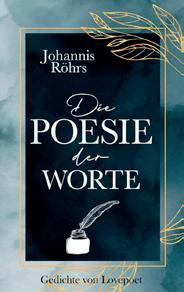
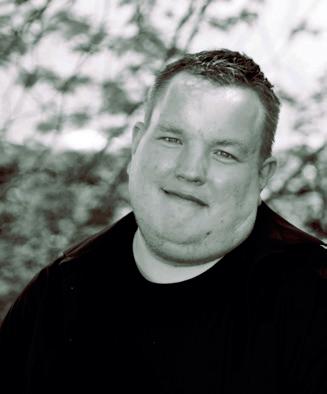
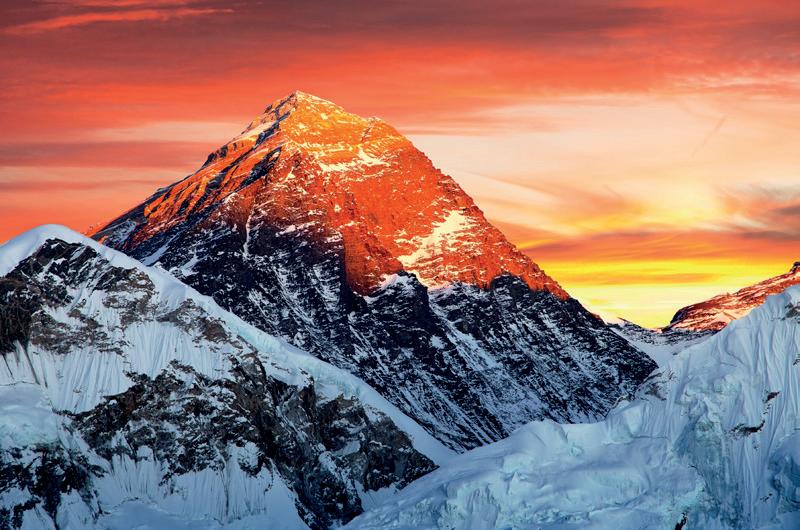

„ÜBER
Was würden Sie tun, wenn Sie auf dem Mount Everest etwas entdecken, das Sie unermesslich reich machen könnte? Vorausgesetzt, Sie wagen den Aufstieg erneut –im Winter. Genau diese Vorstellung hat Cordt Coehne in seinem Science Thriller Everest126 – Das letzte Element zu Ende gedacht.
Schon kurz nach seinem Erscheinen erreichte das Buch mit seiner Mischung aus Abenteuer, kühnen wissenschaftlichen Annahmen und dem alltäglichen Wahnsinn der Finanzindustrie den Bestseller-Status bei Amazon in den Kategorien ‚Chemie‘ und ‚Klettern‘. Eine ungewöhnliche Kombination.
Spannung gewinnt der Roman auch durch seine geopolitischen Anspielungen. Als beispielsweise die US-Regierung einen Anspruch auf Grönland erhob, gewann das fiktive Szenario im Buch ungewollt an Aktualität. Auch andere Großmächte sind nicht gerade rücksichtsvoll, wenn es um Gebietsansprüche geht – ein beunruhigend realistischer Hintergrund.
Coehne, der früher als Mediziner und Biochemiker an der Entwicklung von Medikamenten zur Behandlung seltener Erkrankungen forschte, beschreibt seinen Stil als ‚Faction‘, die gekonnte Verbindung von Fakten und Fiktion: „Für mich gilt das Motto ‚Jenseits der
Fantasie lauert die Wirklichkeit‘.“ So basiert auch das titelgebende ‚Element 126‘ auf einer realen Hypothese der Kernphysik. Während das bekannte Periodensystem aktuell bei Element 118 endet, vermuten Wissenschaftler jenseits davon eine ‚Insel der Stabilität‘ –einen Bereich, in dem superschwere Elemente möglicherweise überraschend langlebig sind. „Das hat mich sofort fasziniert“, erzählt Coehne.
Die Idee zu Everest126 entstand während einer Trekkingtour zum Everest-Basislager. Beeindruckt von der imposanten Landschaft des Himalayas und den Auswirkungen extremer Höhe auf Körper und Psyche, entwickelte Coehne die Idee einer Entdeckung, die nicht nur wissenschaftliche Grenzen verschiebt, sondern auch moralische Werte in Frage stellt. „Ab etwa 5.000 Metern Höhe nimmt die Denk- und Leistungsfähigkeit spürbar ab. In der Todeszone oberhalb von 8.000 Meter ist der Mensch kaum noch er
selbst“, so Coehne. Moral hat dort oben keinen Platz mehr, so die Einstellung mancher Everest-Bezwinger.
Besonderen Spaß gemacht haben dem Autor beim Schreiben die Hintergrundrecherchen zu den edelsten und teuersten Getränken der Welt, die sporadisch in der Handlung auftauchen. „Ich war ständig durstig“, sagt der Mediziner mit einem Augenzwinkern.
Derzeit arbeitet der passionierte MarathonLäufer an seinem nächsten Science-Thriller, der Anfang 2026 erscheinen wird. Thema: Paläoanthropologie, kontroverse Deutungen der Menschheitsgeschichte – und die Frage, ob an der Theorie des ‚Intelligent Design‘ mehr dran sein könnte, als einige vermuten. Dieses Mal rüttelt Coehne an den Grundfesten der Evolutionstheorie. Ob er sie zum Einsturz bringen wird? Der Wissenschaftler schmun-
zelt vielsagend. „Lesen Sie selbst – Sie werden überrascht sein…“
www.cordt-coehne.de
Instagram: @cordt.coehne

E-Mail: cordtcoehne@t-online.de



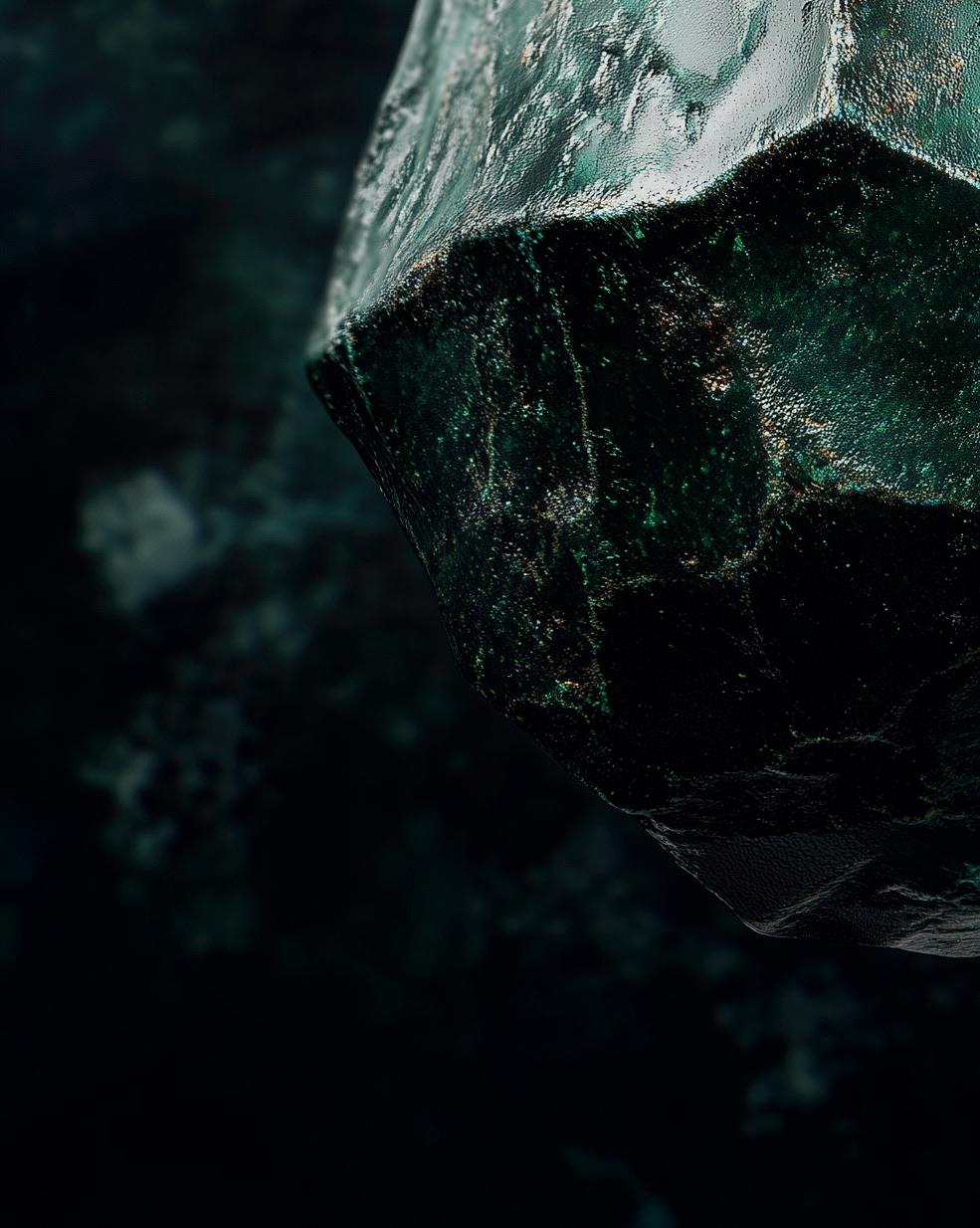
Mehr erfahren…
Scannen Sie einfach den QR-Code!
MOUNT EVEREST IM WINTER
Eisige Winde peitschen über den Gipfel, die Temperaturen liegen permanent unter minus zwanzig Grad, Lawinen sind eine ständige Bedrohung, in Gletscherspalten lauert der Tod.
Die Extrembergsteigerin Gilda Hunt weiß, dass sie auch unter diesen extremen Bedingungen den Berg der Berge ein zweites Mal besteigen muss. Denn Big E hütet einen Schatz, der sie in eine andere finanzielle Liga katapultieren würde – aber nicht nur sie...
Ihrem Team schließen sich zwei Wissenschaftler an, die in einem erbitterten Konkurrenzkampf stehen. Geht es ihnen um das rätselhafte Element 126, dessen Entdeckung den Nobelpreis bedeuten würde?
Und welche dunklen Ziele verfolgen die skrupellosen Finanziers der Expedition? Die Antworten liegen auf über 8000 Metern in der Todeszone...
Seit 1994 macht der unabhängige Kindermann Verlag Klassiker von Goethe bis Schiller in liebevoll gestalteten Bilderbüchern für Kinder zugänglich – und wurde dafür mit dem Deutschen Verlagspreis 2025 ausgezeichnet.
TEXT: MARILENA STRACKE I FOTOS: KINDERMANN VERLAG
Der Kindermann Verlag steht seit drei Jahrzehnten für die kindgerechte Vermittlung von Literatur. Gegründet wurde er von der Germanistin Barbara Kindermann, die Kindern einen unvoreingenommenen Zugang zu den Werken der Weltliteratur ermöglichen wollte. Seit 2020 führt ihre Tochter Anna Kindermann das Haus in zweiter Generation mit derselben Leidenschaft und einem Blick für zeitgemäße Themen weiter.
Das Herzstück des Programms bildet die preisgekrönte Reihe ‚Weltliteratur für Kinder‘. Hier werden Klassiker in reduzierter, leicht verständlicher Sprache und mit eindrucksvollen Illustrationen neu erzählt. Jüngst erschienen ist eine charmante Neuerzählung von Jane Austens Stolz und Vorurteil
Ergänzt wird die Reihe durch das Format ‚Kinder entdecken berühmte Leute‘, die jungen Lesern kulturelles Erbe und Wissen vermittelt. Die handlichen Poesie-Minibände – etwa Goethes Zauberlehrling oder Eichendorffs Weihnachten – laden mit Originaltexten und stimmungsvollen Bildern dazu ein, Rhythmus und Klang großer Dichtung zu schon im KitaAlter zu entdecken.
Zugleich greift der Verlag heute verstärkt aktuelle gesellschaftliche Themen auf: Diversität, Demokratie oder Umweltschutz finden ihren Platz im Bilderbuch-Programm. Ein besonderes Beispiel ist die humorvolle Neuerzählung von Prokofjews Peter und der Wolf durch den bekannten TV-Reporter Willi Weitzel. Per QR-Code führt das Buch direkt zur Au-
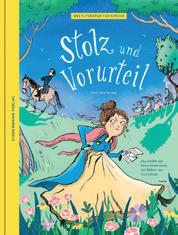

torenlesung mit Musik – ein Klangabenteuer für die ganze Familie.
So verbindet der Kindermann Verlag Tradition mit Gegenwart, weckt Leselust und macht Literatur schon früh zu einem Erlebnis, das Herz und Verstand berührt.
www.kindermannverlag.de
Viele großartige Bücher geraten in Vergessenheit, weil insbesondere große Verlage sie nicht länger publizieren. 1983 gründete Lisette Buchholz daher den persona verlag für Literatur & Zeitgeschichte, um genau diese Lücke zu füllen. Der Verlag publiziert überwiegend unbekannt gebliebene Texte aus dem deutschen und österreichischen Exil.
TEXT: JESSICA HOLZHAUSEN I FOTOS: PERSONA VERLAG
Jüngst erschien der von Andreas F. Kelletat herausgegebene Gedichtband An die Deutschen von Juliette Pary, erstmals 1946 in Paris veröffentlicht. Geschrieben auf Deutsch fand der damals aber nicht seine Adressaten. „Es ist eine einzigartige Abrechnung mit dem Nationalsozialismus und zugleich das Zeugnis der tiefen Liebe von Juliette Pary zur deutschen Literatur“, erklärt Verlagsgründerin Lisette Buchholz. Juliette Pary schrieb vorwiegend Romane auf Französisch und war aktiv in der Résistance. Sie verstarb 1950 in der Schweiz. Zwei weitere Entdeckungen der Verlagsleiterin sind Kamel Daouds Minotaurus 504 (2012) und die Erzählungen Äpfel aus
der Wüste (1992) der israelischen Autorin Savyon Liebrecht. Mit der Autorin Hazel Rosenstrauch brachte der Verlag insgesamt gleich vier Bücher heraus, die sich mit dem deutsch-jüdischen Verhältnis befassen. Auch ältere Titel hält der persona verlag stets vorrätig: Ein spannender Schatz an Altund Neuentdeckungen.
Zu den Schwerpunkten des Verlags gehören Dichterinnen der zwanziger Jahre, Exil- und Widerstandsliteratur zwischen 1933 und 1945, israelische Literatur, Islamismus- und Kolonialismus-Kritik sowie zeitgenössische Literatur, die sich mit den Folgen der NS-Zeit beschäftigt. Dabei veröffentlicht der Verlag eine große Bandbreite


an Genres: von Romanen über Poesie bis hin zu Briefen und Satiren. Für das ambitionierte Gesamtprogramm wurde der persona verlag mit mehreren Preisen ausgezeichnet.
www.personaverlag.de




While Germany is world-famous for its festive Christmas markets and snow-dusted fairy-tale castles, there is a hidden side to winter here that beckons the curious and the bold. If you are a travel enthusiast seeking something beyond the usual, Germany brims with quirky traditions, local secrets and adrenaline-pumping activities that will transform your winter escape into an unforgettable adventure.
TEXT: NANE STEINHOFF




Think the Germans are reserved in winter? Not when it comes to ice bathing! Every year, locals and brave visitors gather at Berlin’s lakes, like Wannsee and Orankesee, to plunge into icy waters, sometimes surrounded by snow. This exhilarating ritual is believed to boost the immune system and banish the winter blues. If you are tempted, look out for organised groups such as the Berliner Seehunde (Berlin Seals), who welcome newcomers. Remember: never go alone, and consult your doctor before taking the plunge – safety, after all, is as important as the thrill!
Swap your ice skates for a game of Eisstockschießen, the Bavarian cousin of curling. This centuries-old sport is played on frozen ponds and specially prepared rinks all over southern Germany. You will find it in Munich’s Englischer Garten or quaint Alpine villages, where locals compete in jovial tournaments. No need for previous experience; just bring a competitive spirit and perhaps a mug of Glühwein to keep your hands toasty as you play.
Step into a world of legends on a haunting ghost walk through the medieval towns of the Harz Mountains. Once the haunt of witch-

es and outlaws, places like Wernigerode and Goslar come alive after dark with costumed guides who will regale you with tales of lost souls and mysterious happenings. The snow-blanketed streets add an extra shiver, making these walks as atmospheric as they are informative. Do not forget your camera –these ancient alleyways are eerily beautiful under a winter moon.
In the heart of the Black Forest, you can do more than admire the famous cuckoo clocks –you can make one yourself. Join a workshop in towns like Triberg or Schönwald,
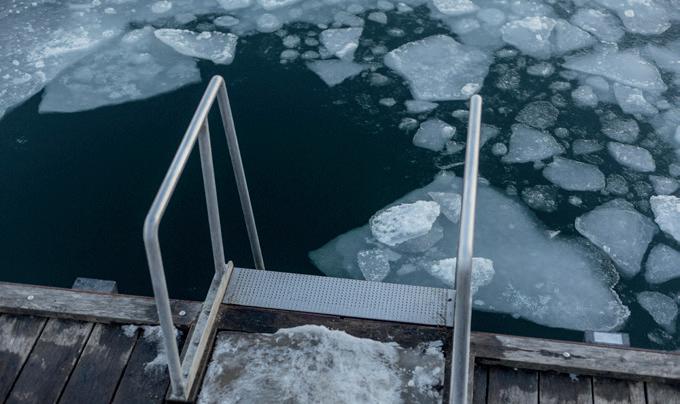
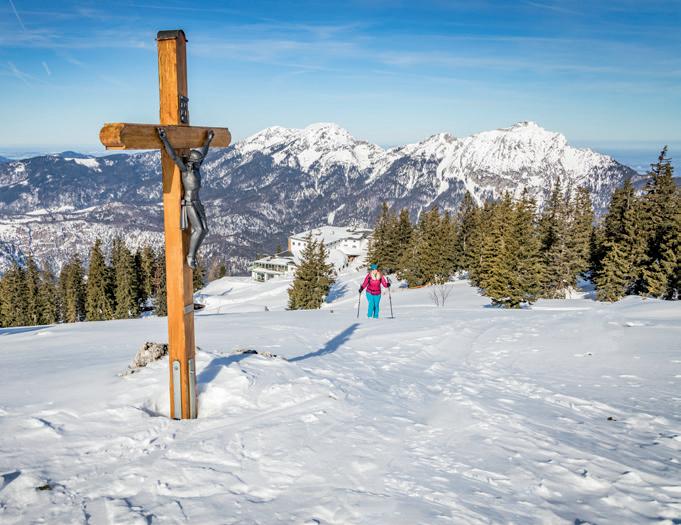
where local artisans reveal the secrets behind intricate woodcarving and clockmaking. It is a hands-on way to connect with German tradition and bring home a truly one-of-a-kind souvenir. Not to worry if you are not a natural with tools: friendly instructors guide even the most novice of crafters.
Winter transforms the Bavarian Alps into a wonderland best explored on snowshoes. Guided tours from Garmisch-Partenkirchen or Berchtesgaden lead you across powdery meadows and up to panoramic viewpoints, all while avoiding crowded slopes. Snowshoeing is easy to pick up, gentle on the knees, and offers a peaceful way to spot winter wildlife or simply bask in the silence of the forest. Plus, you will have the chance to warm up with hearty local fare in a mountain hut afterwards.
Imagine exploring ancient castles by the flicker of lantern light. Throughout winter, castles like Burg Eltz on the Moselle or Hohenzollern Castle in Baden-Württemberg offer special night tours. Wander through echoing halls, spiral staircases and snowy courtyards as guides share tales of intrigue and romance. The magical glow and crisp air make it feel as though you have wandered straight into a Brothers Grimm story. Book in advance –these enchanting tours are popular with locals and visitors alike.
Germany’s wine country does not hibernate in winter. Vineyards along the Rhine and Mosel rivers invite you to sample robust reds and spicy mulled wines in atmospheric cellars, often set against the backdrop of snow-covered vineyards. Try an ice wine (Eiswein) for a uniquely German winter tipple (for more information read the feature about ice wine in this issue). Many estates offer guided tastings paired with local cheeses

and breads – a delicious way to warm up after a chilly river walk. Do not miss the festive wine festivals held throughout the season.
For a taste of the Arctic in southern Germany, sign up for a sled dog adventure in the rolling hills of Allgäu. Professional mushers introduce you to their friendly huskies before you set off on a brisk ride through forest trails and open countryside. It is a thrilling,
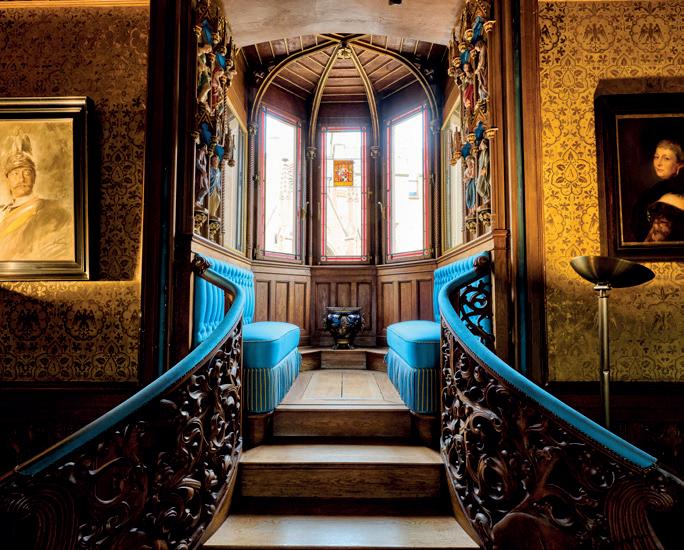
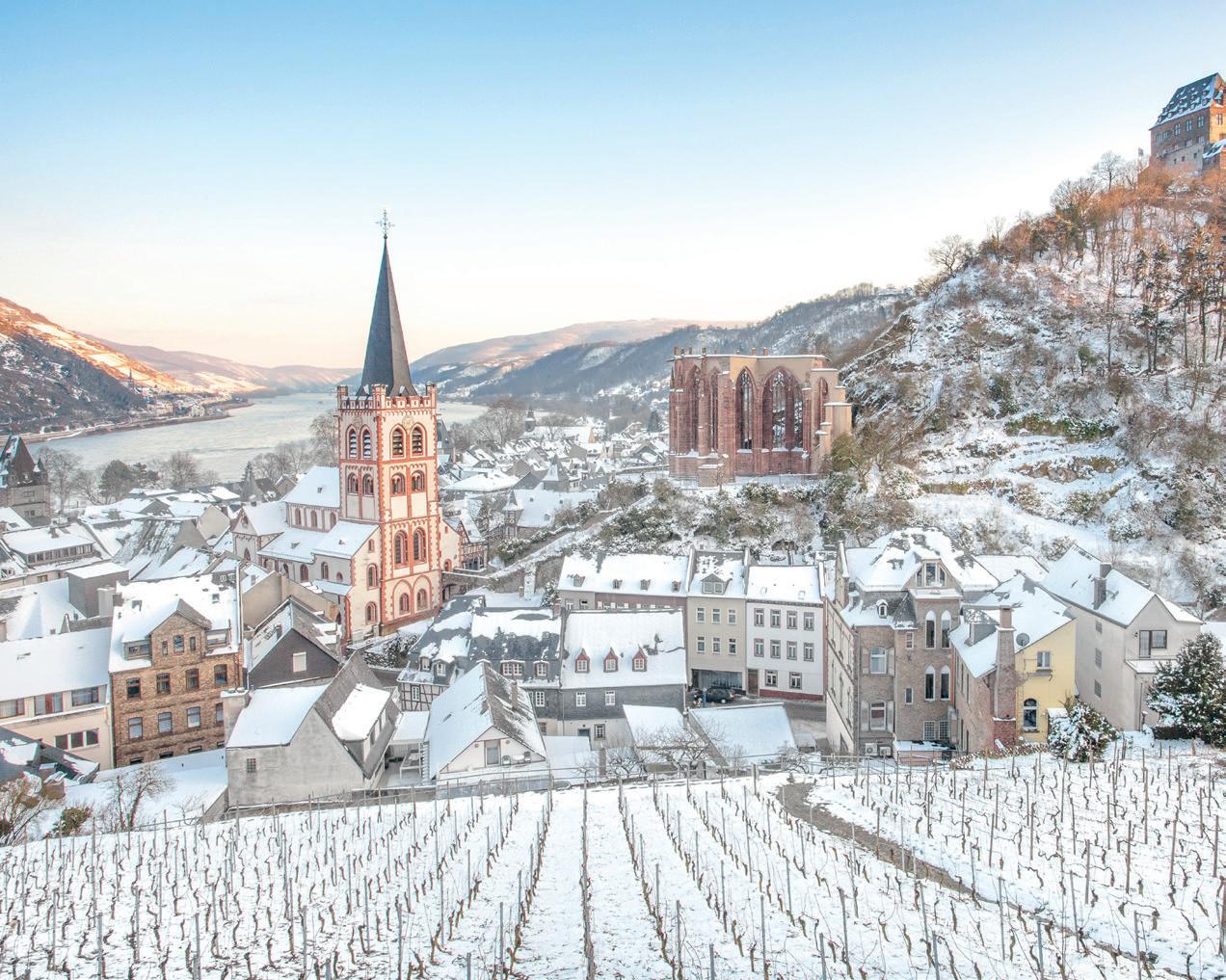
family-friendly experience, with options for short jaunts or half-day expeditions. Book ahead, dress warmly, and prepare for plenty of enthusiastic barks and wagging tails.
Sauna culture is deeply rooted in German life, but Hamburg puts an urban spin on the tradition. Here, you can flit between floating saunas on the Alster Lake, rooftop spas with skyline views, and quirky themed baths (think: 1970s disco or Nordic log cabins).
Sauna hopping is a social affair, and many venues offer relaxing winter infusions, outdoor plunge pools, and chill-out zones for post-steam lounging. There is no need to be shy – it is all about embracing wellness the German way.


Adventure seekers, this one is for you! The dramatic sandstone cliffs of Saxon Switzerland become a playground for ice climbers during the coldest months. Guided courses cater for beginners and experienced climbers alike, ensuring you can safely scale frozen waterfalls and vertical rock faces. All equipment is provided, and instructors share essential safety tips before you tackle your first icy ascent. The reward? Jaw-dropping vistas over snow-draped valleys.
Experience the romance of winter travel aboard a historic steam train. The Harz Narrow Gauge Railway, for instance, puffs its way through frost-laced forests to Brocken mountain, often shrouded in mystical mist and snow. Decorated carriages and toasty wood stoves set the scene for a nostalgic journey, with opportunities to spot wildlife and snap postcard-perfect photos from your window. Check timetables in advance and bundle up for open-air viewing platforms.
End your day with a rush of adrenaline by whizzing down floodlit toboggan runs in Garmisch-Partenkirchen. As darkness falls, the pistes come alive with laughter, clattering sleds, and mulled wine stands. Tobogganing here is not just for children – adults join in on the fun, racing friends or simply enjoying the thrill of night-time descents against a backdrop of twinkling Alpine villages. Wear sturdy boots, wrap up warm, and let your inner child take the reins.
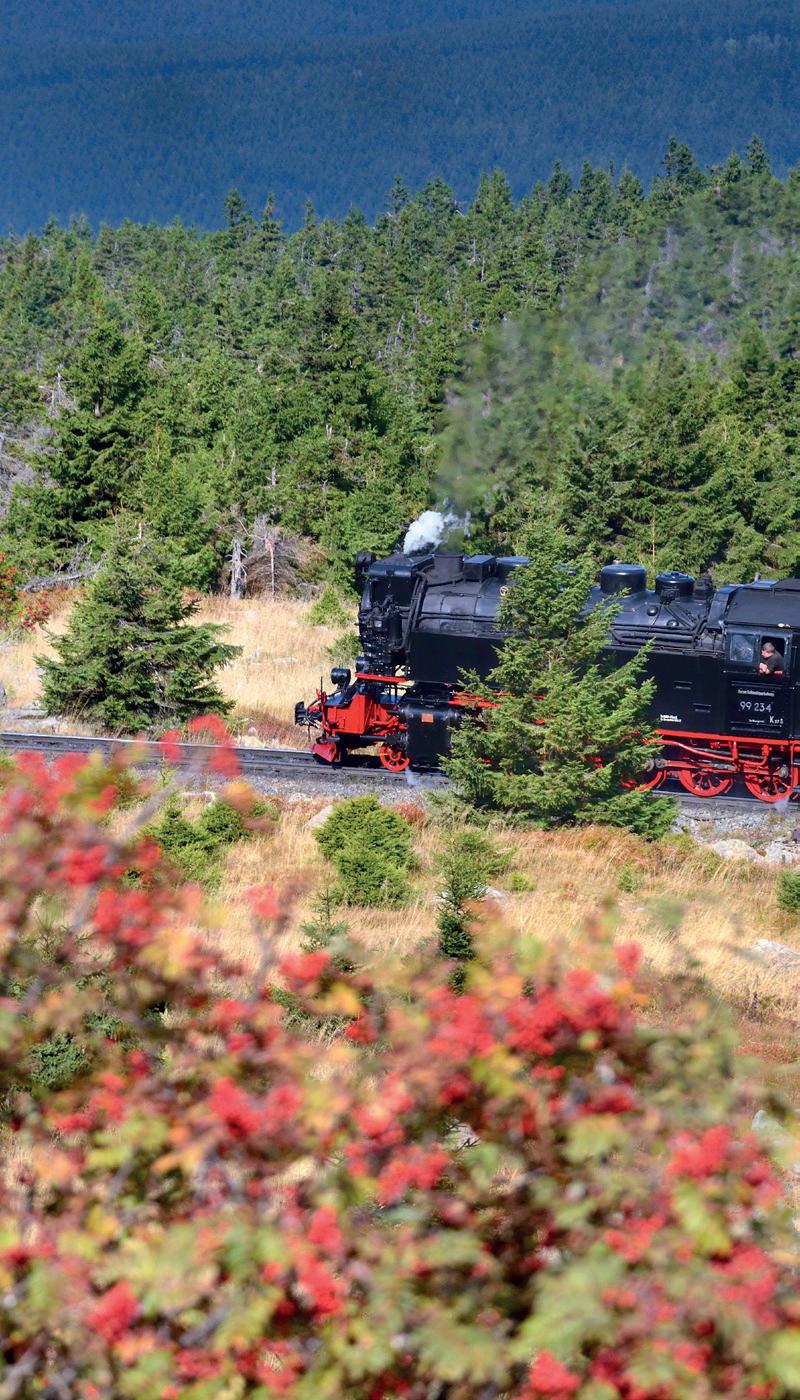


This is not your typical hotel. harry’s home offers guests more than just a room –it offers freedom. Tailored to the needs of today’s modern traveller, it is flexible, individual and refreshingly personal.
Check in, breathe out, settle in. From the moment you enter harry’s home, it is clear that people come first. Founded in 2006 by Harald ‘Harry’ Ultsch, the hotel group is built on a simple yet compelling idea: it is the hotel that should adapt to the guest, not the other way around. “We didn’t want to create an ordinary hotel, but a second home – one that’s tailored to the needs of our guests,” says Ultsch.
And it is an idea that has paid off. With 16 locations across Austria, Germany and Switzerland – from buzzing city centres to nature-filled surroundings – guests encounter a hotel model that is intentionally nonprescriptive. Rooms range from 22 to 75 square metres and can be configured like building blocks: with or without a kitchen, with breakfast or without. “It means that each guest gets a home away from home, shaped to their own needs – with as much or as little hotel service as they like,” Ultsch adds. “What makes harry’s home truly special is the blend of contemporary design, smart functionality
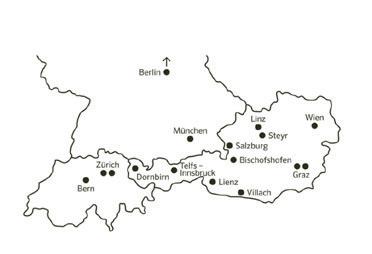
Locations.
and a warm, family-style atmosphere. We don’t do rigid hotel rules, we offer space for personal wishes and unique life situations.”
This flexibility makes harry’s home the ideal base for business travellers, city explorers, families, digital nomads and long-stay guests alike. The central service point, complete with washing machines, dryers, snack machines and irons, is open to all, as are the co-working areas and, in some properties, a lovingly designed playroom for children.
The culinary concept is just as adaptable. Guests can enjoy a generous, regionally in-
spired breakfast buffet – or choose to cook themselves in the well-equipped kitchens, or head out to indulge in the local food scene. Whether for one night or several months, harry’s home does not ask guests to compromise. Instead, it offers a world of possibilities.
www.harrys-home.com/en


Das etwas andere Hotel-Konzept: harry’s home bietet Reisenden nicht nur ein Zimmer, sondern ein Stück Freiheit. Hier wird sich konsequent an den Bedürfnissen moderner Reisenden orientiert – individuell, flexibel und überraschend persönlich.
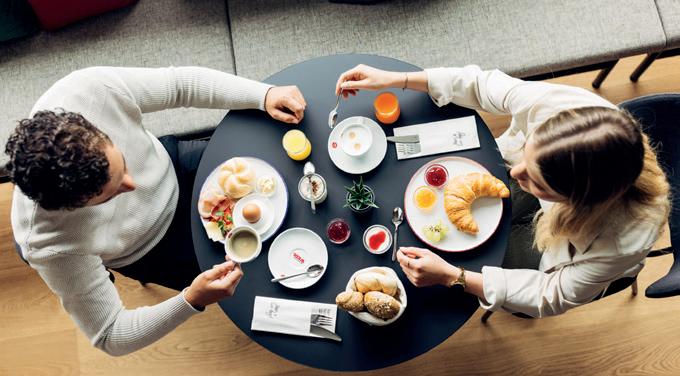
Einchecken, durchatmen, ankommen: Wer harry’s home betritt, merkt schnell, dass hier der Mensch im Mittelpunkt steht. Gegründet 2006 von Harald ‚Harry‘ Ultsch, folgt die Hotelgruppe einer simplen, aber einleuchtenden Idee: Hotels sollten sich an den Gast anpassen, nicht umgekehrt. „Wir wollten kein gewöhnliches Hotel, sondern ein zweites Zuhause schaffen – maßgeschneidert auf die Bedürfnisse unserer Gäste“, sagt Ultsch.
Der Erfolg gibt ihm recht. An derzeit 16 Standorten in Österreich, Deutschland und der Schweiz – von urban bis naturnah – begegnet
man einem Hoteltypus, der sich ganz bewusst nicht festlegen will. Zimmer von 22 bis 75 m² lassen sich nach Baukastenprinzip konfigurieren: mit oder ohne Küche, mit Frühstück oder ohne. „So entsteht für jeden Gast ein individuell angepasstes Zuhause auf Zeit – mit genau so viel oder so wenig Hotelservice, wie gewünscht“, ergänzt Ultsch. „Was harry’s home besonders macht, ist die Kombination aus modernem Design, durchdachter Funktionalität und einer authentisch-familiären Atmosphäre. Bei uns gibt es keine starren Hotelstrukturen, sondern Raum für persönliche Wünsche und individuelle Lebenssituationen.“
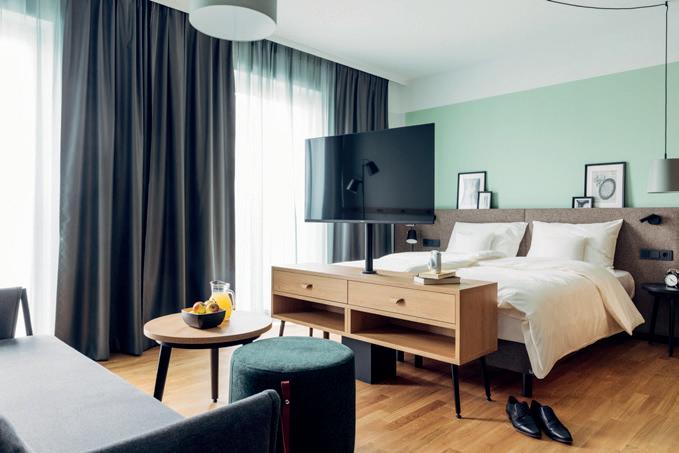

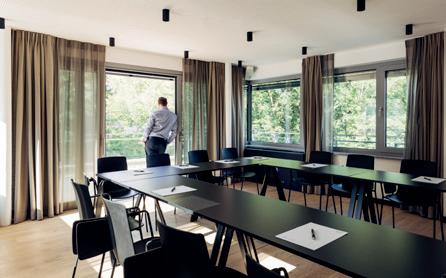

Diese Flexibilität macht harry’s home zum idealen Ort für Business Traveller, Städtereisende, Familien, digitale Nomaden oder Langzeitgäste. Der zentrale ‚Service Point‘ mit Waschmaschine, Trockner, Snackautomaten und Bügeleisen steht allen offen – genau wie die Co-Working-Zonen oder, in einigen Häusern, das liebevoll gestaltete Kinderspielzimmer.
Auch kulinarisch bleibt alles offen: Wer mag, bedient sich am regional inspirierten, reichhaltigen Frühstücksbuffet – wer lieber selbst kocht oder die Lokalszene erkundet, tut das ebenfalls ganz im Sinne der Philosophie. Ob für eine Nacht oder einen Monat – harry’s home ist kein Ort für Kompromisse, es ist ein Ort der Möglichkeiten.
www.harrys-home.com
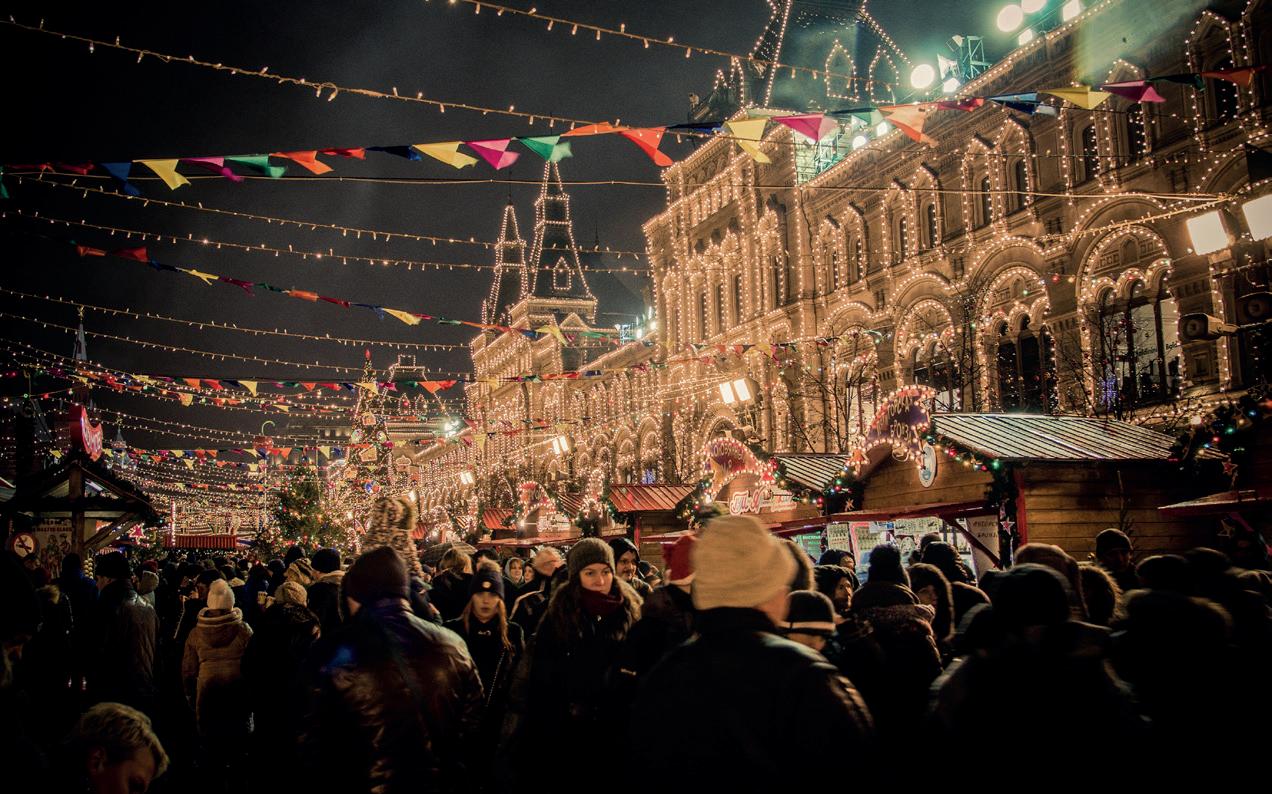
Germany is famous for its beautiful and diverse selection of Christmas markets. Visit a big city and you will not get around it, visit a small city and it will be the centrepiece. But what is it about these winter wonderland installations that makes them so very irresistible? Let’s find out in this special theme.

































































































































































As soon as Bremerhaven Christmas Market opens on 24 November, the city centre of Germany's largest city by the North Sea Coast is transformed into a sparkling sea of lights. From culinary specialities and a fairy tale village to hands-on activities, the Christmas market provides a unique festive experience in Northern Germany.
With nearly 200,000 LED lights, glowing stars, oversized baubles, and atmospheric installations, the market is one of the most beautiful Christmas markets in the North of Germany.
“In recent years, Bremerhaven’s Christmas market has generated a lot of buzz," says managing director Michael Gerber.
Around the neo-Gothic Große Kirche and extending to Theodor-Heuss-Platz, 65 lovingly decorated stalls enchant visitors with crafts and hands-on culinary activities, such as spinning candy floss or roasting almonds. Each year, a local family donates a large Christmas tree, which forms the market's centrepiece and symbolises the bond between citizens and their city. Rudi, a three-metre-high reindeer sculpture, enchants not only the youngest visitors: press the buzzer and Rudi’s bright red nose lights up.
And the best part? Unlike many other Christmas markets, Bremerhaven's market does not close before Christmas; it stays open un-
til 30 December, with a short break over the festive season. Throughout Advent, there is a varied programme for all ages, including the Christmas parade with angels on 1 December and light and laser shows, which can best be viewed from the large Ferris wheel offering a brilliant view over the city and its harbour.
Just a short walk from the Christmas market lies Bremerhaven’s New Harbour, home to a row of fascinating museums and attractions. History buffs, for example, will find the German Emigration Center (Deutsches Auswandererhaus) a particularly interesting destination: it tells the stories of seven million German emigrants who departed from Bremerhaven to America or Australia, leaving their old home behind for a new life abroad. The Climate House (Klimahaus Bremerhaven) with its focus on world habitats offers a different kind of journey, an interactive experience where visitors can travel through different climate zones
around the globe. Or how about a visit to Germany's smallest scientifically managed zoo, which is home to polar bears and penguins?
Interesting and diverse – that is Bremerhaven, a quality reflected in both its museums and the luminous splendour of its Christmas market.
www.bremerhaven-tourism.de
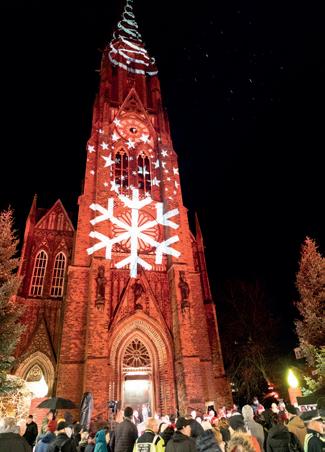
Sobald der Bremerhavener Weihnachtsmarkt am 24. November öffnet, verwandelt sich die Innenstadt von Deutschlands größter Stadt an der Nordsee in ein funkelndes Lichtermeer. Von kulinarischen Spezialitäten über ein Märchendorf bis hin zu Mitmachaktivitäten sorgt der Weihnachtsmarkt für ein festliches Erlebnis in Deutschlands Norden.
Mit fast 200.000 LED-Lichtern, leuchtenden Sternen, überdimensionalen Kugeln und stimmungsvollen Installationen gehört der Weihnachtsmarkt in Bremerhaven zu einem der schönsten Märkte im Norden. „Der Weihnachtsmarkt hat in den vergangenen Jahren von sich Reden gemacht“, sagt Geschäftsführer Michael Gerber.
Rund um die neugotische Große Kirche bis hin zum Theodor-Heuss-Platz verzaubern 65 liebevoll dekorierte Stände die Besucher mit Handwerk und kulinarischen Mitmachaktionen, wie das Spinnen von Zuckerwatte oder das Rösten von Mandeln. Jedes Jahr spendet eine Bremerhavener Familie einen großen Weihnachtsbaum, der den Mittelpunkt des Marktes bildet und ein Zeichen für die Verbundenheit der Bürger mit der Stadt setzt. Für ein Schmunzeln nicht nur bei den kleinsten Gästen sorgt ,Rudi’, eine drei Meter hohe Rentier-Skulptur: Wer den Buzzer drückt, lässt seine rote Nase aufleuchten.


Und das Beste daran: Anders als viele andere Weihnachtsmärkte schließt der Weihnachtsmarkt in Bremerhaven nicht bereits vor Weihnachten, sondern ist bis zum 30. Dezember geöffnet – mit einer kleinen Pause über die Feiertage. Darüber hinaus gibt es den ganzen Advent über ein vielseitiges Programm für alle Altersgruppen wie den Weihnachtsumzug mit Engeln am 1. Dezember oder Licht- und Lasershows, die sich zum Beispiel vom Riesenrad mit Ausblick über die Stadt und den Hafen beobachten lassen.
ERLEBNISSTADT BREMERHAVEN: SPANNENDE ABENTEUER IM ZOO UND KLIMAHAUS
Vom Weihnachtsmarkt aus ist es nur ein kurzer Fußweg zum Neuen Hafen, wo sich spannende Museen und Erlebniswelten aneinanderreihen. Für Geschichtsinteressierte ist beispielsweise das Deutsche Auswandererhaus ein besonders interessanter Ausflugsort: Es erzählt Geschichten der sieben Millionen
Menschen, die von Bremerhaven aus nach Amerika oder Australien aufbrachen und die alte Heimat für ein neues Leben in der Ferne hinter sich ließen. Eine andere Art Reiseerlebnis bietet das Klimahaus, eine Erlebniswelt, in der Besucher durch die verschiedenen Klimazonen einmal um die Welt wandern können. Oder wie wäre es mit einem Besuch im kleinsten wissenschaftlich geführten Zoo Deutschlands, in dem Eisbären und Pinguine leben?
Interessant und abwechslungsreich – das ist Bremerhaven, das sich in den Museen ebenso widerspiegelt, wie im Lichterglanz des Weihnachtsmarkts.
www.bremerhaven-tourism.de



When the lights shine across Kassel and the scent of roasted almonds drifts through the streets, the unique Fairy-tale Christmas Market opens its doors once again.
From 24 November to 30 December 2025, the centre of the documenta city of Kassel transforms into a sparkling world of fairy tales. In keeping with the cultural heritage of the Brothers Grimm, a different story takes centre stage each year, and this winter it is Frau Holle (Mother Hulda) who guides visitors through the festive season.
“Between festively decorated stalls and glittering lights, guests are immersed in a world where fairy tales come alive,” says Anna Gerbig, MICE marketing manager & digital communications. “Two spectacular appearances by Father Christmas make the market truly unique: at 4.30pm he soars across Friedrichsplatz in his sleigh, and at 5.30pm he abseils from the City-Point building, landing right in the middle of Königsplatz.” The programme is rounded off by the popular Fairytale Advent Calendar (1-23 December), as well as highlights such as the Ferris wheel, the enchanting Fairy-tale Forest, the Fairytale Pyramid and the giant slide.
There are also new culinary delights to discover. In the popular hut Wochenhütte, Mama Afrika will be serving vegetarian and vegan specialities for the first time. Schloss Höhnscheid tempts visitors with hearty cheese sandwiches and organic goose burgers – regional, inventive and with a focus on sustainability. Alongside these new additions, the organisers continue to place great emphasis on traditional craftsmanship and locally sourced products.
The Kassel Fairy-tale Christmas Market delights people of all ages. Families with children, couples, groups of friends or solo travellers –everyone will find the market a place to marvel, indulge and unwind. Thanks to its central location in the heart of Germany, Kassel is the perfect destination for day trips as well as extended Advent weekends.
“A special offer is also aimed at event planners and MICE professionals,” Anna Gerbig adds. “On 7 and 8 December, Kassel will host
an Educational Trip, including a workshop with event expert Julia Heimeier and an exclusive visit to the Christmas Market. This way, winter in Kassel is not only magical, but also truly inspiring.”
Please note, the market is closed from 24 – 26 December.
www.weihnachtsmarkt-kassel.de
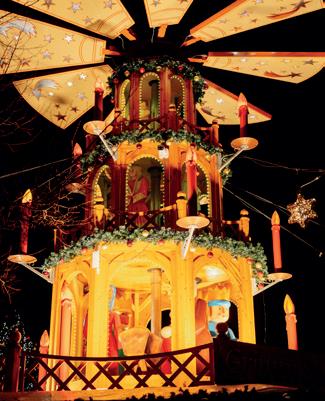
Wenn in Kassel die Lichter erstrahlen und der Duft von gebrannten Mandeln durch die Straßen zieht, öffnet der einzigartige Märchenweihnachtsmarkt wieder seine Tore.
Vom 24. November bis zum 30. Dezember 2025 verwandelt sich die Innenstadt der documenta-Stadt Kassel in eine glitzernde Märchenwelt. Passend zum kulturellen Erbe der Brüder Grimm steht hier jedes Jahr ein anderes Märchen im Mittelpunkt und in diesem Winter ist es Frau Holle, die die Gäste durch die Kasseler Adventszeit begleitet.
„Zwischen festlich geschmückten Hütten und glitzernden Lichtern tauchen Besucherinnen und Besucher in eine Welt ein, in der Märchen lebendig werden“, so Anna Gerbig, MICE Marketing Managerin & Digitale Kommunikation.
„Zwei spektakuläre Auftritte des Weihnachtsmanns machen den Markt einzigartig: Um 16:30 Uhr fliegt er in seinem Schlitten über den Friedrichsplatz, um 17:30 Uhr seilt er sich artistisch vom City-Point ab und landet mitten auf dem Königsplatz.” Ergänzt wird das Programm durch den beliebten MärchenAdventskalender (1. – 23. Dezember) sowie Attraktionen wie das Riesenrad, den stimmungsvollen Märchenwald, die Märchenpyramide und die große Rutsche.
Auch kulinarisch gibt es Neues zu entdecken. In der beliebten Wochenhütte präsentiert Mama Afrika erstmals vegetarisch-vegane Spezialitäten. Schloss Höhnscheid verwöhnt
Gäste mit herzhaften Schafskäse-Sandwiches und Bio-Gänse-Burgern - regional, raffiniert und nachhaltig. Neben den neuen Angeboten wird natürlich weiterhin großer Wert auf traditionelle Handwerkskunst und Produkte aus der Region gelegt.
Der Kasseler Märchenweihnachtsmarkt begeistert Menschen jeden Alters. Egal, ob Familien mit Kindern, Paare, Freundesgruppen oder Alleinreisende: sie alle finden hier einen Ort zum Staunen, Genießen und Innehalten. Dank seiner zentralen Lage mitten in Deutschland eignet sich Kassel perfekt für Tagesausflüge ebenso wie für verlängerte Adventswochenenden.
„Ein besonderes Angebot richtet sich an Eventplanende und MICE-Verantwortliche”, fügt Anna Gerbig hinzu. „Am 7. und 8. Dezember lädt Kassel zum Educational Trip ein – Workshop mit Eventexpertin Julia Heimeier und exklusivem Besuch des Weihnachtsmarktes. So wird der Kasseler Winter nicht nur magisch, sondern auch inspirierend.“
Bitte beachten: Der Markt ist vom 24. bis 26. Dezember geschlossen.
www.weihnachtsmarkt-kassel.de
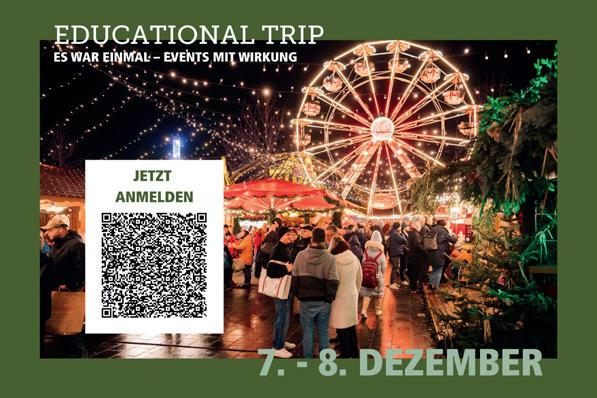

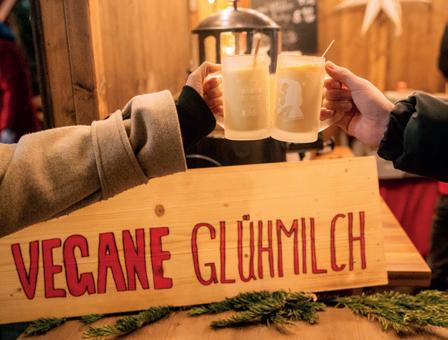
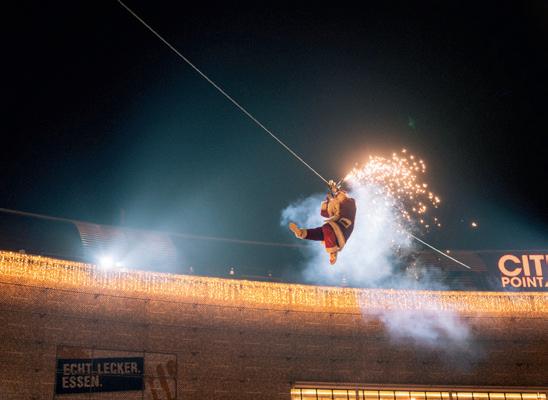

When baroque meets Christmas cheer, the city of Fulda becomes a winter wonderland that is not to be missed for visitors from near and afar.
From 21 November to 23 December (closed on 23 November), the historic heart of the city shows off its most festive side with decorated cobblestone streets, five different theme markets with their own unique flair, and lots of wonderful things to experience that make Advent season extra special.
One big advantage of Fulda’s Old Town is that everything is in close vicinity. A short walk is all it takes to immerse yourself in a completely different atmosphere – take the lively university square with its large Christmas Pyramid for example, or the atmospheric Winter Forest at the parish church. And while the museum courtyard is filled with a rustic juggler atmosphere, the regio’markt at Buttermarkt square offers delightful handicrafts and gastronomic delicacies from the region.
Thus, the city of Fulda offers a diverse Christmas experience – with multiple attractions to be found just a stone's throw away from each other.
A brand new addition this year is a 15-metrehigh Ferris wheel on Rabanusstraße. It can
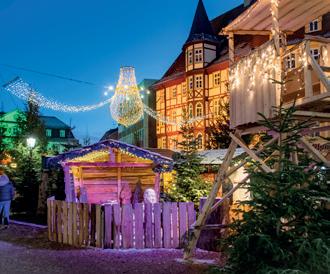
be seen from afar and offers a special view of the Christmas-lit city centre – an experience for families, the young at heart, and anyone who wants to enjoy the Christmas market from above.
There is plenty on offer for families in Fulda. At Kinder-Weihnachtsland, children's eyes light up at the sight of the carousel, magic shows, and music programmes, as well Karlchen’s ice rink. Music enthusiasts will also find what they are looking for: tower trumpeters, organ concerts, choirs, and music associations from the region provide festive sounds everywhere.
REGIONAL CRAFT AND DELICACIES: WEIHNACHTLICHER REGIO’MARKT
This exclusive Christmas market situated at historic Buttermarkt square offers sustainable, regional products, presented by Hessian producers and small manufacturers
– visitors enjoy culinary delights with typical dishes from the Rhön mountains.
A special moment awaits visitors on 13 December, when thousands of voices unite on the Cathedral Square. An atmosphere is created that immediately puts you in the Christmas spirit – a moving experience that stays with you for a long time.
Nestled between fir trees and sparkling lights, the Winter Forest invites visitors to linger. Particularly popular are the mulled wine stands, where people like to meet and enjoy the Advent season in an atmospheric setting. This year, the Winter Forest is open until 30 December – perfect for the days between Christmas and New Year's Eve.
Fulda tastes of roasted almonds, bratwurst, and mulled wine – but also of fine pastries, cookies, and regional specialities from the Rhön mountains. In short: nothing but gude things – the best of stuff – as they like to say in Fulda.
No sooner has the Christmas market come to an end than the next highlight follows: from 26 to 30 December, the Winter Varieté
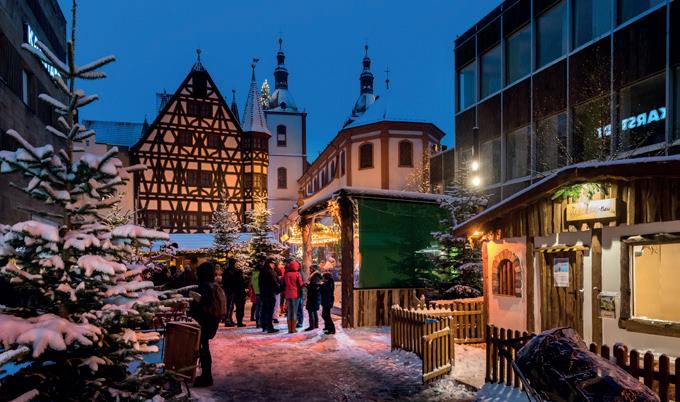
transforms the Baroque Orangery into a place full of magic. International artists bring music, artistry, and comedy to the stage – a programme full of surprises and spine-tingling moments.
During Advent, Fulda is much more than just a Christmas market. The whole city shines with thousands of lights, the baroque facades become a festive backdrop, and every square offers something new to discover. Everything is close together: short distances meet great variety.
The Christmas market itself has a tradition of over 40 years. It has continued to evolve and is now one of the largest and most

beautiful Christmas markets in the region. Frequent visitors are of course the people of Fulda, who love their local Christmas market, guests from the region as well as many tourists – to whom the city offers a number of successful package deals.
While strolling through the alleys of Fulda’s historic Old Town, you can feel and experience the special blend of tradition, warmth, and festive atmosphere up close. It makes for a true winter wonderland that enchants guests from near and afar.
www.weihnachten-fulda.de
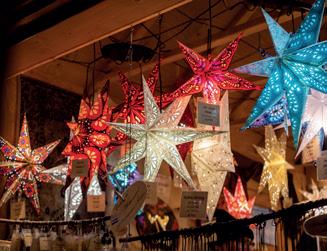
Highlights to note
- Weihnachtlicher regio’markt: sustainable and regionally produced products at Buttermarkt
- Carol singing on Cathedral Square – 13 December
- Winter Forest – also open from 27 to 30 December
- 5th Winter Variety Show at the Orangery – 26 to 30 December www.wintervariete-fulda.de
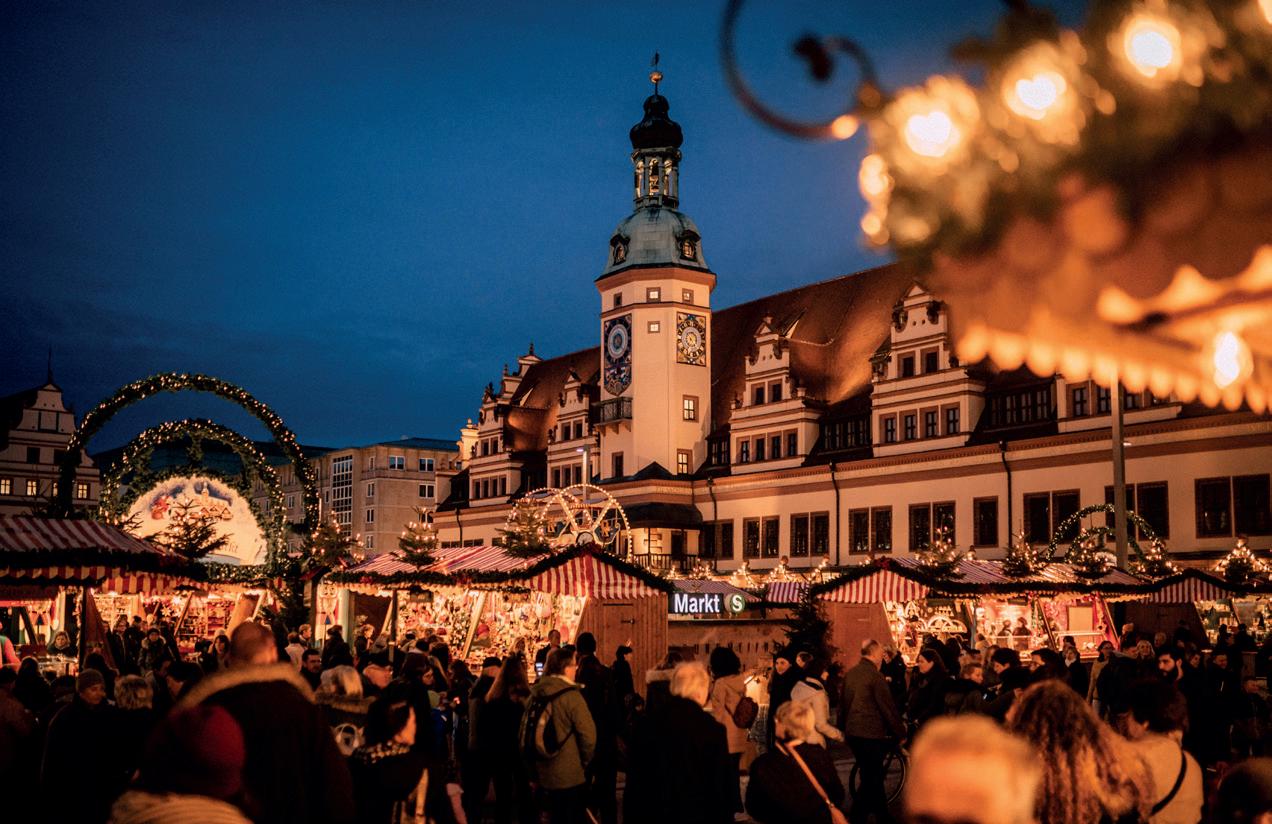
Festive splendour in cosy markets, contemplation and joyful music – Leipzig’s Advent season delights with the perfect blend.
The Leipzig Christmas Market is a vibrant mosaic of themed markets that blend seamlessly throughout the city centre, creating a truly unique overall experience. Visitors will find not only the historic market, but also Finnish and South Tyrolean villages. This is complemented by numerous smaller Christmas markets in the districts and surrounding region, each adding its own character to the magical atmosphere.
First recorded as early as 1458, the market is an integral part of the run-up to Christmas for the locals. Today, with around 300 stalls, it is one of Germany’s largest Christmas markets and a beloved meeting place for family and friends. Those wandering through the festive bustle know that stopping at the awardwinning mulled wine stalls is a must. Regional specialities such as delicious Kräppelchen (a
pastry) and freshly baked waffles are also part of the quintessential Advent experience.
As every year, Father Christmas will make his traditional festive entrance to officially usher in Leipzig’s Advent season on the opening weekend (29 November). Musically, the market is accompanied by a brass quartet performing from the balcony of the Old Town Hall, filling the square with festive sounds. Lovers of classical music should not miss the Christmas Oratorio by Johann Sebastian Bach, one of the cultural highlights of the season.
Another centrepiece of the market is the wide variety of regional products and traditional handicrafts. From wooden toys and ceramics to culinary delights, many artisans and businesses from Leipzig and the surrounding area
present lovingly crafted goods. The market is not only a place of enjoyment, but also a showcase for regional culture and craftsmanship.
Ultimately, it is this mix that makes the Leipzig Christmas Market so special: grand festive magic meets over 20 small, charming markets; joyful music blends with contemplative moments – all within a region that lives and celebrates its traditions.
leipzig.travel/christmas
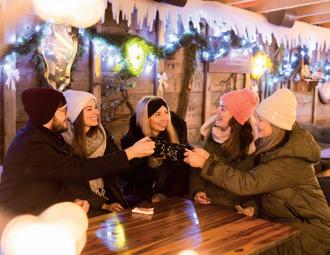
Festliche Stimmung auf kleinen Märkten, Besinnlichkeit und fröhliche Musik: die Leipziger Adventszeit lockt mit der perfekten Mischung.
Der Leipziger Weihnachtsmarkt ist ein stimmungsvolles Mosaik aus verschiedenen Themenmärkten, die sich nahtlos durch die Innenstadt ziehen und so ein unvergleichliches Gesamtbild ergeben. So findet man dort zum Beispiel nicht nur den historischen, sondern auch den finnischen und süd-tiroler Weihnachtsmarkt. Ergänzt wird das Erlebnis durch zahlreiche kleinere Weihnachtsmärkte in den Stadtteilen und der Region, die mit ihrem individuellen Charakter den großen Weihnachtszauber wunderbar abrunden.
Für die Leipzigerinnen und Leipziger gehört der Markt fest zur Vorweihnachtszeit – bereits im Jahr 1458 wird er erstmals erwähnt. Heute ist er, mit ca. 300 Ständen, einer der größten Weihnachtsmärkte Deutschlands und ein beliebter Treffpunkt für Familien und Freunde. Wer im Leipziger Weihnachtszauber unterwegs ist, weiß: An den prämierten Glühweinständen muss man unbedingt Halt machen. Und auch regionale Spezialitäten wie frisch gebackene Kräppelchen oder duftende Waffeln sind fester Bestandteil des Adventsvergnügens.
Auch in diesem Jahr warten besondere Highlights auf die Besucherinnen und Besucher. Am Eröffnungswochenende (29.11.) zieht
traditionell der Weihnachtsmann feierlich auf den Markt ein und eröffnet die Leipziger Adventszeit. Musikalisch begleitet wird der Weihnachtsmarkt von einem Bläserquartett, das vom Balkon des Alten Rathauses stimmungsvolle Klänge in die Menge trägt. Wer klassische Musik liebt, sollte sich das Weihnachtsoratorium von Johann Sebastian Bach nicht entgehen lassen, das hier zu den kulturellen Höhepunkten der Saison zählt.
Ein weiteres Herzstück des Marktes ist die Vielfalt regionaler Produkte und traditioneller Handwerkskunst. Ob Holzspielzeug, Keramik oder kulinarische Spezialitäten: viele Manufakturen und Betriebe aus Leipzig und Umgebung sind mit ihren liebevoll gefertigten Waren vertreten. So wird der Markt nicht nur zu einem Ort des Genießens, sondern auch zu einer Plattform für die Wertschätzung regionaler Kultur und Handarbeit.
Am Ende ist es genau diese Mischung, die den Leipziger Weihnachtsmarkt so besonders macht: großer Weihnachtszauber trifft auf über 20 kleine, charmante Märkte, festliche Musik auf besinnliche Momente – und all das in einer Region, die ihre Tradition lebt und feiert.
leipzig.travel/weihnachten





During the Christmas season, Karlsruhe radiates in a brilliant, seasonal glow. Highlights include the traditional Christkindlesmarkt in the city centre and the Stadtwerke Karlsruhe WINTERZEIT with ice rink and curling range. Visiting Karlsruhe during Christmas time is a truly unforgettable experience.
As soon as the Christmas season arrives, Karlsruhe transforms into a glittering Christmas City, enchanting with a diverse programme for the whole family. From 24 November to 23 December, the traditional Christkindlesmarkt around the market square and Friedrichsplatz draws visitors from near and far into the city centre. Why not enjoy a truly breathtaking view over the entire Christmas City from atop a 40 metres high Ferris wheel?
All over town, festively decorated wooden stalls offer a variety of culinary delights, lovingly handcrafted artwork, and Christmas decorations. Twice a day, reindeer Rudolph pulls the flying Santa high above the crowds over the market square, enchanting both young and old.
In addition, brightly decorated shops all over the city provide the perfect surroundings for an atmospheric pre-Christmas stroll. Here, local restaurants and cafés offer the opportunity to take a break and enjoy delicious regional treats, international specialities, or a warming hot drink.
Christmas Markets are a special place for families and Kinderland St. Stephan provides a fairy tale experience for the city’s youngest guests, who can take a ride on a small steam train, discover famous characters in storybook houses, and enjoy a varied programme with balloon artists, puppet shows, and a magician. Children can even deliver their Christmas wishes directly to the Christkind, the traditional gift-bringer in Southern Germany.
In Durlach, Karlsruhe's medieval old town, history enthusiast can immerse themselves in a bygone era. Amidst roaring fire baskets, candlelight, jesters and musicians, merchants and knights, guests can experience the fascinating world of medieval camp life, mock battles, archery, and fantastic fire shows. Hearty food like grilled sausages, Schupfnudeln, flatbread, roast pork, as well as mulled wine and mead complete the experience.
Looking for more adventures? The ice rink at Stadtwerke Karlsruhe WINTERZEIT provides the perfect opportunity to glide under romantically lit trees with a perfect view of the Baroque Palace as backdrop. Afterwards, it is time to compete with friends, colleagues, and family in a game of curling — an adventurous winter experience that is open until 25 January.
www.karlsruhe-erleben.de/weihnachtsstadt
Zur Weihnachtszeit strahlt Karlsruhe im festlichen Glanz: Zu den Höhepunkten in der Weihnachtsstadt gehören der traditionelle Christkindlesmarkt und die Stadtwerke Karlsruhe WINTERZEIT mit Schlittschuhbahn und Eisstockschießen. Ein Besuch in Karlsruhe wird zur Weihnachtszeit zu einem unvergesslichen Erlebnis.
In der Adventszeit verwandelt sich Karlsruhe in eine besinnliche Weihnachtsstadt mit einem vielfältigen Erlebnisprogramm für die ganze Familie. Vom 24. November bis zum 23. Dezember verzaubert der traditionelle Christkindlesmarkt auf dem zentralen Karlsruher Marktplatz und Friedrichsplatz Gäste aus Nah und Fern, die bei einer Fahrt im rund 40 Meter hohen Riesenrad einen traumhaften Ausblick über die gesamte Weihnachtsstadt genießen können. Festlich geschmückte Holzhütten bieten allerlei kulinarische Leckerbissen, liebevoll handgefertigte Kunstwerke und festliche Weihnachtsdekorationen. Einzigartig in Süddeutschland ist der ‚Fliegende Weihnachtsmann‘, der mit seinem Schlitten, gezogen von Rentier Rudolph, zweimal täglich in luftigen Höhen über den Marktplatz schwebt und die kleinen wie auch die großen Gäste verzaubert.
In den Straßen der Innenstadt locken festlich geschmückte Schaufenster und saisonale Angebote zu einem stimmungsvollen vorweihnachtlichen Bummel. Zwischendurch lädt die Gastronomie mit regionalen Leckereien, internationalen Spezialitäten oder einem wärmen-
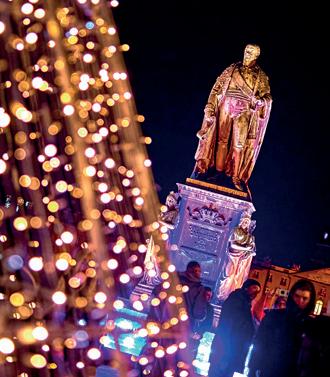
den Heißgetränk zur Genusspause ein.
WEIHNACHTSGENUSS FÜR JUNG UND ALT
Insbesondere Familien lockt es häufig auf den Weihnachtsmarkt: Das Kinderland St. Stephan bietet gerade für die jüngsten Besucher ein märchenhaftes Weihnachtserlebnis. Sie können hier in einer kleinen Dampflok Runden drehen und in den Märchenhäusern bekannte Märchenfiguren entdecken. Abgerundet wird das Erlebnis durch ein abwechslungsreiches Programm mit Ballonkünstlern, Kasperle und Zauberer. Ihre Weihnachtswünsche können Kinder dann direkt beim Christkind abgeben.
AUF WEIHNACHTLICHE ZEITREISE INS MITTELALTER
In Karlsruhes größtem Stadtteil Durlach begeistert der Mittelalterliche Weihnachtsmarkt längst nicht nur Mittelalter-Fans. Inmitten von Feuerkörben, Kerzenlicht, Gauklern und Musikanten, Händlern und Rittern tauchen die Besucherinnen und Besucher ein in eine längst vergangene Zeit. Mittelalterliches Lagerleben, Schaukämpfe, Bogenschießen und eine fantastische Feuershow schlagen Groß und Klein

in ihren Bann. Passend dazu ist das kulinarische Angebot mit Bratwürsten, Schupfnudeln, Fladenbrot und Saubraten, Glühwein und Met entsprechend deftig.
EISLAUFEN IN WINTERLICHER ATMOSPHÄRE
In der Stadtwerke Karlsruhe WINTERZEIT können Anfänger und Fortgeschrittene Eisläufer vor der wunderschönen Kulisse des Karlsruher Barockschlosses und unter romantisch beleuchteten Bäumen ihre Runden drehen, um sich anschließend mit Freunden, Kollegen und Familie beim Eisstockschießen zu messen –ein abenteuerliches Wintererlebnis, das bis zum 25. Januar geöffnet ist.
www.karlsruhe-erleben.de/weihnachtsstadt


On all four Advent weekends, three enchanting Christmas markets invite visitors to enjoy an unforgettable experience along Lake Tegernsee, where festive lights glow and twinkle as far as the eye can see.
During Advent, Tegernsee truly spoils its guests: the Seeadvent in Bad Wiessee, the Rottacher Advent and the Christmas Market at Tegernsee Castle all beckon with artisan treasures and culinary delights in a festive

Alpine atmosphere right on the lakeside. What makes these markets unique is their connection across the water: shuttle boats glide between the towns, their lights dancing on the dark waves. A day ticket also includes the ring-line buses, turning even the journey between the markets, set against the illuminated backdrop, into an experience in itself. The Bavarian Regional Railway offers a stress-free connection from Munich straight to Lake Tegernsee.
At the markets, regional traditions and seasonal indulgences await: skilled artisans such as bauble carvers, candle makers and even an ice sculptor demonstrate their craft. Handmade paper goods, jewellery and ceramics are also on offer. Culinary highlights include bratwurst, raclette rolls, roasted chestnuts and fine local spirits. Atmospheric music from alphorn players and local bands
sets the mood, while romantic firepits invite you to linger. A special highlight takes place on 14 December, when the Inntal Krampusse sweep through the Seeadvent in Bad Wiessee – a spectacle not to be missed.
For those wishing to experience Advent away from the bustle of the stalls, the Tegernsee heritage guides offer fascinating tours in the footsteps of Ludwig Thoma and Karl Stieler, stopping at historic sites, such as Tegernsee Castle, the former abbey church, the picturesque Rosenstraße and the larch forest. Another insider tip: tastings with local distilleries on board the historic TAG 27 railcar, with a blend of nostalgia and regional flavour.
Whether strolling from market to market, taking a horse-drawn carriage ride through the snowy landscape or relaxing in a cosy mountain hut, the magical Advent at Tegernsee brings together tradition, romance and regional charm in a truly unique way.
www.tegernsee.com
Wenn der Tegernsee in den Abendstunden im weihnachtlichen Glanz erstrahlt, entfaltet sich eine ganz besondere Magie: Der Adventszauber am Tegernsee. Gleich drei stimmungsvolle Weihnachtsmärkte laden an allen vier Adventswochenenden zu einem unvergesslichen Erlebnis ein.
Am Tegernsee wird man in der Adventszeit geradezu verwöhnt, denn der Seeadvent Bad Wiessee, der Rottacher Advent und der Weihnachtliche Schlossmarkt Tegernsee locken mit handwerklichen Schätzen und kulinarischen Highlights in weihnachtlich-alpenländischer Atmosphäre direkt am Seeufer. Was die Märkte so besonders macht, ist ihre Verbindung über das Wasser: Pendelschiffe fahren zwischen den Orten hin und her, während ihre Lichter auf den dunklen Wellen tanzen. Im Tagesticket sind auch die Ringlinien-Busse inklusive. So wird schon die Reise zwischen den Märkten mit Blick auf die erleuchtende Kulisse zum Erlebnis. Zum Tegernsee gelangt man stressfrei mit der Bayerischen Regiobahn direkt von München.
Auf den Märkten selbst warten regionale Traditionen und adventlicher Genuss: Kunsthandwerker wie Christbaumkugelschnitzer, Kerzenzieher oder ein Eisschnitzer lassen sich bei ihrer Arbeit über die Schulter schauen. Dazu gibt es Handgemachtes aus Papier, Keramik oder Schmuck. Kulinarisch locken
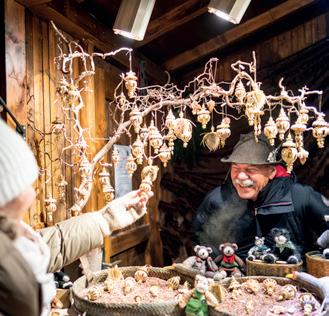


Bratwürstl, Raclettesemmeln, heiße Maroni oder feine Edelbrände aus der Region. Stimmungsvolle Musik von Alphornbläsern und heimischen Musikanten begleitet das bunte Treiben, während romantische Feuerstellen zum Verweilen einladen. Ein Highlight sind die Inntal Krampusse, die am 14. Dezember über den Seeadvent in Bad Wiessee ziehen – ein Spektakel, das man nicht verpassen sollte.
Wer den Advent lieber abseits der Marktstände erleben möchte, kann sich einer Führung der Tegernseer Heimatführer anschließen. Auf den Spuren von Ludwig Thoma und Karl Stieler geht es zu historischen Orten wie dem Tegernseer Schloss, der ehemaligen Klosterkirche oder dem malerischen Lärchenwald. Ein weiterer Geheimtipp sind die Tastingfahrten mit regionalen Destillerien im historischen Triebwagen TAG 27 – Genuss und Nostalgie in einem.
Ob beim Bummeln von Markt zu Markt, einer Pferdekutschfahrt durch die verschneite Landschaft oder beim gemütlichen Hüttenabend: Der Adventszauber am Tegernsee verbindet Tradition, Romantik und regionale Vielfalt auf einzigartige Weise.
www.tegernsee.com

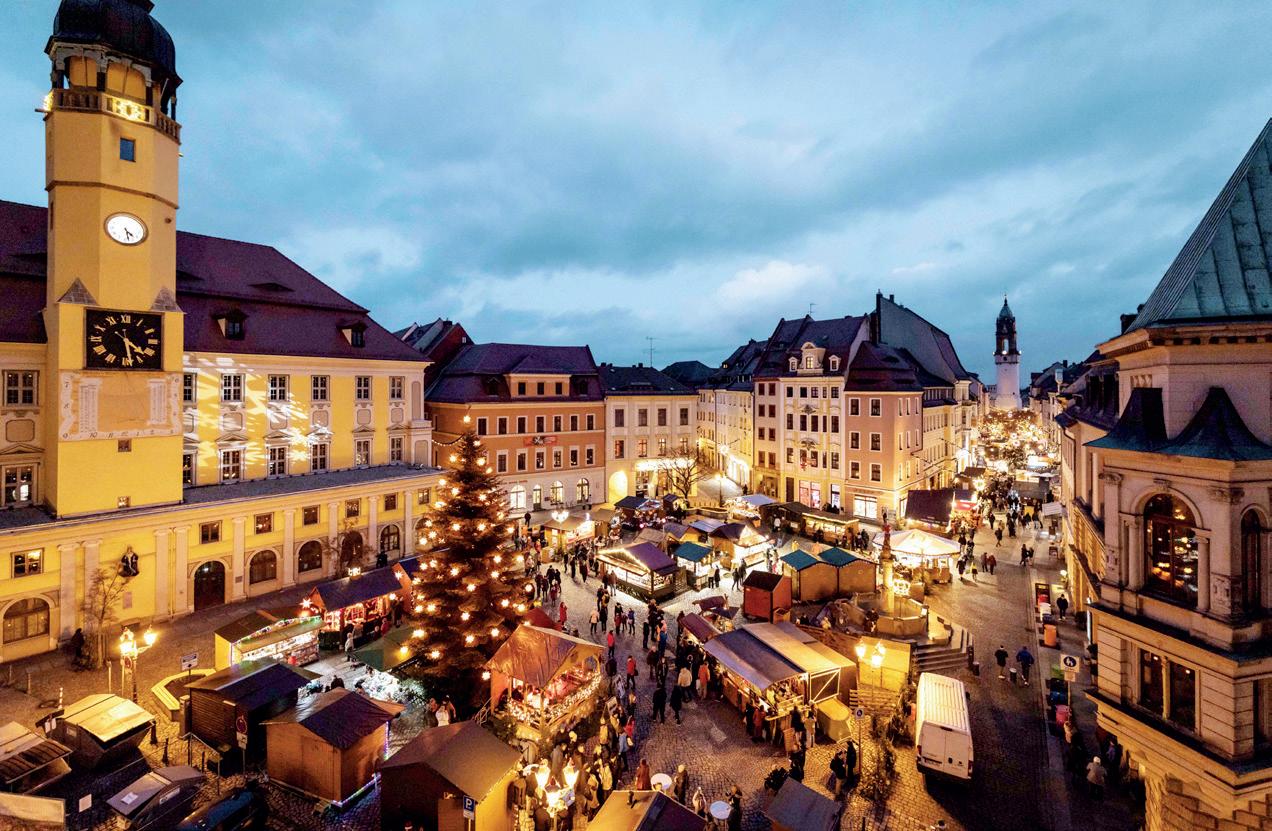
Since 1384, Bautzen Wenzelsmarkt has transformed the romantic old town into a glowing winter fairy tale, making it the oldest Christmas market in Germany. Regional specialities ensure an authentic and cosy Advent experience.
The scent of gingerbread, the distinctive Wenzels mulled wine and freshly baked stollen fills the air. From 28 November to 22 December, anyone strolling through Bautzen’s festively decorated lanes will immediately feel the magic: between medieval towers and historic facades, the Christmas lights sparkle as brightly as the visitors’ faces. Named after King Wenzel IV of Bohemia, who granted Bautzen its market rights back in 1384, Wenzelsmarkt offers a festive blend of history, culture and entertainment. This year, several new highlights await.
The crackling Lichterzauber on the main square, complete with Christmas tree and log fire, invites visitors to pause for a moment. Here you will also find the Christmas crib, the heart of the market, newly designed this year by regional artists. Other fresh additions include the atmospheric Turmweihnacht (Tower Christmas), a silent disco on Kornmarkt
and the festive Wenzelslauf run – new ideas that add a contemporary twist to centuries of tradition. Families will also enjoy a wide range of children’s activities and workshops throughout December, some held in local cultural venues.
Culinary delights are also plentiful. Alongside classic mulled wine, visitors can sample Bautzen’s own creations such as Wenzels mulled wine and Wenzels stollen. Sorbian dishes, hearty sausages and medieval-style grilled meats tempt hungry guests, while enjoying a steaming Feuerzangenbowle with a nostalgic film screening sets the perfect festive mood.
The cultural programme completes the Advent experience: fairy tale readings in Bautzen’s towers, traditional handicrafts, guided tower tours and communal carol singing bring history vividly to life.
Above all, it is the authenticity of Wenzelsmarkt that captivates. Instead of grand spectacle, guests encounter a welcoming old town full of character, where the Christmas spirit feels personal and within reach. The Sorbian culture adds a truly unique regional flavour, making the market unlike any other.
www.bautzen.de
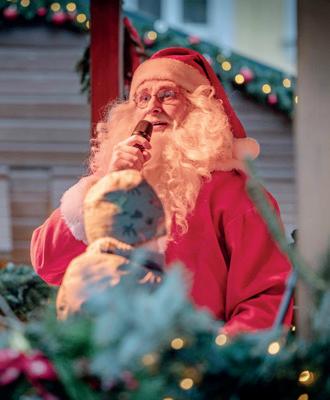
Seit 1384 verwandelt der Bautzener Wenzelsmarkt die romantische Altstadt in ein leuchtendes Weihnachtsmärchen und gilt damit als ältester Weihnachtsmarkt Deutschlands. Regionale Spezialitäten sorgen für ein urig-authentisches Advents-Erlebnis.
Der Duft von Pfefferkuchen, vom besonderen Wenzelsglühwein und frischem Stollen liegt in der Luft. Wer vom 28. November bis 22. Dezember durch die festlich geschmückten
Gassen Bautzens spaziert, spürt sofort den besonderen Zauber: Zwischen mittelalterlichen Türmen und historischen Fassaden strahlen die Weihnachtslichter mit den Gesichtern der Besucher um die Wette. Der älteste Weihnachtsmarkt Deutschlands, benannt nach dem böhmischen König Wenzel IV., der Bautzen bereits im Jahr 1384 ein Marktrecht verlieh, bietet eine festliche Mischung aus Geschichte, Kultur und Unterhaltung. Dieses Jahr warten zudem neue Höhepunkte darauf, entdeckt zu werden.
Der knisternde Lichterzauber am Hauptmarkt mit Weihnachtsbaum und Lagerfeuer

lädt zum Innehalten ein, denn hier findet sich auch die Weihnachtskrippe, das Herzstück des Marktes, die gerade von regionalen Künstlerinnen und Künstlern neugestaltet wurde. Ebenfalls neue Programmpunkte sind die Turmweihnacht, eine Silent-Disko auf dem Kornmarkt und der festliche Wenzelslauf - frische Ideen, die das jahrhundertealte Geschehen perfekt auflockern. Familien können sich über diverse Mitmachangebote für Kinder freuen, die im gesamten Dezember auch in städtischen Einrichtungen stattfinden.
Auch kulinarisch bleiben keine Wünsche offen: Neben klassischem Glühwein gibt es Bautzener Besonderheiten wie den Wenzelsglühwein oder den Wenzelsstollen. Sorbi-
sche Küche, würzige Bratwürste und mittelalterliches Grillgut stillen große wie kleine Gelüste, während eine dampfende Feuerzangenbowle zu nostalgischen Filmklassikern für die perfekte Weihnachtsstimmung sorgt.
Das kulturelle Programm rundet den Advent stimmungsvoll ab: Märchenlesungen in den Bautzener Türmen, traditionelle Handwerkskunst, Turmführungen und gemeinsames Adventsliedersingen lassen Geschichte und Gegenwart lebendig werden.
Auf dem Wenzelsmarkt ist es vor allem die Authentizität, die überzeugt. Statt großer Inszenierungen erwartet die Gäste eine gemütliche Altstadt voller Charakter, in der Weihnachtszauber persönlich und nahbar bleibt. Zudem verleiht die sorbische Kultur dem Markt eine unverwechselbar regionale Note.
www.bautzen.de


Der Freiberger Christmarkt zählt mit seinen gelebten erzgebirgischen Traditionen zu den schönsten Weihnachtsmärkten Deutschlands.
Authentisch und geheimnisvoll: Auf dem ‚Freiberger Christmarkt‘ im Weihnachtsland Erzgebirge werden bergmännische Traditionen und Brauchtum lebendig. Eine UNESCOWelterbe-Altstadt, Orgelkonzerte und glänzende Minerale gibt’s oben drauf!
Schwibbbögen, Räuchermännchen, Christstollen, verschneite Tannenwipfel – mitten im Weihnachtsland Erzgebirge lädt der Freiberger Christmarkt vor historischer Kulisse ein, bergmännisches Brauchtum zu erleben, nach erzgebirgischer Holzkunst zu stöbern und die Adventszeit entspannt und gemütlich zu genießen. Das Gesicht der mittelalterlichen Altstadt – Teil der UNESCO-Welterbe Montanregion Erzgebirge/ Krušnohoří – ist geprägt von mehr als 800 Jahren Silberbergbau, der Ruhm und Glanz für ganz Sachsen brachte. Und noch heute sind die Traditionen der Bergleute hier spürbar und erlebbar: Im Winterhalbjahr wird es geheimnisvoll und gemütlich in der Silberstadt.

Kulturdenkmale von europäischem Rang: Die Begräbniskapelle der Wettinischen Kurfürsten im Dom St. Marien kann bei thematischen Führungen besichtigt werden.
GENUSS PUR: ERZGEBIRGISCHER WEIHNACHTSMARKT
Der traditionsreiche bergmännische Christmarkt – einer der schönsten Weihnachtsmärkte Deutschlands – öffnet ab 25. November bis 22. Dezember in der festlich beleuchteten Altstadt täglich seine Pforten. Rund 90 liebevoll ausgestaltete Holzhütten sind sowohl bergmännisch dekoriert, als auch in ihrem Angebot eng mit der Historie der Silberstadt verbunden. So sorgt der ‚Schmelzer‘, der früher das Erz zu Silber schmolz, heute für leckeren Erzgebirgs-Glühwein. Engel und Bergmann grüßen an vielen Ecken und auch von der 8 Meter hohen Holz-Pyramide, auf der sich Figuren der Bergparade drehen. Lebendig werden die erzgebirgischen Traditionen beim Stollenfest am 30. November, zur Bergparade im Fackelschein mit Bergpredigt am 6.Dezember, beim Fest des Bergmanns am

14.Dezember oder beim Einläuten der Weihnachtsruhe mit Bergknappe Daniel zum Abschluss am 22. Dezember.
Zum gemütlichen Weihnachts-EinkaufsBummel laden über 250 Geschäfte in die geschmückten Altstadt-Gassen ein, am 1. und 3.Advent mit verkaufsoffenen Sonntagen.
Die Eisbahn im Schloss Freudenstein, Weihnachtsausstellungen, Bach-Oratorium im Dom. St. Marien und Erlebnis-Stadtführungen, wie die romantische Laternenwanderung, die amüsante Tour ‚Silberklang und Berggeschrey‘ oder ein Rundgang mit dem Nachtwächter runden den Silberstadt-Advent ab.
PRÄCHTIG: DOMSCHÄTZE & HIMMLISCHE ORGELKL ÄNGE
Darüber hinaus beeindruckt Freiberg vor allem mit historischer Kulisse und Kultur – als Partner der Kulturhauptstadt Chemnitz 2025. Im imposanten Dom St. Marien faszinieren Kulturdenkmale von europäischem Rang: die Grablege der Wettiner, die Goldene Pforte und die weltberühmten Silbermann-Orgeln – denn Silber spielt in Freiberg auch in der Musik eine große Rolle. Mit ihrem einzigartigen Klang locken sie nicht nur Musikfreunde, sondern auch Organisten aus der ganzen Welt nach Freiberg, u.a. zum Orgelfestival ‚SilbermannTage‘ aller zwei Jahre im September.
GLÄNZEND: MINERALOGISCHE SCHÄTZE UND KULTUR IM SCHLOSS ENTDECKEN
Im Schloss Freudenstein glänzen in der wohl größten und schönsten Mineralienschau terra mineralia 3.500 Mineralien, Edelsteine und Meteoriten. Im Sommer wird es zum

kulturellen Zentrum der Silberstadt mit OpenAir Konterten, Theater und Filmnächten. In Freibergs Theater – dem ältesten Stadttheater der Welt – hebt sich fast täglich der Vorhang bei Philharmonie-Konzerten, Musicals oder Schauspielen.
GEHEIMNISVOLL: UNTER-TAGE-WELT ERKUNDEN
Wie ein echter Bergmann fühlen können sich Besucher bei einer Einfahrt ins Silberbergwerk –in 150 Metern Tiefe. Noch mehr BergbauErlebnis hält die multimediale Unter-Tage-Welt in der ‚Silbernen Pforte‘, dem neuen Anbau des Stadt- und Bergbaumuseums, bereit. Auch spannende Sonderausstellungen, wie die zu Sachsens Kurfürst August, können erkundet werden.
AKTIV: ERLEBNISWEGE MIT
SILBERFIGUREN ZUM ANFASSEN
Erkunden lässt sich Freibergs Altstadt am besten auf den zwei neuen Erlebnis-Wegen Entdecker-Spur und Silberweg. Überlebensgroße Silberfiguren erzählen Freibergs Geschichte(n). Der Rätsel-Block auf Deutsch und Englisch sowie die App bieten allerhand Wissenswertes und Spaß für Groß und Klein.
GEMÜTLICH: BUMMELN, STÖBERN UND KÖSTLICHES GENIESSEN
Auch zum Bummeln, Einkaufen und Genießen lädt Freiberg ein. Geschäfte und Boutiquen, kleine Weinbars, urige Restaurants und gemütliche Cafés, u.a. im Wiener-Café-Haus-Stil, stehen zur Auswahl. Probieren sollten Naschkatzen dort unbedingt die Spezialität ‚Freiberger Eierschecke‘. Der süße Kuchen ist einer
Legende nach entstanden, weil Baumaterial zum Ausbessern der Stadtmauer fehlte und die Baumeister kurzerhand Quark als Ersatz nutzten. Da dieser dann zum Backen fehlte, ersetzten ihn die pfiffigen Freiberger Bäcker durch Butter, Zucker und Rosinen. Am besten schmeckt sie, wenn sie ‚schööön looofsch‘ fast vom Blech läuft.
FAZIT: EINE REISE WERT!
Die Silberstadt zählt schon lange zu den schönsten Städten Sachsens. Mit ihrer historischen Altstadt und gelebten Kulturszene gilt sie als kleiner, feiner Geheimtipp zum Entdecken und Genießen.
Buchen Sie jetzt Ihren Urlaub in der Silberstadt Freiberg: www.freiberg.de/tourismus
Freiberger Christmarkt: www.freiberger-christmarkt.de



25.Nov. – 22. Dez. 2025
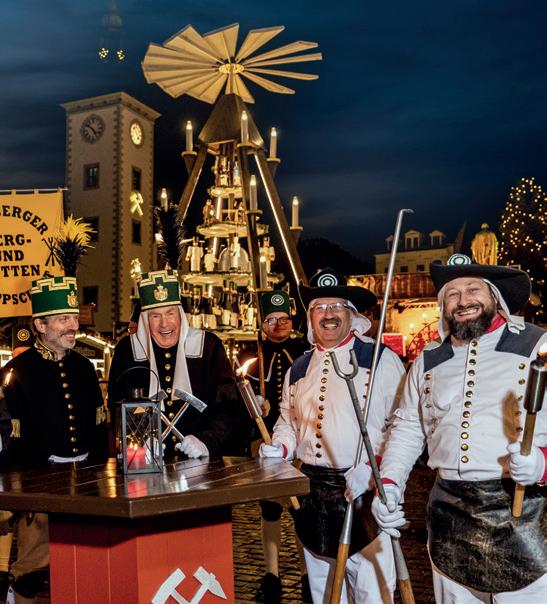
Ursprünglich und gemütlich: Gemütliches Weihnachtsshopping in der Altstadt Stollenfest 30.11. Bergparade 6.12.
Erzgebirgische Traditionen und Bräuche erleben Köstliches genießen
freiberger-christmarkt.de

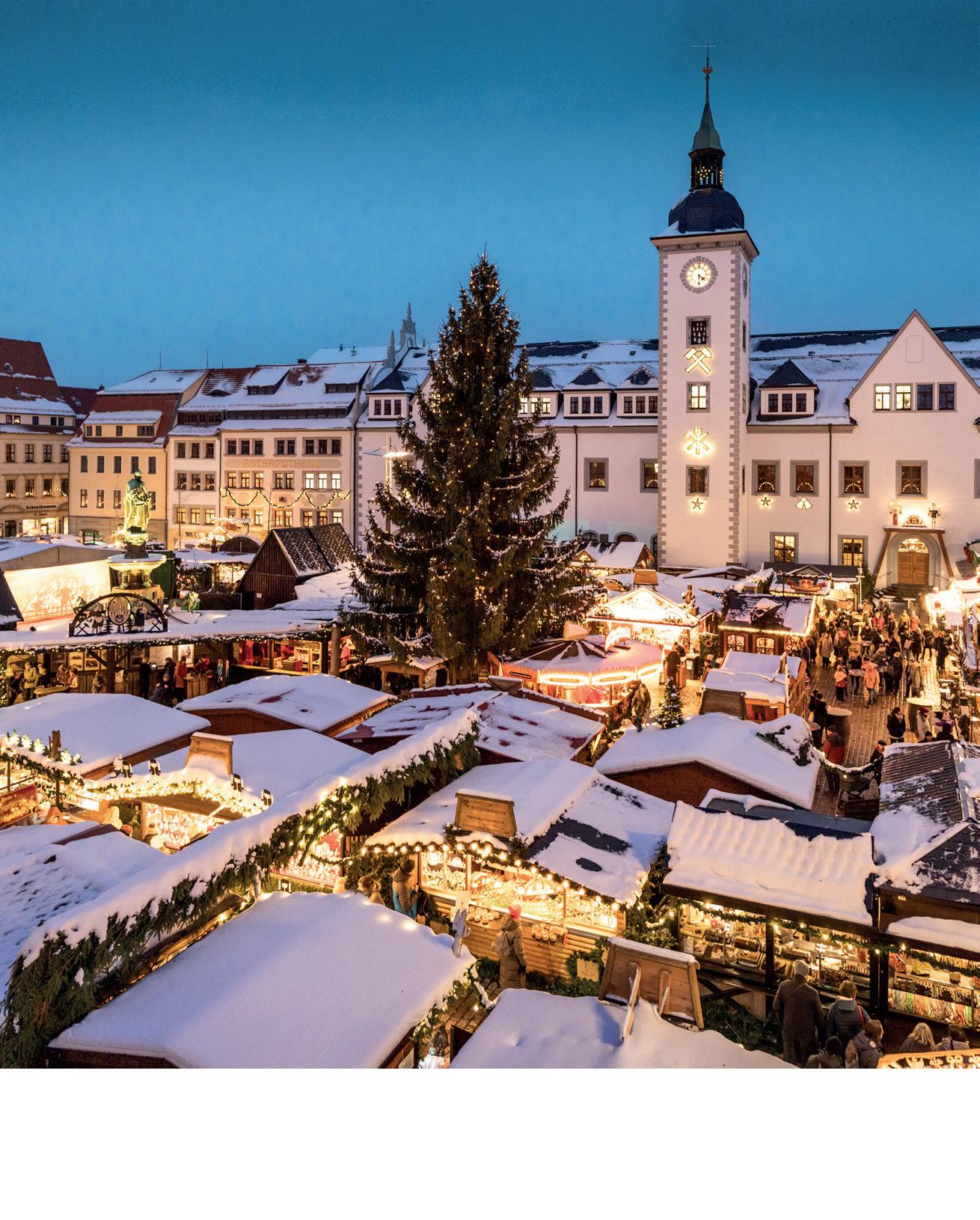
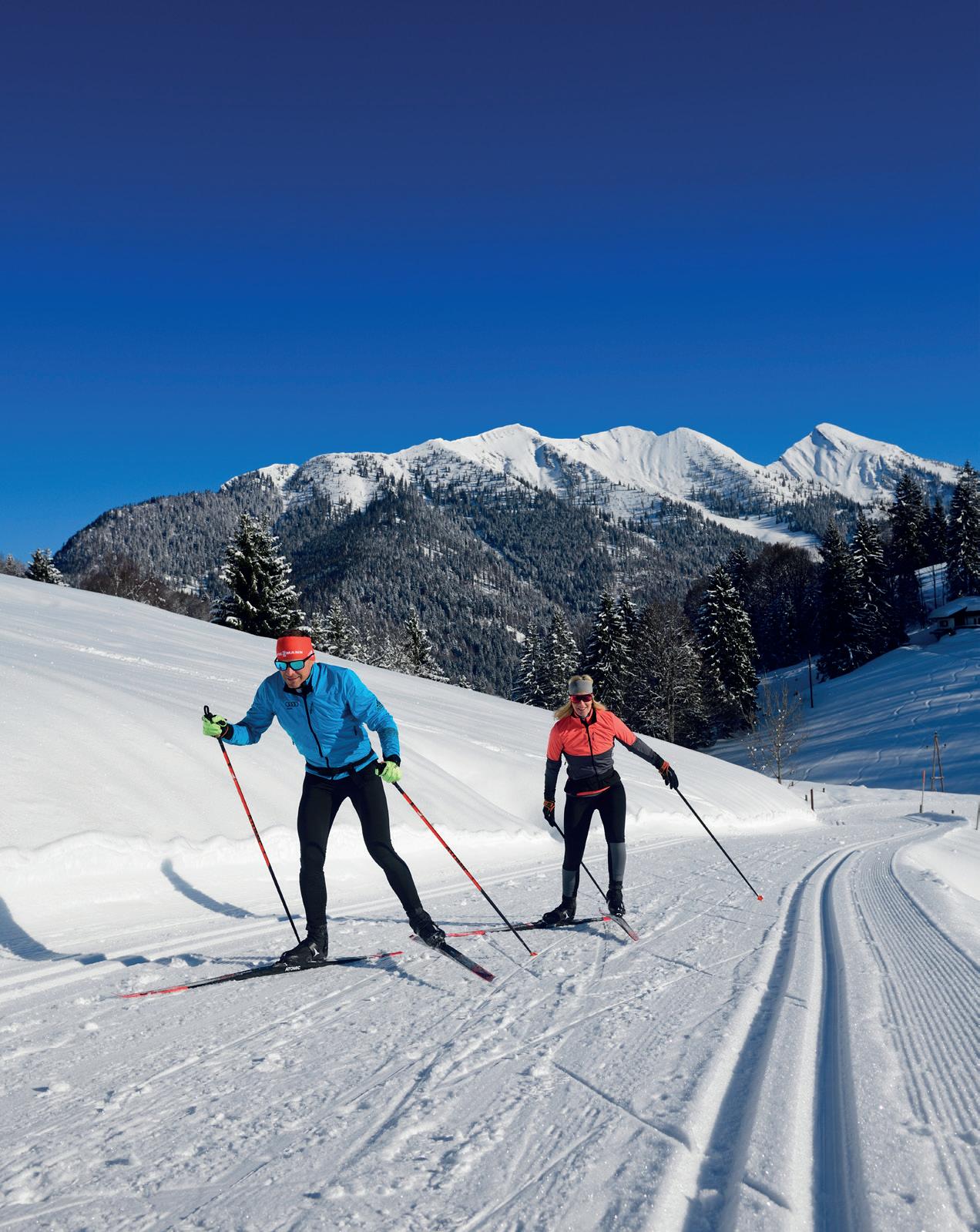
With the Nordic Plus concept, Reit im Winkl in Upper Bavaria has created a versatile crosscountry skiing circuit with rustic rest stops and magnificent views. Tobias Angerer, one of the most successful German cross-country skiers of the 21st century and former overall World Cup winner, has already tested the route. We explored the trail with the four-time Olympic medallist.

"Even back then, as an active competitor, I enjoyed training on the trails around Reit im Winkl,” says Tobias Angerer. “The magnificent landscape of the Chiemgau Alps always motivated me. And I was able to recharge my batteries in the many cosy mountain huts. But as a cross-country ski professional, I mostly had to focus on the trail, my heart rate monitor, and my lactate level." The multiple overall World Cup winner and Olympic medallist adds almost lyrically: "Today, I can let my gaze wander over the landscape, the snow-covered Sonntagshorn mountain, the sparkle of the snow crystals in the backlight, the fir trees with their heavy snow loads – I can absorb all of this wonderful nature.”
“I'm also consciously perceiving this massive rock face here with its enormous icicles, right on the ascent from Seegatterl, for the first time today. Wow… I'm falling head over heels in love with my hometown again," Tobias enthuses with a wink, and gives his wife Romy a big kiss on the cheek. Romy Angerer is also a top-class cross-country skier and equally enthusiastic about Reit im Winkl's new Nordic Plus concept.
But first things first. Reit im Winkl enjoys three different altitudes where winters are usually longer and snowier. Additionally, the meteorological phenomenon of cold air lakes usually results in increased snowfall. And indeed, the Maserer Pass often forms the border in winter. While green still dominates
the landscape on this side, a wintery atmosphere already prevails on the other side in the microclimate of Bavarian Siberia. Ever since Rosi Mittermaier won numerous medals at the 1976 Olympic Games in Innsbruck, Winklmoos Alm and Reit im Winkl have been household names in winter sports.

The fun of skiing on two narrow skis also has a long tradition in the Chiemgau region. As early as 1964, Germany's first cross-country ski trail was signposted in the neighbouring town of Ruhpolding. Just one year later, the first fun run took place. In 1969, the company Plenk founded Germany's first cross-country ski school and was long considered one of the world's best ski manufacturers.
The Chiemgau region has always provided exemplary support for Nordic sports enthusiasts. From novices to advanced skiers to professionals, everyone can enjoy a variety of around 500 kilometres of cross-country ski trails. The heart of the region is the Chiemgau Marathon Trail. It runs 35 kilometres from Reit im Winkl via Ruhpolding to Inzell. "Yes, the Chiemgau Marathon Trail is also a gem," Tobias and Romy confirm. "We particularly like the section between the Lödensee, Mittersee, and Weitsee lakes, the so-called Three Lakes Region. Sometimes you really feel like you're in Canada or Alaska," Tobias enthuses. "My insider tip is the Hemmersuppenrunde above the Hindenburghütte – a magnificent loop with a panorama that will give you goosebumps.”
“And the hut's owner, Günter Dirnhofer, has more than just a knack for the trail on the plateau. What he and his team conjure up from the wood-fired oven is truly magnificent: hearty roasts, delicious strudel... and when the multi-instrumentalist plays along with his fellow musicians, you have to be extremely careful that your training days don’t drag on unexpectedly," he adds with a laugh.
Reit im Winkl has once again made a major effort for Nordic fans for the coming season. One example: in the Nordic and Biathlon Park, with its large cross-country stadium on the edge of town, what is believed to be the world's first children's cross-country ski trail will reopen at the start of the season. Standard cross-country ski trails force small children into an unnatural position due to the excessively wide stride width. However, to ensure that little ones have unadulterated fun with cross-country skiing right from the start, the Reit im Winkl cross-country ski trail managers have come up with an idea. In cooperation with Kässbohrer, the manufacturer of snow groomers, they have developed a special, narrower track plate for kids. In addition to the existing biathlon shooting range, the
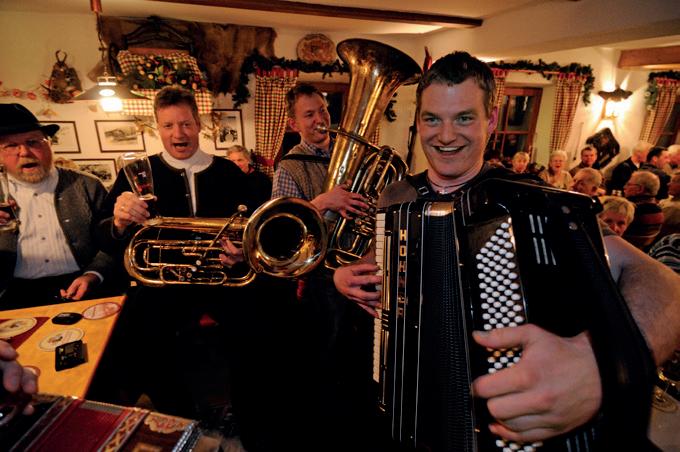


Nordic Park will be expanded to include kickers, bumps, and foam children's figures. This way, cross-country skiing technique is learned in a playful way, and later, it will also work with fast downhill runs on the cross-country ski trail. Several times a week, the entire facility is floodlit to provide the best training opportunities for ambitious cross-country skiers, young and old alike. Here, playful fun blends with outstanding early childhood development. Perhaps we will soon see Olympians from the Chiemgau region again?
The Nordic Plus concept reveals yet another winter sports highlight; the already extensive cross-country skiing offering has been extended. Instead of completing multiple fixed circuits, the map has been meticulously studied, and the planners have even gone cross-border. Existing trails in the Chiemgau Alps have been ingeniously linked with the neighbouring Salzburg trails in the Heutal valley. With the optional assistance of shuttle buses, the Seegatterl gondola, and the drag lift up to Wildalm, a further network of options was created. The Sport Genuss circuit ends after 28 kilometres and 200 metres of ascent. Three further sporting variants for bronze, silver, or gold require stamina for 39 kilometres and 450 metres
of elevation gain, and 45 kilometres and 890 metres of elevation gain. Those aiming for gold and completing the entire circuit using fair means, that is their own muscle power, will return to the stadium after a remarkable 50 kilometres and 1,250 metres of elevation gain, guaranteed to have a puffed-out chest and properly sore thighs.
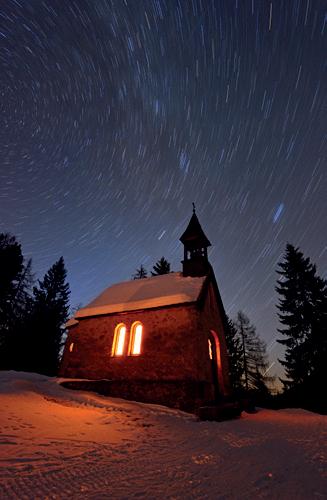
Back on the trail, the Angerer couple takes it easy on their test tour and opts for the bronze option. After a warm-up phase from the stadium in Reit im Winkl, through the snow-covered enchanted forest to Seegatterl, they float comfortably up to the Winklmoosalm in the gondola. "Actually, we could stop at Almstüberl right now. The Kaiserschmarrn there is so fluffy, it melts in your mouth," Tobias enthuses. "But first, let's get a few kilometres under our belts," he laughs, pushing hard with a double-pole push. The trail opens up to a true winter wonderland. The view stretches far over the white-clad hills back to Wilder Kaiser, which dominates the plain like a monolith, across to Loferer Steinberge and all the way to the striking cliffs of Watzmann and Hochkalter, the top dogs of the Berchtesgaden Alps. The perfectly groomed trail connects the Chiemgau region via the hamlet of Moarlack with the Heutal valley in Salzburg.
The steep climb up to Wildalm can be made easier with the rustic drag lift. There, a magnificent panorama unfolds on the south-facing terrace while enjoying a non-alcoholic wheat beer and hearty bacon or cheese dumplings. Beware: the homemade apple
strudel and steaming coffee might tempt you to slack off. At the foot of Dürrnbachhorn, a beautifully curved trail leads back to Winklmoosalm, where the downhill run to Seegatterl beckons. Gold hopefuls will have to muster up some calf power for the 8 kilometres back to the Reit im Winkls stadium, but a free shuttle bus is also available for the return trip.
Tobias and Romy are in the flow and quickly zip back to the Nordic Park. "Nordic Plus is phenomenally addictive. The constantly changing landscape provides a true Transalpine experience," Tobias enthuses. "Not to mention the many variations for all fitness levels and all the rustic huts with delicious snacks," adds Romy with a laugh and gives a big thumbs-up.
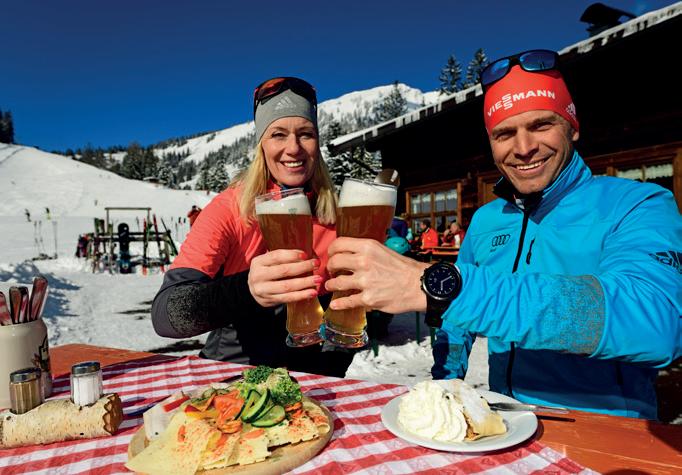

More information:
www.reitimwinkl.de/nordic-plus Where to eat: www.hindenburghuette.de www.sonnenalm.de www.almstueberl.de
Do not miss:
From 24 January to 1 February 2026, Reit im Winkl's Rauszeit will take place at the cross-country ski stadium. The nine-day cross-country skiing event features a 24-hour race, team trophy, waxing class, fashion show, food trucks, and advice from Nordic pros.

As the days grow shorter and a brisk chill creeps into the air, Tirol in the western Austrian Alps transforms into a mesmerising winter wonderland. With around 26.4 million overnight stays registered during the 2024/25 winter season in Tirol alone, the region is sure to captivate all those who venture into its Alpine embrace.
PHOTOS: PIXABAY
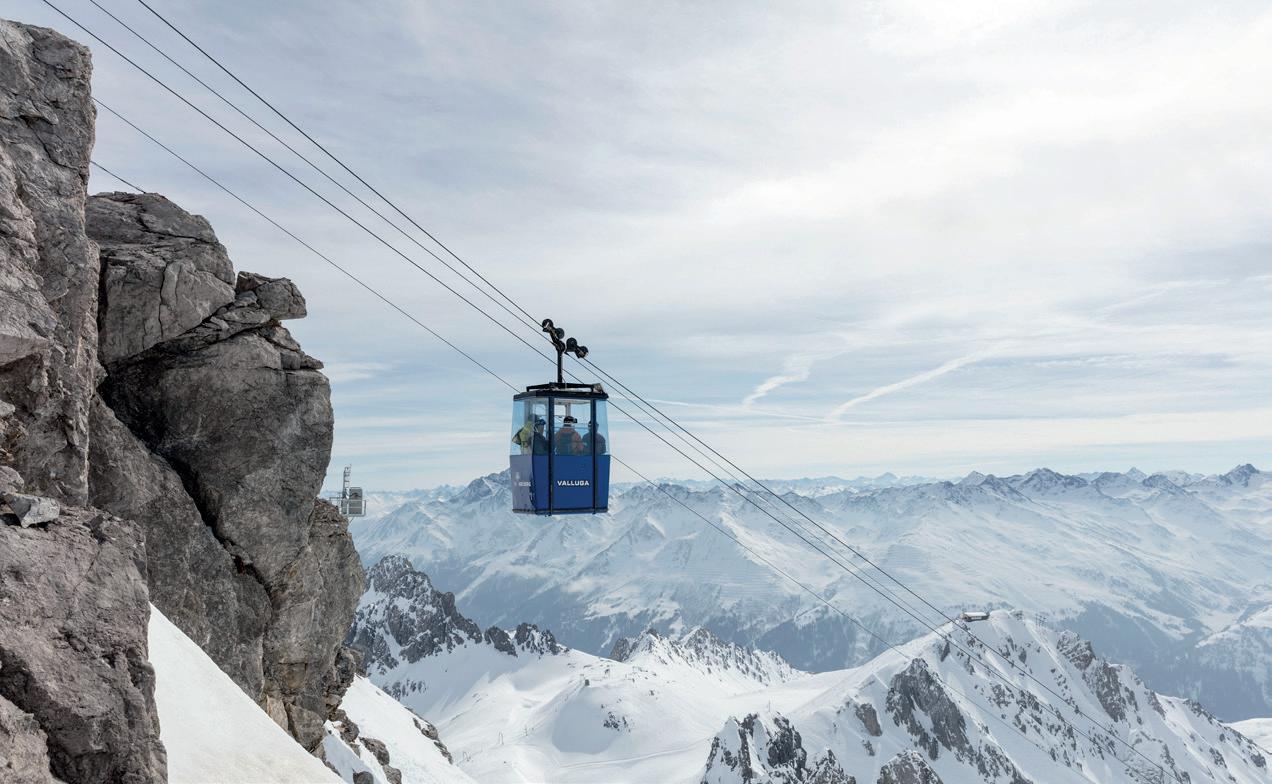

“Tirol truly stands out as a winter destination because of its combination of breathtaking natural beauty, exceptional infrastructure, and the sheer variety of activities it offers. Our alpine landscapes provide the perfect setting for winter sports, but they’re also ideal for those looking to unwind and connect with nature,” says Nicole Ortler, head of Competence Centre for Sustainability at Tirol Werbung in an interview with Discover Germany, Switzerland & Austria. “From world-class ski resorts with reliable snow conditions to welcoming accommodations, Tirol is dedicated to providing an outstanding experience for every visitor,” she adds.
For those who simply cannot get their fill of skiing, Tirol’s five glaciers serve up exceptional snow conditions from autumn right through to late spring. In fact, Hintertux stands out as a true gem, with its pistes welcoming enthusiasts every single day of the year. Boasting over 80 ski resorts and an impressive 3,000 kilometres of slopes, Tirol is nothing short of a winter sports utopia.
Set at the very heart of the Alps, the region tempts skiers, snowboarders, freeriders, and freestylers with a dazzling array of pistes, pristine backcountry terrain, and lively snow parks. Novices are in safe hands thanks to the province’s well-established ski
schools, while several resorts are thoughtfully designed with mono-skiers and families in mind. Away from the slopes, Tirol excels with its winter walking trails, extensive cross-country routes, and a wealth of toptier hotels and restaurants. Add in the fam-
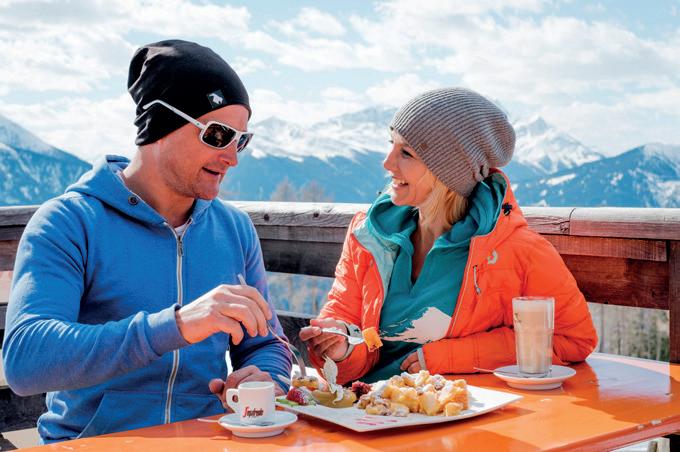
ily-friendly activities on offer, and it is clear why Tirol shines as a premier destination for an unforgettable winter escape.
Ski resorts and lift companies are becoming increasingly committed to resource-efficient operations in winter tourism. Every year, the Tirolean cable car companies invest heavily in modernising their facilities and the use of renewable energy. Ortler explains: “Sustainability is at the heart of Tirol’s tourism strategy, and we’re taking active steps to reduce the environmental footprint of winter sports. One of our main focus areas is transportation. We’ve enhanced public transport networks to make travel to Tirol easy and eco-friendly.”
“Like other alpine regions, Tirol has seen the effects of climate change, but we’re fortunate that snow reliability remains high in many of our ski resorts. We’ve noticed a shift towards higher-altitude skiing, which has led us to invest in diversified tourism options. Winter hiking, cultural events, and wellness experiences are increasingly popular, allowing guests to enjoy a rich winter holiday experience beyond the slopes,” adds Ortler.

Whether snowshoeing through snow-covered forests, winter hiking to secluded vantage points or tobogganing with a stop for refreshments at a rustic mountain hut, it is easy to holiday in harmony with nature in Tirol and still enjoy all that winter has to offer. Many Tirolean regions have made a conscious decision to specialise in sustainable winter tourism and provide their guests with a range of nature-based activities.
“We’re encouraging guests to explore alternative activities such as winter hiking and snowshoeing, which have a smaller eco-
logical impact and connect people with the natural beauty of Tirol,” explains Ortler. “While skiing will always remain central to Tirol’s winter tourism, the future lies in offering a diverse and sustainable range of experiences all year round. Guests today are looking for more than just the slopes. They seek winter hikes, wellness retreats, and authentic culinary adventures.”
For some of the exciting winter highlights Tirol has to offer, read the following special theme.

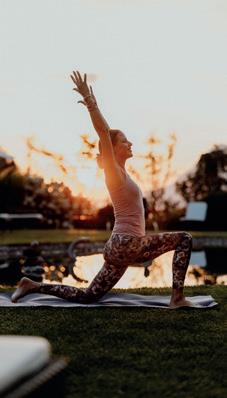

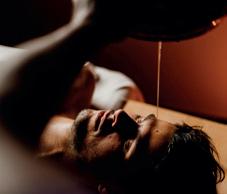

In the heart of Austria’s Tyrolean mountains lies European Ayurveda Resort Sonnhof, which, as a pioneer of European Ayurveda®, sets new health standards.
Founded by the Naschberger-Mauracher family in 1987, the resort combines millennia-old Ayurvedic wisdom with a European lifestyle. "The basic idea was to create a place for lasting health, regeneration, and spiritual balance," explains Elisabeth Naschberger-Mauracher, CEO and founder of European Ayurveda Resort Sonnhof where the European Ayurveda® concept was developed.
European Ayurveda® combines the principles of classical Ayurveda with modern insights from medicine, psychology, and nutritional science. "This approach holistically cleanses the body and mind, strengthens inner balance, and is easily integrated into everyday life," says Naschberger-Mauracher.
Guests can expect personalised guidance from experienced Ayurveda experts and a diverse range of AyurDetox programmes, Pancha Karma and wellness treatments, yoga, meditation, and individual coaching. Saunas, massage rooms, the on-site organic farm, yoga area, panoramic pool, and the Garden of the Five Elements with a rose garden, a biotope, and chakra sites round up the offering. The focus is on longevity, which at Sonnhof doesn't mean medical interventions, but rather processes that sustainably strengthen one’s health.
And for those who want to practice Ayurveda at home, the innovative European Ayurveda® Home App makes Ayurveda now accessible in everyday life.
www.sonnhof-ayurveda.at
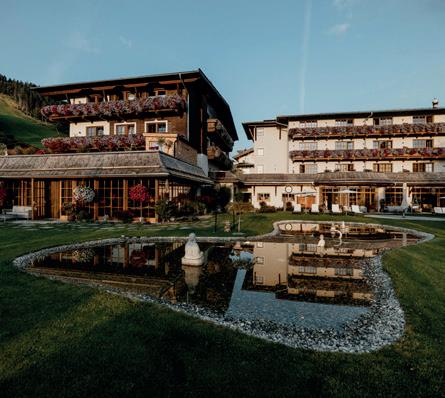
Im Herzen der Tiroler Bergwelt in Österreich liegt das European Ayurveda Resort Sonnhof, das als Vorreiter des European Ayurveda® neue Maßstäbe für Gesundheit setzt.
Gegründet von der Familie Naschberger-Mauracher in 1987, verbindet das Resort heute jahrtausendealte ayurvedische Weisheiten mit europäischer Lebensart und regionalem Charakter. „Der Grundgedanke war, einen Kraftplatz für nachhaltige Gesundheit, Regeneration und seelisches Gleichgewicht zu schaffen”, erklärt Elisabeth Naschberger-Mauracher, CEO und Gründerin des European Ayurveda Resorts Sonnhof.
Besonders ist der Sonnhof, weil hier das Konzept European Ayurveda® entwickelt wurde, das Prinzipien der klassischen AyurvedaLehre mit modernen Erkenntnissen aus Medizin, Psychologie und Ernährungswissenschaft vereint. „Dieser Ansatz reinigt Körper und Geist ganzheitlich, stärkt die innere Balance und ist gleichzeitig leicht in den Alltag integrierbar”, sagt Naschberger-Mauracher.
Gäste erwartet eine persönliche Begleitung durch erfahrene AyurvedaExperten und ein vielseitiges Angebot aus AyurDetox-Programmen, Pancha-Karma-Kuren, Wellnessanwendungen, Yoga, Meditation und individuellen Coachings. Saunen, Massageräume, der hauseigene Bio-Bauernhof, Yoga-Bereich, Panorama-Pool und der ‚Garten der fünf Elemente’ mit Rosengarten, einem Biotop und Chakrenplätzen runden das Angebot ab. Der Fokus liegt auf Longevity, das im Sonnhof nicht für medizinische Eingriffe, sondern bewusste Prozesse steht, die die Gesundheit nachhaltig stärken.
Und für diejenigen, die Ayurveda auch zu Hause umsetzen wollen, macht die innovative European Ayurveda® Home App Ayurveda für jeden Alltag zugänglich.

Private studios and suites, a fantastic, relaxing wellness area, a generous breakfast buffet with regional products, and a caring host family: the new Alpin – Studios & Suites in Warth am Arlberg in Austria is the right place for mountain enthusiasts to fully embrace everything the Alps have to offer.
“We are located in a beautiful mountain and snow paradise, with ski lifts next to the house and guaranteed fun on the slopes well into spring," says host Belinda Fritz about the accomodation at 1,500 metres. In Warth, guests find the best conditions for skiing in winter and hiking in summer. Next to peaks of over 2,500 metres, the 125-kilometre-long Lech Trail runs directly through the region –from the river source in Vorarlberg to Lechfall in Füssen. Adventurers looking for an extra challenge can tackle one of the various fixedrope routes or canyoning tours. Clear, blue mountain lakes offer the ideal environment for deep relaxation.
EXPERIENCED MOUNTAIN GUIDES AS HOSTS
The Fritz host family is closely connected to the mountains. “My husband Mathias, his
brother Christian, and their father Gebhard are all passionate, state-certified mountain guides, and have been for decades,” says Belinda Fritz. “Their mother Maria was also an active hiking guide for many years, and as of last year, I can call myself a qualified Vorarlberg hiking guide as well.” A wealth

of mountain knowledge. “This is unique in Warth, as there is nobody else with so many mountain and hiking guides in one family,” Belinda Fritz proudly adds.
Belinda and her husband Mathias are passionate hosts who look after their guests with sensitivity and the necessary distance. “Our guests can move freely through the house; everything is easy to understand, and guests quickly feel at home,” says Belinda Fritz. “What pleases us most is the gratitude and appreciation of our guests.” No wonder that the Studios & Suites have an outstanding rating of 9.7 on Booking.com and reach the highest average of 5.0 on Google.
In addition to their experience as mountain guides, the family looks back on a long tradition as hosts. Mathias's parents ran the house as a Bed & Breakfast for mountain guests since 1980. “With a lot of love and
Private Studios & Suites, ein toller Wellness-Bereich zur Entspannung, ein reichhaltiges Frühstücksbuffet mit regionalen Produkten und eine fürsorgliche Gastgeberfamilie: Im neuen Alpin – Studios & Suites im österreichischen Warth am Arlberg sind Bergbegeisterte an der richtigen Adresse, um die Alpen in vollen Zügen zu genießen.
„Wir liegen in einem wunderschönen Bergund Schneeparadies, mit den Skiliften in unmittelbarer Nähe zu unserem Haus und einem garantierten Pistenvergnügen bis ins Frühjahr hinein”, erzählt Gastgeberin Belinda Fritz über die Unterkunft auf 1.500 Metern. Gäste finden hier in Warth die besten Bedingungen für Skisport im Winter und Wanderungen im Sommer. Neben Gipfeln mit über 2.500 Metern Höhe, zieht sich der 125 Kilometer lange Lechweg direkt durch die Region – von der Quelle des Lechs in Vorarlberg bis hin zum Lechfall in Füssen. Abenteuerlustige kommen auf verschiedenen Klettersteigen oder Canyoning-Touren auf ihre Kosten. Klare, blaue Bergseen bieten die ideale Umgebung zur Tiefenentspannung.
ERFAHRENE BERGFÜHRER ALS GASTGEBER: DIE BERGE MIT PROFESSIONELLER FÜHRUNG ERKUNDEN
Die Gastgeberfamilie Fritz ist eng mit den Bergen verbunden. „Mein Mann Mathias, sein
Bruder Christian und ihr Vater Gebhard sind allesamt leidenschaftliche, und staatlich geprüfte Bergführer, und das schon seit Jahrzehnten”, erzählt Belinda Fritz. „Ihre Mutter Maria war ebenso jahrelang als Wanderführerin aktiv und auch ich darf mich seit letztem Jahr als ausgebildete Vorarlberger Wanderführerin bezeichnen.“ Ein geballtes Bergwissen. „Das ist eine Einzigartigkeit in Warth, denn so viele Berg- und Wanderführer innerhalb einer Familie gibt es tatsächlich nur bei uns“, ergänzt Belinda Fritz stolz.
Belinda und ihr Mann Mathias sind Gastgeber aus Leidenschaft und umsorgen ihre Gäste mit viel Feingefühl und der nötigen Distanz. „Unsere Gäste können sich in unserem Haus sehr frei bewegen, alles ist leicht verständlich und man kommt sehr schnell sehr gut zurecht”, sagt Belinda Fritz. „Was uns am meisten erfreut ist die Dankbarkeit und Wertschätzung unserer Gäste.“ Kein Wunder also, dass die Studios & Suites auf booking.com eine herausragende Bewer-

tung von 9.7 haben und auf Google sogar den Höchstschnitt von 5.0 erreichen.
LANGE ERFAHRUNG ALS GASTGEBER IN FAMILIÄRER ATMOSPHÄRE
Neben der Erfahrung als Bergführer, blickt die Familie auf eine lange Tradition als Gastgeber zurück. Mathias‘ Eltern führten das Haus seit 1980 als Frühstückspension für Gäste am Berg. „Mit ganz viel Liebe und Herzblut verwöhnte Maria unzählige Gäste aus Nah und Fern”, erzählt Belinda Fritz. Belinda und Mathias übernahmen das Haus offiziell 2017 und schon bald wuchsen in ihren Köpfen neue Ideen zur Zukunft des ‚Haus Alpin‘. Während der CoronaPandemie setzten sie diese Ideen in die Tat um.
EIN UMBAU, DER DEN TRADITIONEN UND DER GESCHICHTE GERECHT WIRD „Nachdem unsere Eltern so viel Engagement in dieses Haus gelegt hatten, kam es für uns nie in Frage, es gänzlich dem Erdboden gleich zu machen und ein komplett neues Gebäude zu errichten”, erzählen Belinda und Mathias über den Bau. Stattdessen wollten sie die Geschichte des Hauses modern weitererzählen und entschlossen sich, das Bestandshaus von grundauf zu sarnieren.

passion, Maria spoiled countless guests from all over the world,” recounts Belinda Fritz. Belinda and Mathias officially took over the house in 2017, and soon developed new ideas for the future of ‘Haus Alpin’. During the pandemic, they finally put them into action.
“After our parents dedicated so much time to this house and building, it was never an option for us to completely tear it down and develop a brand-new building,” Belinda and Mathias explain about the construction. Instead, they wanted to continue the house's history in a modern way and decided to renovate the existing building.
During the renovation, the hosts focused on eco-friendliness and sustainability. Geothermal heating and a photovoltaic system replaced the old oil heating and now supply the entire main building, including the pool and wellness area, with heat and hot water. Furthermore, it was important to the owners that the insulation exceeds standard requirements to cope with the long winters. The wooden interior also helps to retain indoor heat, which is monitored with state-of-the-art control technology.
The new highlight is a spacious wellness area with panorama pool and sauna facilities including a Finnish sauna, infrared cabin, and
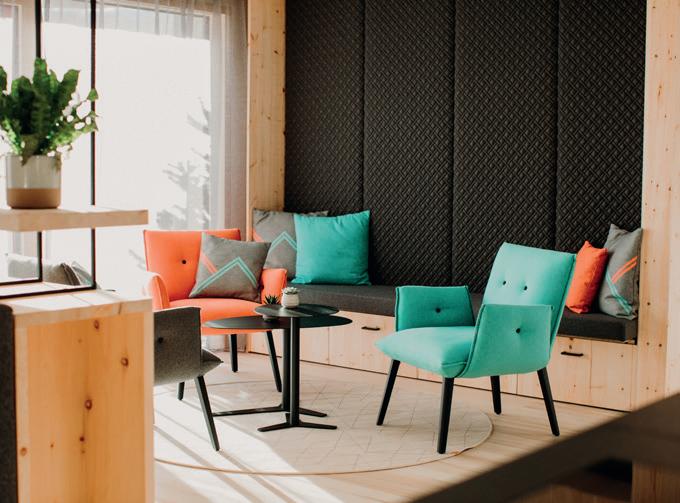
steam bath. Complemented by a fresh-air area and a separate relaxation room, guests can unwind in a comfortable atmosphere. The house also features a newly restructured and spacious underground car park, guaranteeing a comfortable arrival and departure, especially in winter.
The house not only shines with a new look, but also features a new concept. The new studios have a small kitchenette and also
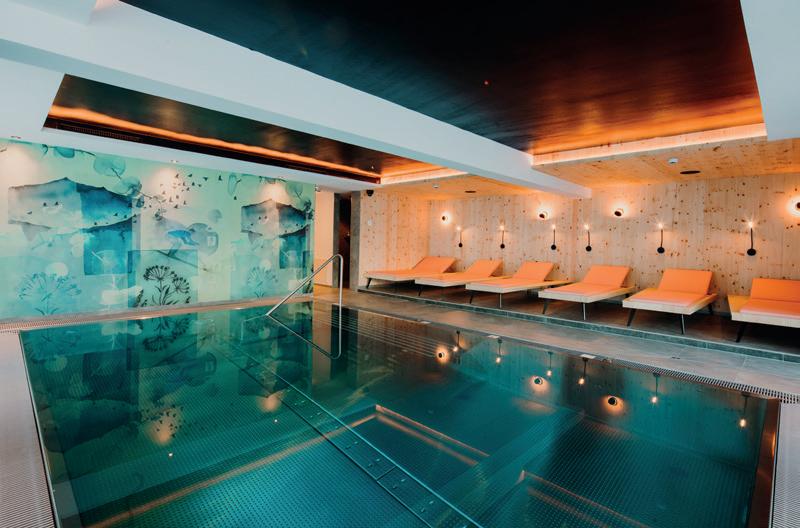
include a generous breakfast buffet. The larger, newly created suites include a fully equipped kitchen for self-catering. Upon request, the local baker delivers fresh bread and delicious pastries.
To make things even easier, guests have the option to choose from fabulous pre-cooked dishes, bottled in jars and made from regional ingredients – soups, main courses, or homemade pasta. “Our guests can take these meals from freely accessible gourmet fridges, in case they don't always want to go to a restaurant or only want a small meal.” Guests can also take their drinks directly to the rooms. “This way, they can end the evening in comfort and without any rush.”
www.alpinwarth.at
Phone +4355832716

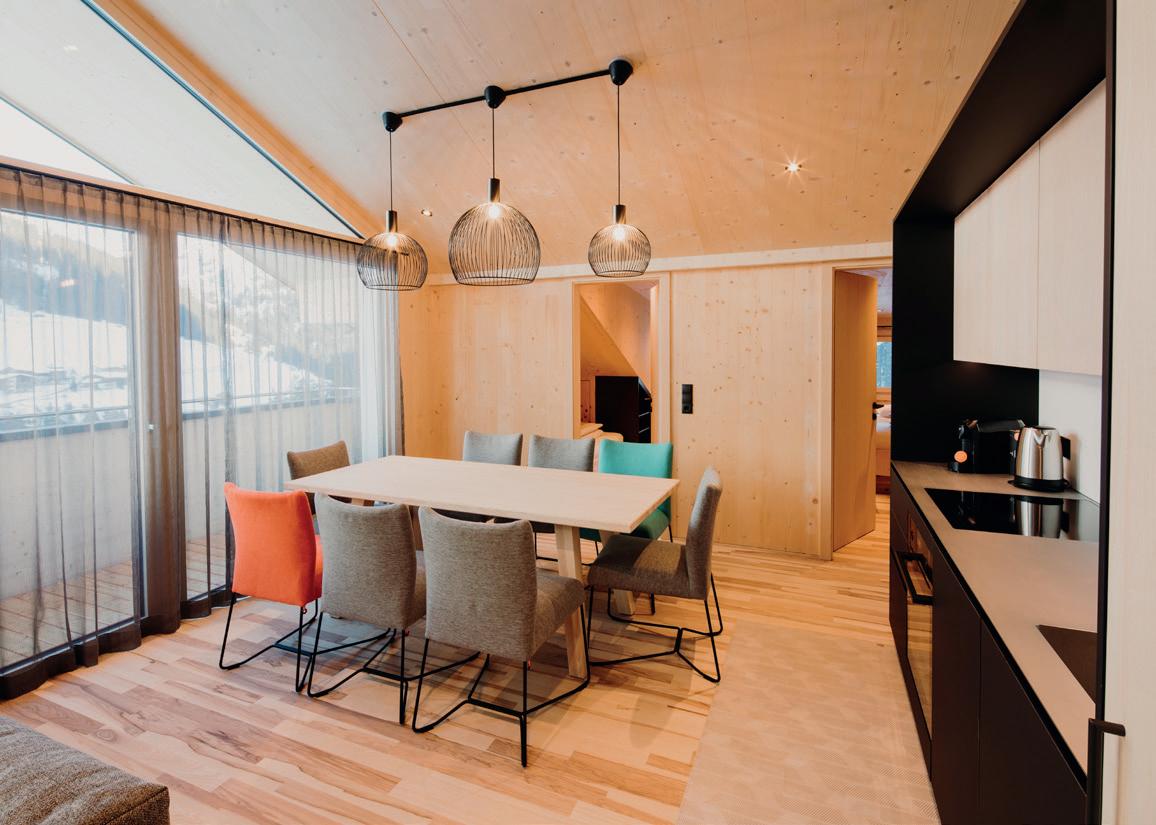
Bei der Renovierung legten die Gastgeber großen Wert auf Umweltfreundlichkeit. Eine Erdwärme-, Solar- und Photovoltaikanlage ersetzte die alte Ölheizung und versorgt das gesamte Hauptgebäude inklusive Pool- und Wellnessbereich mit Wärme, sowie Warmwasser. Darüber hinaus war es den Besitzern wichtig, dass die Isolierung über dem Standard liegt, um den langen Wintern gerecht zu werden. Das verwendete Holz hilft ebenfalls dabei, die Raumwärme zu speichern, die zudem mit modernster Regelungstechnik überwacht ist.
Ein neuer Wellnessbereich mit PanoramaPool und einer Saunalandschaft mit finnischer Sauna, Infrarotkabine und Dampfbad bilden das neue Highlight im Alpin. Abgerundet mit einem Frischluftbereich und einem separaten Ruheraum können Gäste hier in wohliger Atmosphäre die Seele baumeln lassen. Das Haus verfügt zudem über eine neustrukturierte und großzügige Tiefgarage, die
eine komfortable An- und vor allem Abreise –speziell im Winter – garantiert.
SELBSTVERPFLEGUNG ALS TEIL DES KULINARISCHEN KONZEPTS
Inzwischen strahlt das Haus nicht nur im neuen Glanz, sondern hat darüber hinaus ein neues Konzept. Die neuen Studios verfügen über
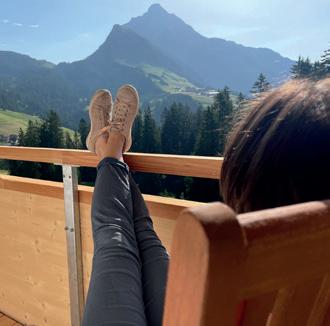
eine Küchenzeile und werden bei Buchung mit einem reichhaltigen Frühstücksbuffet angeboten. Die neu entstandenen Suites beinhalten eine voll ausgestattete Küche für die Selbstversorgung der Gäste, auf Wunsch liefert der lokale Bäcker frisches Brot und köstliches Gebäck.
Um es Gästen noch einfacher zu machen, gibt es Speisen aus regionalen Zutaten in Gläsern abfüllt – Suppen, Hauptspeisen oder hausgemachte Nudeln. „Unsere Gäste können sich diese Speisen aus frei zugänglichen „GenussKühlschränken“ entnehmen, wenn sie sich nicht ständig in einem Restaurant aufhalten möchten, oder nur Kleinigkeiten zum Essen benötigen.” Auch Getränke können Gäste direkt mit auf ihre Zimmer nehmen. „So können sie den Abend in aller Gemütlichkeit und ohne Hektik ausklingen lassen.“
www.alpinwarth.at
Telefon +4355832716
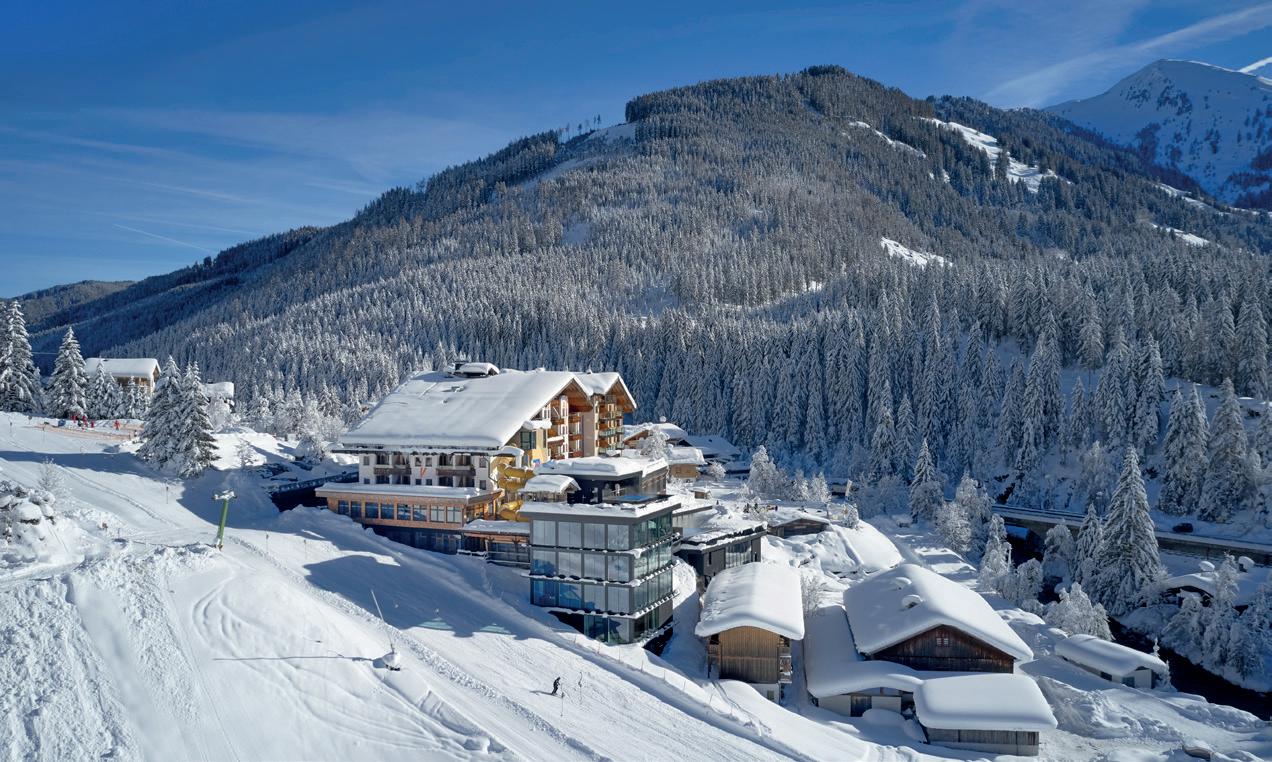
The setting of Almhof Family Resort & SPA could hardly be any better. Surrounded by 60,000 square metres of alpine meadows, an idyllic mountain lake and the valleys of Gerlos, guests have the Zillertal Arena with its 150 kilometres of pistes right at their doorstep. An ideal place for both active and relaxing holidays!
Even the arrival makes it obvious that Almhof Family Resort & SPA is a place of genuine hospitality. Elisabeth and Peter Kammerlander have run the hotel as a family business for many years and are now joined by their children Anna and Paul. Their focus is clear. “Our resort is dedicated entirely to families,” says Elisabeth Kammerlander. “Our motto is ‘Smiles for young and old‘ and promises a cornucopia of activities for all to enjoy and explore.”
The list of highlights is impressive: from the indoor trampoline park and pump track to soft play areas, baby and kids’ clubs, the vast new ALMI-opolis, bouldering cave, cooking and wood workshops. “In our Family Entertainment Centre, children and teenagers can enjoy karaoke, cinema or VR entertainment on two floors, as well as classic table football, air hockey and billiards,” adds Peter Kammerlander. “With such a wide variety of activities for children aged up to 14, many
families return year after year. And many remain loyal guests long after their children have grown up,” say the owners.
In winter, the resort stands out with its very own children’s ski area. This includes five conveyor belts, a T-bar lift and an in-house ski school, ensuring that even the youngest learn to ski through play. An added bonus: babies from just three months old are lovingly cared for. “This gives parents the chance to enjoy a carefree day on the slopes.”
Thanks to its perfect setting, Almhof is much more than a children’s paradise. Couples and solo travellers will find true relaxation in the extensive spa. The five-storey wellness tower with its panoramic whirlpool, ALM sauna and exclusive relaxation rooms offers rest with breathtaking mountain views. Massages, beauty treatments and elegantly designed rooms in a modern Alpine style complete the experience, creating an
atmosphere both cosy and refined. Perfect conditions for a romantic getaway!
So, what makes Almhof special? Alongside its outstanding facilities for families, it is the harmonious combination of stylish architecture and design, exceptional cuisine and the warmth of the Kammerlander family and their team, led by hotel director Alexander Ottino.
Together, they create the unmistakable spirit of Almhof Family Resort & SPA, making it a truly special place: light-hearted, welcoming, family-oriented and a comfortable, joyful experience.
www.familyresort.at/en

Die Lage des Almhof Family Resort & SPA könnte nicht besser sein: Umgeben von 60.000 m² Almwiesen, einem idyllischen Bergsee und den Seitentälern von Gerlos liegt den Gästen die Zillertal Arena mit ihren 150 Pistenkilometern zu Füßen. Ideal für aktive und erholsame Ferientage!
Schon bei der Ankunft merken die Gäste, dass das Almhof Family Resort & SPA ein Ort der Gastfreundschaft ist. Seit vielen Jahren führen Elisabeth und Peter Kammerlander das Haus als echtes Familienunternehmen, inzwischen gemeinsam mit den Kindern Anna und Paul. Die Zielgruppe ist dabei klar definiert. „Unser Resort ist konsequent auf Familien spezialisiert”, betont Elisabeth Kammerlander. „Unter unserem Motto ‚Wir machen kleine und große Gäste glücklich‘ bieten wir eine Fülle an Angeboten zum Austoben und Mitmachen.”
Die Liste der Highlights ist lang: vom IndoorTrampolinpark über den Pumptrack bis hin zu den Softplay-Anlagen oder dem Baby- und Kinderclub, der neuen riesigen Spielanlage ALMI-opolis, Boulderhöhle, Koch- und Holzwerkstatt. „Im Family Entertainment Center kommen Kinder und Jugendliche beim Karaoke, Kino oder VR-Entertainment auf zwei Etagen ebenso auf ihre Kosten wie beim klassischen Tischfußball, Airhockey oder Billard”, ergänzt Peter Kammerlander.
„Dank unseres breitgefächerten Angebots für Kinder und Jugendliche bis 14 Jahren kommen viele Familien mehrere Jahre lang immer wieder zu uns. Viele Familien bleiben uns daher auch dann noch treu, wenn die Kinder längst erwachsen sind”, so die Inhaber.
Im Winter trumpft das Almhof Family Resort & SPA mit seiner eigenen Kinderskischaukel auf. Das bedeutet: fünf Förderbänder, ein Schlepplift und die hauseigene Skischule, die dafür sorgen, dass schon die Jüngsten spielerisch das Skifahren lernen. Besonders entspannend: Bereits Babys ab dem dritten Lebensmonat werden hier liebevoll betreut. „So können sich auch die Eltern einmal freinehmen und ihren perfekten Skitag in Ruhe genießen.”
Dank bester Rahmenbedingungen ist der Almhof weit mehr als ein Paradies für Kinder. Paare und Alleinreisende finden im großzügigen Wellnessbereich Erholung. Der fünfstöckige Wellnessturm mit Panorama-Whirlpool, ALM-Sauna und exklusiven Ruheräumen bie-
tet Erholung mit Blick in die Berge. Massagen, Beauty-Treatments und edel gestaltete Zimmer im modernen Alpin-Stil ergänzen das Angebot und schaffen eine Atmosphäre, die gleichzeitig gemütlich und stilvoll ist. Perfekte Voraussetzungen für einen entspannten Paarurlaub!
Was den Almhof besonders macht? Neben dem tollen Angebot für Familien ist es sicherlich die gelungene Kombination aus stilvoller Architektur und Design, einer herausragenden Küche sowie der Herzlichkeit des gesamten Teams rund um Familie Kammerlander und Hoteldirektor Alexander Ottino.
Dieses Zusammenspiel schafft das unvergleichliche Lebensgefühl des Almhof Family Resort & SPA und macht es zu einem besonderen Ort: unbeschwert, fröhlich, familiär und einfach zum Wohlfühlen.
www.familyresort.at/de




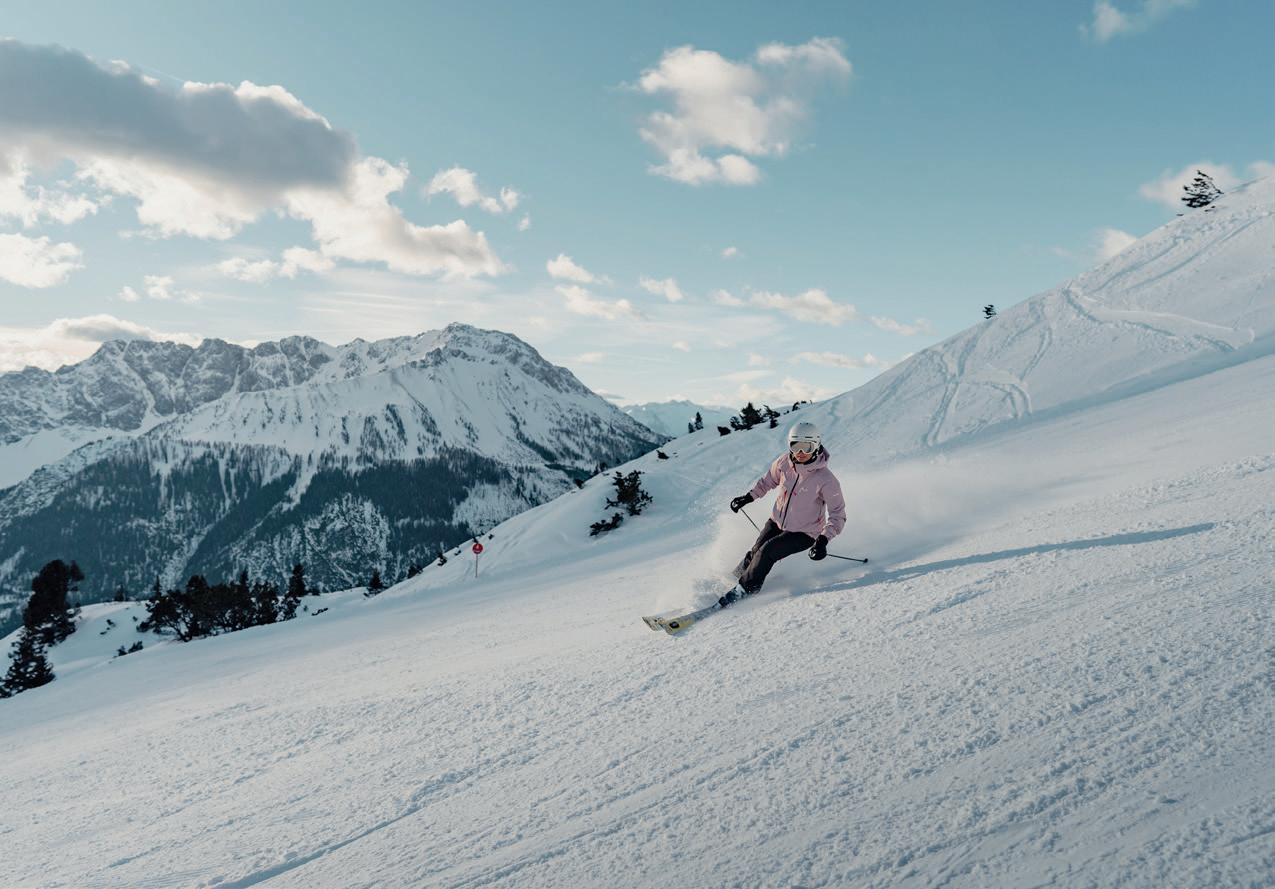
Nestled between impressive mountain ranges and at the foot of the majestic Zugspitze lies the Tiroler Zugspitz Arena – a region full of experiences for all ages. Seven charming villages and a magical winter landscape offer a wide range of activities for anyone who wants to experience winter to the fullest.
Whether alone, as a couple, with family, or with friends – everyone can enjoy a winter full of variety and unforgettable memories in the Tiroler Zugspitz Arena. With 143 kilometres of slopes and seven ski areas, including a glacier ski area, the Tiroler Zugspitz Arena is a paradise for every winter sports enthusiast. Of particular note are the three certified family ski regions, which boast child-friendly slopes and special rates for families – both beginners and pros will find the perfect downhill run here.
Action for young guests is offered at the Family Park and the Funslope in the ski resort Ehrwalder Almbahn. Ski courses for all levels are offered by qualified ski schools and trained instructors in all seven ski re-
sorts. Accessible skiing also plays an important role in the Tiroler Zugspitz Arena. With its No Handicap initiative, the Snowpower ski school in Lermoos makes winter sports accessible to people with disabilities. Spe-
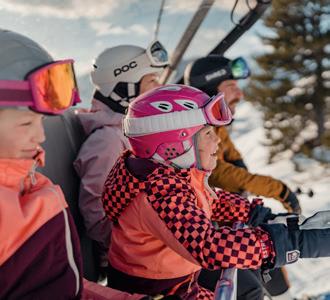
cial bi-skis and trained instructors ensure individualised support and accessibility.
Easy access to all ski areas is ensured by a well-developed ski bus network, which guests can use free of charge with their guest card. And highlights such as night skiing and atmospheric ski shows also bring the winter magic to life after sunset.
Endless expanse and a true winter feeling –that is what you will experience on the Zugspitze. The Tiroler Zugspitzbahn cable car comfortably transports guests to an altitude of almost 3,000 metres in just ten minutes. From the panoramic platform, breathtaking views unfold, revealing, on clear days, up to 400 peaks in four different countries. Two interactive museums included in the lift ticket offer fascinating insights into the history of nature and the mountain railway. Visitors can also enjoy culinary delights with a view at the panoramic restaurant.
Eingebettet zwischen beeindruckenden Gebirgsketten und am Fuße der majestätischen Zugspitze liegt die Tiroler Zugspitz Arena – eine Region voller Erlebnisse für Groß und Klein. Sieben charmante Orte und eine magische Winterlandschaft, bieten ein vielfältiges Angebot für alle, die den Winter in vollen Zügen erleben möchten.
Ob alleine, zu zweit, mit der Familie oder mit Freunden – in der Tiroler Zugspitz Arena kann jede:r den Winter voller Abwechslung und unvergesslicher Erinnerungen genießen. Mit 143 Pistenkilometern und sieben Skigebieten, darunter ein Gletscherskigebiet, ist die Tiroler Zugspitz Arena ein Paradies für jede:n Wintersportler:in.. Besonders hervorzuheben sind die drei zertifizierten Familienskigebiete, die mit kindergerechten Pisten und speziellen Tarifen für Familien überzeugen – hier finden sowohl Anfänger:innen als auch Profis die perfekte Abfahrt.
Action für junge Gäste wird im Familypark und der Funslope im Skigebiet Ehrwalder Almbahn geboten. In allen sieben Skigebieten werden Skikurse für alle Leistungsniveaus durch qualifizierte Skischulen und ausgebildete Skilehrer:innen angeboten. Auch barrierefreier Skisport spielt in der Tiroler Zugspitz Arena eine wichtige Rolle. Mit der Initiative ‚No Handicap‘

macht die Skischule Snowpower in Lermoos Wintersport für Menschen mit Einschränkungen möglich. Spezielle Bi-Skis und ausgebildete Skilehrer:innen sorgen für individuelle Betreuung und Zugänglichkeit.
Die unkomplizierte Erreichbarkeit aller Skigebiete wird durch ein gut ausgebautes Skibusnetz gewährleistet, welches Gäste mit der Gästekarte kostenfrei nutzen können. Highlights wie Nachtskilaufen oder stimmungsvolle Skishows lassen den Winterzauber nach dem Sonnenuntergang nochmal lebendig werden.
Unendliche Weite und echtes Winterfeeling – das erlebt man auf der Zugspitze. Die Tiroler Zugspitzbahn bringt Gäste komfortabel in nur zehn Minuten auf fast 3.000 Meter Höhe. Von der Panoramaplattform eröffnet sich eine atemberaubende Aussicht, bei dem an klaren Tagen bis zu 400 Gipfel, in vier verschiedenen Ländern zu sehen sind. Mit zwei in der Liftkar-
te inbegriffenen Erlebnismuseen erfährt man spannende Einblicke in die Geschichte der Natur sowie der Bergbahn. Kulinarisch genießen Besucher:innen im Panoramarestaurant Gipfelgenuss mit Aussicht.
EIN WINTER VOLLER ABWECHSLUNG
Auch abseits der Piste gewährt die Tiroler Zugspitz Arena Gästen einen Winter voller Vielfalt, mit Neuheiten und bewährten Highlights. 60 Kilometer gepflegte Winterwanderwege, abwechslungsreiche Schneeschuhtouren und 130 Kilometer kostenlos nutzbare Langlaufloipen, die durch alle sieben Orte verlaufen, bieten etwas ruhigere und dennoch magische Momente in der verschneiten Landschaft. Kulinarisch ergänzen authentische Hütten mit regionalen Spezialitäten und gemütliche Restaurants das Wintererlebnis – ob auf sonnigen Terrassen mit Blick auf die Zugspitze oder am knisternden Kaminfeuer.
Ein Highlight sind die digitalen Erlebniswege, die einen besonderen Spaß für Familien und neugierige Entdecker:innen bereiten. Mit Videos, Minigames und Rätseln, wird die Wanderung dabei zu einem abenteuerlichen Erlebnis

Even off the slopes, the Tiroler Zugspitz Arena offers guests a winter full of variety, with both new and established highlights. 60 kilometres of well-maintained winter hiking trails, diverse snowshoe tours, and 130 kilometres of cross-country ski trails (all of them can be used free of charge), which run through all seven villages, offer somewhat quieter yet magical moments in the snowy landscape. Authentic mountain huts serving regional specialties and cosy restaurants complement the winter experience – whether on sunny terraces with views of the Zugspitze or by a crackling fireplace.
A highlight is the digital adventure trails, which offer special fun for families and curious explorers. With videos, mini-games, and puzzles, the hike becomes an adventurous experience for young and old. Three of the digital adventure trails are open in winter.
A new feature is the year-round stamp pass, available both digitally and in print, and for the first time, it also includes cross-country ski trails. At most huts and stamp stations, you can pick up a physical stamp on-site. Stamps can also be collected digitally via SummitLynx. The huts and stamp stations
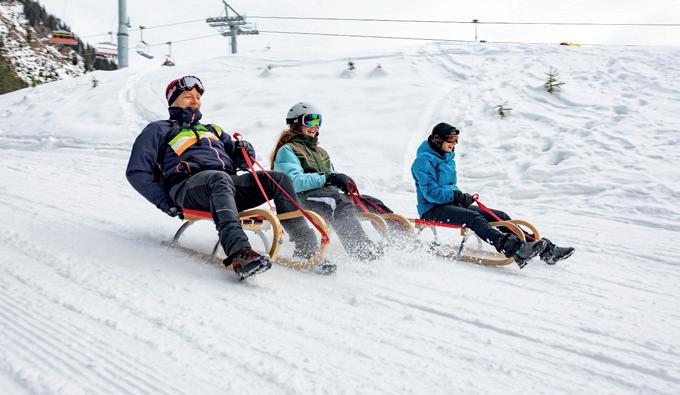
thus offer a variety of opportunities for collecting stamps and earning hiking badges.
Tobogganing enthusiasts can choose from several varied trails, both enjoyable during the day and illuminated at night. Particularly night tobogganing in Ehrwald, Lermoos, Berwang, and Biberwier offers atmospheric winter moments under the starry sky. Ice skating and Alpine curling, deeply rooted in Alpine tradition, provide sociable recreational fun. Furthermore, guests can participate in romantic torchlit hikes and relaxing llama

walks rides through impressive winter landscapes, free of charge, with their guest card. This allows them to fully enjoy the peaceful winter world.
Located just over the German border, the Tiroler Zugspitz Arena makes travelling to the region particularly easy. Without mountain passes, vignettes, or tolls, vacationers can quickly and easily immerse themselves in the mountain world via Germany. The region is also easily accessible by train, making a sustainable journey a breeze: Six stops in the Tiroler Zugspitz Arena are directly connected to the rail network. Connections via Stuttgart and Kempten, as well as from Munich and Innsbruck via Garmisch-Partenkirchen, lead directly to the vacation region. Winter and ski buses (with the guest card free of charge) ensure convenient mobility between the towns and ski areas. E-car drivers will also find a dense network of charging stations for mobility – both during the journey and while on vacation.
The Tiroler Zugspitz Arena uniquely combines diversity, tranquillity, and the joys of nature. With its wide range of offerings, proximity to the German border, and unmistakable winter flair, the Tiroler Zugspitz Arena on the sunny side of the Zugspitze is the perfect destination for anyone who wants to enjoy winter to the fullest – and not just on the slopes!
So close, so easy – the path to freedom leads to the Tiroler Zugspitz Arena.
www.zugspitzarena.com/en
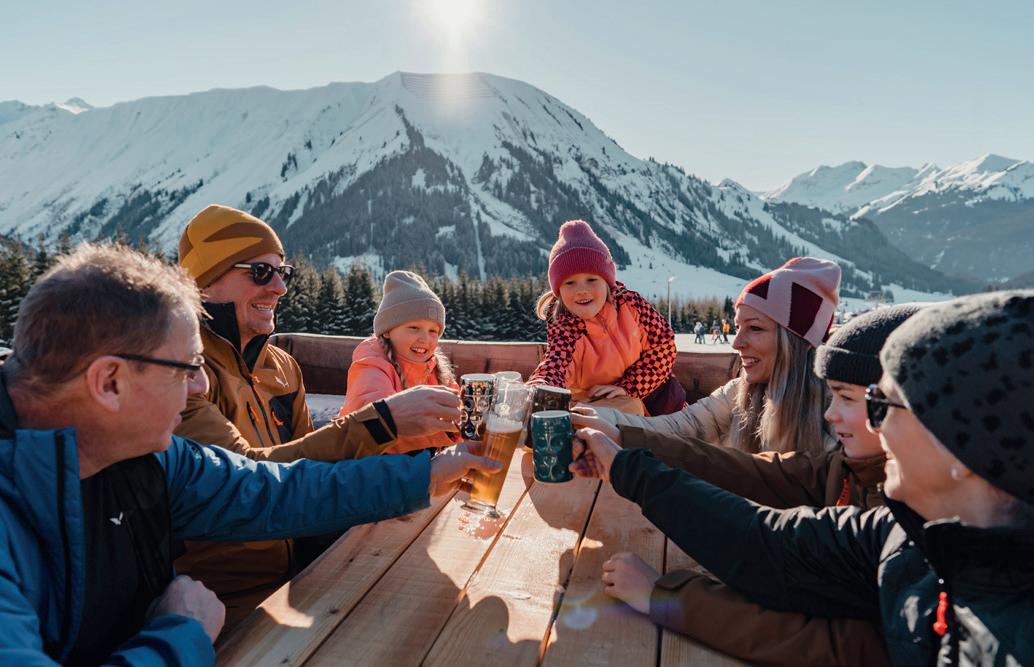
für Jung und Alt. Drei der sechs digitalen Erlebniswege sind auch im Winter begehbar.
Neu ist der ganzjährige Stempelpass, der sowohl digital als auch in gedruckter Form erhältlich ist und erstmals auch die Langlaufloipen integriert. Bei den meisten Hütten und Stempelstellen kann man sich vor Ort einen physischen Stempel abholen. Zudem können auch digital über SummitLynx Stempel gesammelt werden. Die Hütten und Stempelstellen bieten somit vielfältige Möglichkeiten zum Sammeln von Stempeln und dem Erlangen von Wandernadeln.
Für Rodelfreunde stehen mehrere abwechslungsreiche Strecken zur Verfügung, die tagsüber und beleuchtet bei Nacht große Freude bereiten. Besonders das Nachtrodeln in Ehrwald, Lermoos, Berwang und Biberwier besticht mit stimmungsvollen Wintermomenten unter dem Sternenhimmel. Eislaufen und Eisstockschießen, tief in der alpenländischen Tradition verwurzelt, sorgen für geselligen Freizeitspaß. Darüber hinaus können Gäste kostenfrei mit der Gästekarte an romantischen Fackelwanderungen und entspannten Lama-Wanderungen durch beeindruckende Winterlandschaften teilnehmen. So kann die

friedvolle Winterwelt in vollen Zügen genossen werden.
Direkt hinter der deutschen Grenze gelegen, ermöglicht die Tiroler Zugspitz Arena eine besonders unkomplizierte Anreise. Ohne Passstraßen, Vignetten oder Maut können Urlauber:innen entspannt und schnell über Deutschland in die Bergwelt eintauchen. Auch mit der Bahn ist die Region bestens erreichbar, sodass eine nachhaltige Anreise problemlos möglich ist: Sechs Haltestellen in der Tiroler Zugspitz Arena sind direkt an das Bahnnetz angebunden. Verbindungen über Stuttgart und Kempten sowie von München und Innsbruck über Garmisch-Partenkirchen führen direkt in die Urlaubsregion. Vor Ort sorgen Winter- und Skibusse (mit der Gästekarte kostenlos) für be-

queme Mobilität zwischen den Orten und Skigebieten. E-Autofahrer:innen finden außerdem ein dichtes Netz an Ladestationen vor, um mobil zu sein – sowohl während der Anreise als auch im Urlaub.
Die Tiroler Zugspitz Arena vereint auf einzigartige Weise Vielfalt, Ruhe und Naturgenuss. Mit ihrem breiten Angebot, der Nähe zur deutschen Grenze und dem unverwechselbaren Winterflair ist die Tiroler Zugspitz Arena auf der Sonnenseite der Zugspitze das perfekte Ziel für alle, die Winter in vollen Zügen genießen möchten und das nicht nur auf der Piste!
So nah, so einfach – der Weg in die Freiheit führt in die Tiroler Zugspitz Arena.
www.zugspitzarena.com/de
At first, I could not see much of the Harz Mountains. Though it soon cleared, mist –and a certain layer of mystery – was bathing thick forest as the bus swept downhill. I was making a short journey to the small settlement of Eckertal, having set off from Bad Harzburg, a spa town nestled about 90 kilometres southeast of Hanover.
What today is a united Germany’s heart stood, for much of the last century, on the demarcation of west and east. Disembarking at Eckertal, I faced a large brown sign whose white text reminded passing drivers of the fact. Here, the division of West and East Germany is today a boundary between the states of Lower Saxony and Saxony-Anhalt, identifiable only by a small contrast in road surfaces.
Much, indeed, has changed in the 36 years since 9 November 1989, when both the Berlin Wall and Germany’s wider partition were rendered useless. The village of Stapelburg, just east of Eckertal, is awash with houses constructed after communism’s collapse. Trees and agriculture have stubbed out most of what was one of the world’s most closely guarded strips.
The German Democratic Republic (so called, given that for most of its existence it was not particularly democratic), was founded in 1949, a direct successor to the Soviet occupation zone. It was not, however, until the early 1950s that the construction of border defences began.
This means that the period since the Inner German Border’s dismantling has now lasted almost as long as the time in which fortifications were in place. Despite the intervening decades, the border lives on – and not only via signs, memorials and odd sections of preserved barriers.
For years, its precincts saw little human activity, not least on the eastern side, where access was controlled and many households forced to resettle. By the 1970s, biologists



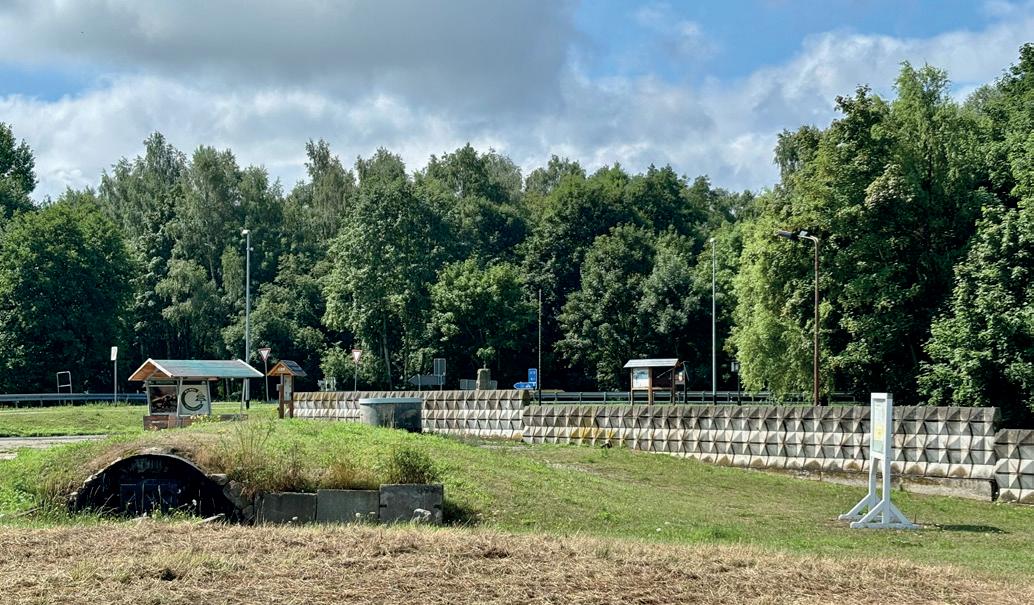
found wildlife flourishing in border regions absent of substantial human intervention.
In December 1989, only a month after the Berlin Wall collapsed, environmentalists signed the Green Belt Declaration of Hof, initiating efforts to preserve what had become an inadvertent wildlife reserve. By the early 2000s, it had grown into a pan-European movement. Today, a European Green Belt winds all the way from northern Finland to the Balkans, tracing the route of the former Iron Curtain.
Near Bad Harzburg, the corridor incorporates the 91-kilometre Harz Border Trail (Harzer Grenzweg), inaugurated in 2006 with help from the late Benno ‘Broken-Benno’ Wolfgang Schmidt, who scaled the region’s Brocken mountain over 9,000 times.
The trail starts below the hills at Hornburg and takes in the aforementioned Brocken, northern Germany’s highest peak and a military exclusion zone when it fell in East German territory. It moves past the ski town of Braunlage and finishes near the village of Tettenborn on the other side of the mountain range.
“We have 11,000 members in 78 branch associations,” shares Annett Drache, managing
director of Harzklub, an organisation responsible for signage on the Harz Border Trail. From 2007 to 2010, Drache explains, Harzklub participated in the Erlebnis Grünes Band project.
“Shelters and benches need to be regularly repaired,” she continues. “Signposts need to be erected, and bridges and observation towers need to be maintained. About 55,000 volunteer hours are spent annually on the maintenance of trails.”
Drache, who grew up in Dresden when it was part of East Germany, likens the various sections of the Green Belt to a string of pearls, and says that her favourite part of the Harz Border Trail runs from Grenzmuseum Sorge to Walkenried. She adds, however, that Brocken is also “very special” – given its status as a symbol of German unity.
“The reopening of Brocken was one of the most important events in the Harz Moun-
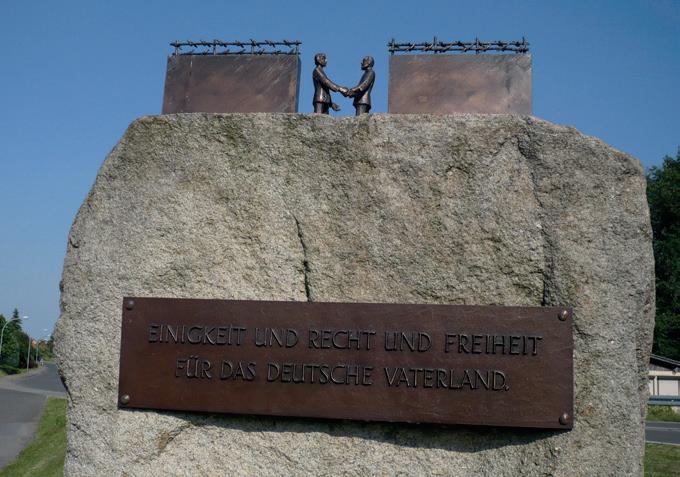
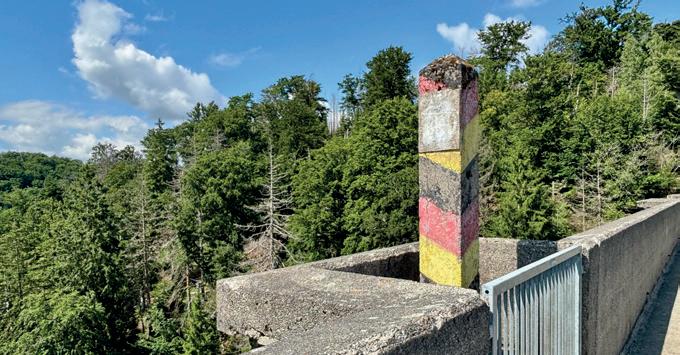
tains,” Drache clarifies, adding that in April 1990, Harzklub helped publish one of the first cross-border hiking maps in Germany. “Since 1989, members of Harzklub have met annually on 3 December, to commemorate the time when an impregnable border separated the eastern and western parts of the Harz Mountains and climbing Brocken seemed a distant memory.”
A communications tower built on Brocken in the 1970s still stands, while at Eckertal some border defences have been given leave to remain, employed as reminders of the Iron Curtain’s all too literal manifestation. There is a concrete circle, once the base of a watchtower, and a still-standing section of the wall that buttressed it.
As I worked my way through Eckertal’s copious interpretation boards, I met 56-year-old Arndt Uchtmann from Osnabrück, near Münster, his rucksack overflowing with maps and leaflets. Uchtmann was hiking in the area, photographing the former frontier for his sister.
“I think it’s important that people learn about the division of Germany,” he affirmed. “I didn’t come here when the border existed, but I went to West Berlin three times. There was a certain atmosphere in the city back then.”
Like Uchtmann, most hikers come not only to view leftovers of a divided nation, at times following remnants of the Kolonnenweg patrol road, but also with ambitions to embrace the quiet beauty of Harz National Park, which is spread across a mountain chain that is possibly little-known outside Germany. Some might pick up a booklet from a tourist information office, collecting stamps from wood-
en boxes along their journey and, on completion, exchanging them for a congratulatory badge of honour.
After crossing Eckertalsperre, a dam once split in half by the east-west divide, and over which the Harz Border Trail now passes, I came across Danish brothers Dines Bolt and Bernhard Bolt-Jørgensen.
“We usually hike in Sweden,” explained Dines, aged 49 and able to recall the Berlin Wall’s crumbling. “We’re getting older and it’s nice to come here, where there are more hotels. It was strange to walk along the old patrol road, which was quite steep at times. This is a country full of history.”
The barrier on the dam’s crest (first a wall, then a metal fence) has long since been re-
moved, but a striped GDR barber pole stands testament to this most atypical of border positions, its access rights having been agreed via bilateral agreements.
“The time after the border was opened was characterised by freedom, hope and confidence,” says Annett Drache, who admits that she never could have imagined seeing the border fall in such a short space of time.
“On a varied and challenging route,” she goes on, “hikers can experience the scenic diversity of the Harz Mountains and contemporary German history up close. The mountains are particularly attractive because there’s great biodiversity in a small area, due particularly to large differences in altitude. Tourism in the Harz Mountains would be unimaginable without an attractive network of trails connecting towns with a diverse natural environment.”
Beauty and biodiversity certainly appear to pull visitors as much as tangible relics of the past. While Harz’s painful past cannot be neglected, Drache and I surely are not alone in finding comfort from nature reclaiming a line that once turned a population into prisoners. Wildcats roam where there was an almost impenetrable border fence.
As in so many areas of Germany, it seems that in these majestic mountains, history has been carefully incorporated into the country’s very soil.

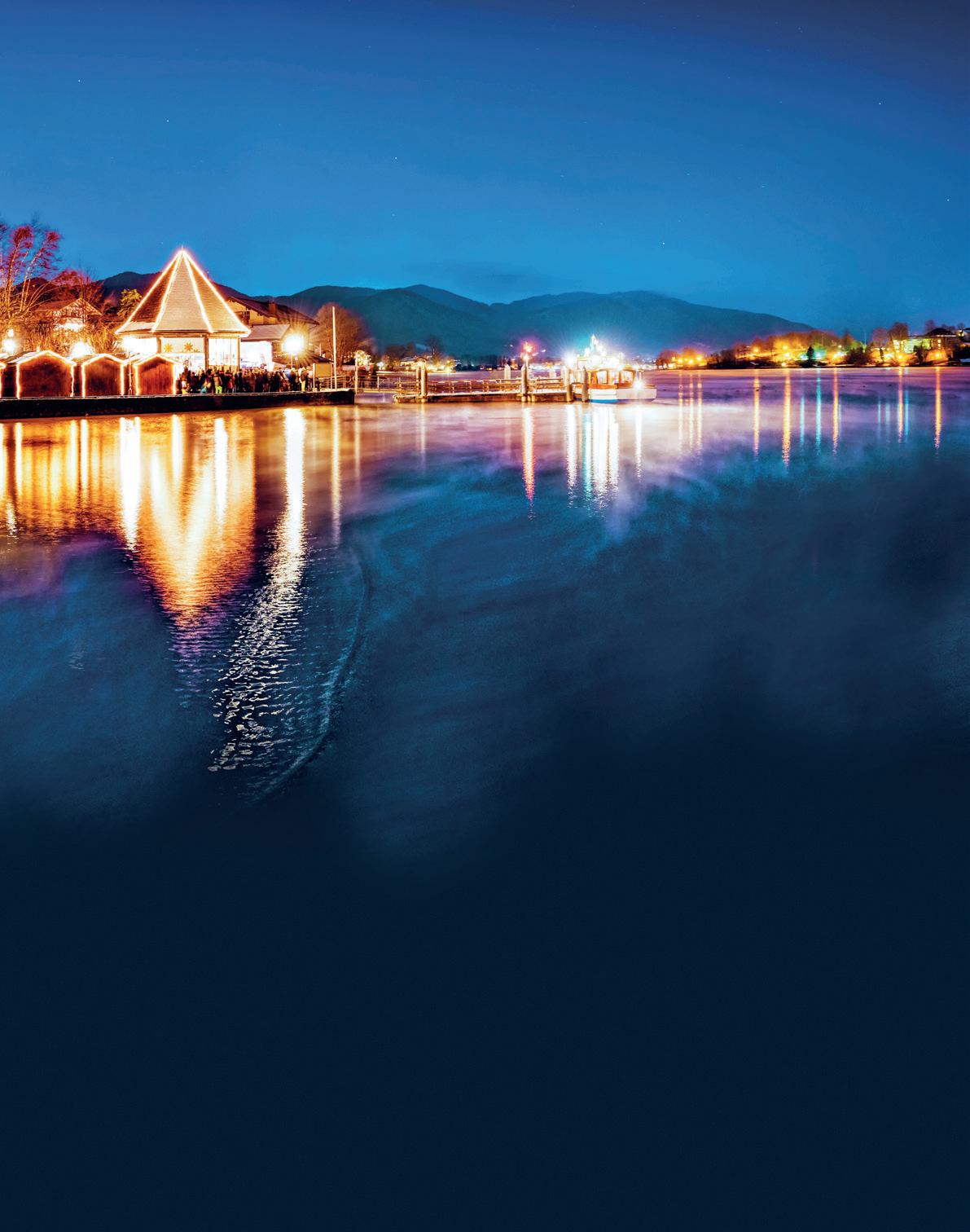
Erleben Sie drei Tage Tegernseer Adventszauber inklusive Übernachtung, stimmungsvoller Pendelschifffahrt und geführter Tour mit den Tegernseer Heimatführern.
www.tegernsee.com/advent

From chic alpine lodges to elegant lakeside retreats and luxury hotels, explore distinctive accommodations in the following special theme that combine comfort, charm and exceptional design – perfect for travellers seeking memorable experiences beyond the ordinary.
PHOTOS: UNSPLASH


Welcome to the heart of the Swiss Alps, where every season offers a new adventure. In this edition of Discover Germany, Switzerland & Austria, we invite you to explore Chalet V, a luxurious haven perfectly poised for those who seek both thrilling activities and serene beauty.
Nestled in the charming village of La Tzoumaz, Chalet V is the perfect gateway to an active escape. In winter, guests are just moments away from carving fresh tracks

on world-class slopes as Chalet V offers a private ski room with boot warmers and three private indoor parking spaces directly at the entry to the gondola with access to the huge 4 Vallées ski area – the biggest in Switzerland. The area caters to all levels, from gentle beginner runs to challenging off-piste terrain, making it a paradise for skiers and snowboarders alike.
Inside, the chalet is a sanctuary of comfort. Unwind in the private pool, Jacuzzi and sauna after a day on the slopes, or gather with loved ones around the cosy fireplace. The fullyequipped gourmet kitchen is a chef’s delight, while the spacious bedrooms and bathrooms provide a restful retreat. Every detail – from the tasteful decor to the high-end amenities
– has been carefully curated to ensure a stay of pure indulgence.
As the snow melts, the landscape transforms into a vibrant playground for summer enthusiasts. The surrounding mountains invite you to hike or bike along endless trails. Discover lush green meadows, dense pine forests, and listen to the soothing sounds of crystal-clear streams. La Tzoumaz is renowned for its panoramic views and from Chalet V you can take in the breathtaking vistas of the Rhône Valley and the majestic peaks of the Valais Alps, right from the multiple private terraces.
Chalet V is not just a holiday destination; it is a chance to create lasting memories in one of the most beautiful places on earth. Book your stay and let the magic of the Swiss Alps envelop you.
www.chalet-v.com
Instagram: @thechaletv
Willkommen im Herzen der Schweizer Alpen, wo jede Jahreszeit ein neues Abenteuer bietet. In dieser Ausgabe von Discover Germany, Switzerland & Austria laden wir Sie ein, das Chalet V zu erkunden – eine luxuriöse Oase für alle, die sowohl aufregende Aktivitäten als auch Ruhe und Schönheit suchen.
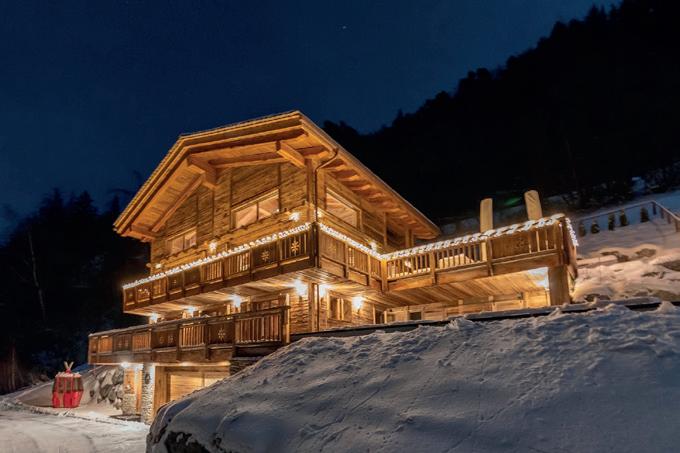
Eingebettet im charmanten Dorf La Tzoumaz ist das Chalet V der perfekte Ausgangspunkt für einen aktiven Urlaub. Im Winter sind die Gäste nur wenige Augenblicke davon entfernt, frische Spuren auf Weltklasse-Pisten zu ziehen, denn das Chalet V bietet einen privaten Skiraum mit Schuhwärmern und drei private Parkplätze direkt am Eingang der Gondelbahn mit Zugang zum riesigen Skigebiet 4 Vallées –dem größten der Schweiz. Das Gebiet bietet für alle Niveaus etwas, von sanften Anfängerpisten bis hin zu anspruchsvollem Off-Piste-
Gelände, und ist somit ein Paradies für Skifahrer und Snowboarder.
Innen ist das Chalet eine Oase des Komforts. Entspannen Sie nach einem Tag auf der Piste im privaten Pool, Whirlpool und in der Sauna oder treffen Sie sich mit Ihren Liebsten am gemütlichen Kaminfeuer. Die voll ausgestattete Gourmetküche ist ein Genuss für jeden Koch, während die geräumigen Schlafzimmer und Badezimmer einen erholsamen Rückzugsort bieten. Jedes Detail – von der geschmackvol-


len Einrichtung bis hin zur hochwertigen Ausstattung –wurde sorgfältig ausgewählt, um einen Aufenthalt voller Genuss zu gewährleisten.
Wenn der Schnee am Ende des Winters schmilzt, verwandelt sich die Landschaft in einen lebendigen Spielplatz für Sommerliebhaber. Die umliegenden Berge laden zum Wandern oder Radfahren auf endlosen Wegen ein. Entdecken Sie saftig grüne Wiesen, dichte Tannenwälder und lauschen Sie dem beruhigenden Rauschen kristallklarer Bäche. La Tzoumaz ist bekannt für seinen Panoramablick, und vom Chalet V aus genießen Sie von den zahlreichen privaten Terrassen einen atemberaubenden Blick auf das Rhonetal und die majestätischen Gipfel der Walliser Alpen.
Chalet V ist nicht nur ein Urlaubsziel; es bietet die Möglichkeit, bleibende Erinnerungen an einem der schönsten Orte der Welt zu schaffen. Buchen Sie Ihren Aufenthalt und lassen Sie sich von den Schweizer Alpen verzaubern.
www.chalet-v.com
Instagram: @thechaletv
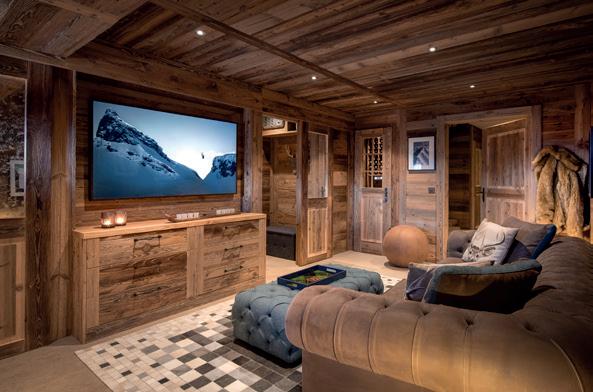

Nestled in the picturesque landscape of Alpstein, surrounded by pristine nature, lies Resort Hof Weissbad – a place that combines tradition, modern health concepts, relaxation, excellent cuisine, and warm hospitality, appealing to people seeking enjoyment, nature, and culture.
The history of Resort Hof Weissbad dates back to 1740, when the first bathing hut with spring water was built here. Even then, the beneficial effects of the water were known, and were used to relieve aches and fevers.
The name Schotten Sepp – Josef Anton Inauen – has been inextricably linked to the hotel's history ever since. At his instigation, the first whey cure was introduced at the Weissbad spa complex in 1790, making his son Karl Jakob the first founder of the spa.
After the old spa building was demolished in 1992 and extensively renovated, the new Hof Weissbad health and holiday hotel opened – the origin of today's Hotel Hof

Weissbad – and has since developed into one of the most renowned hotels in Eastern Switzerland. Today, with around 270 employees, the resort is the largest private employer in Appenzell Innerrhoden and generates an annual revenue of CHF 24 million – an impressive success story built on quality, innovation, and hospitality.
In Resort Hof Weissbad, guests can find relaxation and activity in two accommodation categories. The modern three-star Lodge Hof Weissbad with 25 rooms offers a relaxed atmosphere with thoughtful details, while the four-star superior Hotel Hof Weissbad with 90 rooms focuses on culinary delights and culture.
The cuisine in both hotels has been awarded 16 Gault-Millau points – a testament to the
Eingebettet in die malerische Landschaft des Alpsteins, umgeben von ursprünglicher Natur, liegt das Resort Hof Weissbad – ein Ort, der Tradition, moderne Gesundheitskonzepte, Entspannung, exzellente Küche und herzliche Gastfreundschaft auf einzigartige Weise verbindet und so Menschen anspricht, die Erholung, Genuss, Natur und Kultur suchen.
Die Geschichte des Resort Hof Weissbads reicht zurück bis ins Jahr 1740, als hier die erste Badehütte mit Quellwasser errichtet wurde. Bereits damals wusste man um die wohltuende Wirkung des Wassers, das zur Linderung von Gliederschmerzen und Fieber eingesetzt wurde. Der Name ,Schotten Sepp’ – Josef Anton Inauen – ist seitdem untrennbar mit der Geschichte des Hauses verbunden. Auf seine Anregung hin wurde 1790 in der Bäderanlage Weissbad die erste Molkenkur eingeführt, wodurch sein Sohn Karl Jakob als erster Gründer des Kurhauses gilt.
Nachdem das alte Kurhaus 1992 abgerissen und ein umfangreicher Umbau vorgenommen wurde, öffnete das neue Gesundheits- und Ferienhotel Hof Weissbad – der Ursprung des heutigen Hotel Hof Weissbad – und hat sich seither zu einem der renommiertesten Hotels der Ostschweiz entwickelt. Heute ist das Resort mit rund 270 Mitarbeitenden der größte private Arbeitgeber in Appenzell Innerrhoden und erwirtschaftet einen Jahresumsatz von
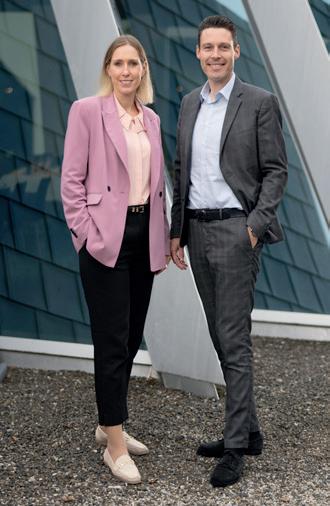
24 Millionen Franken – eine beeindruckende Erfolgsgeschichte, die auf Qualität, Innovation und Herzlichkeit basiert.
Im Resort Hof Weissbad finden Gäste in zwei Unterkunftskategorien Entspannung und Aktivität. Die moderne Drei-Sterne-Lodge Hof Weissbad mit 25 Zimmern bietet den Gästen eine entspannte Atmosphäre mit liebevollen Details, während im Vier-Sterne-Superior-Hotel Hof Weissbad mit 90 Zimmern kulinarische Genüsse und Kultur im Vordergrund stehen.
Die Küche in beiden Häusern ist mit 16 GaultMillau-Punkten ausgezeichnet – ein Beweis für höchste Qualität und Kreativität. Drei Restaurants bieten hier verschiedene Erlebnisse: das architektonisch beeindruckende Flickflauder, die elegante Veranda und die gemütlichrustikale Schotten-Sepp-Stube. Die Hotelbar mit Bistro lädt dazu ein, den Tag bei einem Drink oder Snack in entspannter Atmosphäre ausklingen zu lassen. „Unsere Küche vereint Tradition
und Innovation. Wir arbeiten eng mit regionalen Produzenten zusammen und legen Wert auf frische, saisonale Zutaten“, so Elias Leu, Direktor Hotel Hof Weissbad. Die Blumenwerkstatt des Hauses bietet für exklusive Bankette bis 20 Personen einen besonderen Rahmen, während das Hofhaus perfekt für Kochevents und kleine Meetings geeignet ist. Die urige Hofkäserei, einst Produktionsstätte für den hauseigenen Käse, ist heute zudem eine stimmungsvolle Location für Grill- und Fondueabende.
KULTUR UND KULINARIK TREFFEN NATUR
Es ist die Symbiose aus unberührter Natur, gelebter Gastfreundschaft und einem breiten Angebot, die das Resort Hof Weissbad so besonders macht. „Die gelebte Herzlichkeit unserer Mitarbeitenden, verbunden mit hoher fachlicher Kompetenz in allen Bereichen, machen den Unterschied“, betont Elias Leu. Eingebettet in eine ursprüngliche Naturlandschaft mit dem imposanten Alpsteinmassiv, bietet das Resort seit jeher eine beeindruckende, ruhe- und kraftspendende Kulisse für Erholungssuchende und Aktive gleichermassen.
„Hier wird Longevity nicht nur angeboten, sondern gelebt – schon lange bevor es zum Trend wurde”, sagt Elias Leu. Ein täglich wechselndes
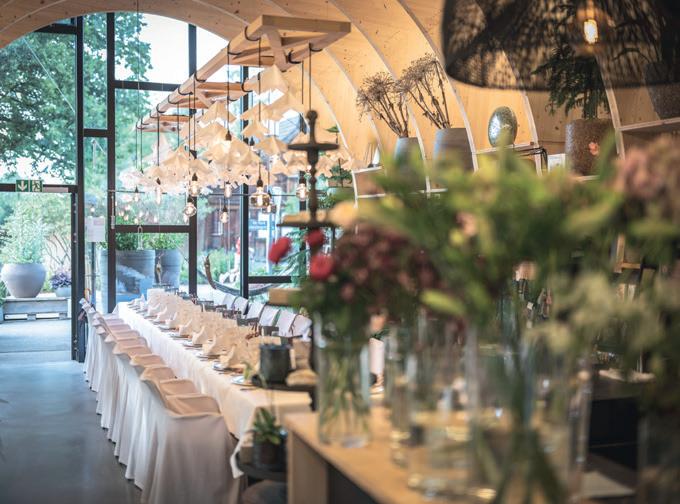
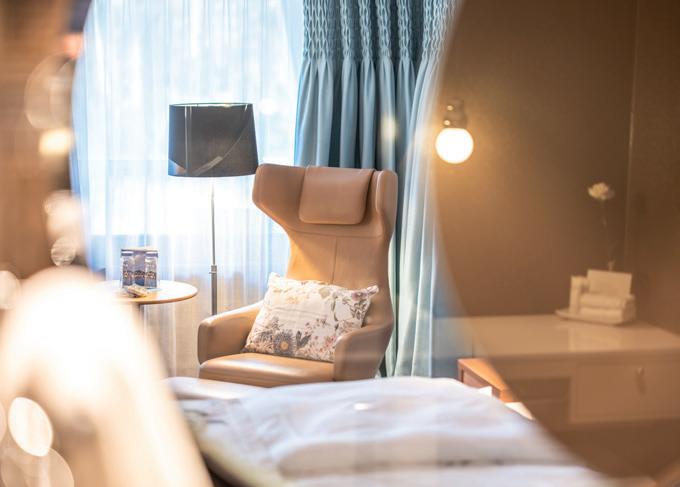
highest quality and creativity. Three restaurants offer a variety of experiences: the architecturally impressive Flickflauder, the elegant Veranda, and the cosy, rustic Schotten-SeppStube. The hotel bar and bistro invite you to round off the day with a drink or snack in a relaxed atmosphere. "Our cuisine combines tradition and innovation. We work closely with regional producers and value fresh, seasonal ingredients," says Elias Leu, director of Hotel Hof Weissbad. The hotel's flower workshop offers a special setting for exclusive banquets for up to 20 people, while the courtyard house is perfect for cooking events and small meetings. The rustic farm cheese dairy, once the production site for the hotel's own cheese, is now also an atmospheric location for barbecue and fondue evenings.
It is the symbiosis of pristine nature, genuine hospitality, and a wide range of offerings that makes the Hof Weissbad resort so special. "The genuine warmth of our employees, combined with high professional competence in all areas, makes the difference," emphasises Elias Leu. Nestled in a pristine natural landscape with the imposing Alpstein massif, the resort has always offered an impressive, tranquil and invigorating setting for those seeking both relaxation and activity.
"Longevity isn't just offered here, it's lived –long before it became a trend," says Elias Leu. A daily changing activity programme –free of charge for hotel guests – and a
diverse cultural programme on site provide variety, while regional excursions lead to innovative companies and traditional craft workshops that open their doors to interested visitors.
Those wishing to explore the region can choose between walks in the Glandenstein Mountains, strolls through the picturesque village of Appenzell, long hikes, or challenging bike trails in the Alpstein Mountains. The resort park transforms into an atmospheric concert venue in summer, while in winter, an enchanting sea of lights creates magical moments. Readings by crackling fireplaces, evenings with wine pairing, or a musical programme complete the experience. Companies with 10 to 60 people also benefit from inspiring opportunities for meetings, seminars, and workshops in the Seminar Park, with creative outdoor workspaces by the stream.
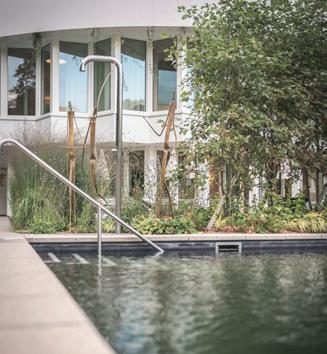
The resort's medical wellness offering is based on four pillars: exercise, awareness, relaxation, and nutrition. An experienced team of physicians, health coaches, nutritionists, and therapists provides individualised support to guests. "As the only F.X. Mayr-certified facility in Switzerland, we not only teach the method but also demonstrate how to implement it in everyday life through cooking classes," explains Elias Leu. The goal is to find and promote each guest's individual health rhythm.
The modern spa and wellness area, Bade & Saunahaus, is made of fragrant spruce wood and enclosed in glass. Here, guests enjoy refreshing spring water, relax in the natural swimming pond or the 36-degree pool, leave everyday life behind in various saunas, the whirlpool, and the steam bath, and treat themselves to cosmetic and classic wellness treatments, as well as therapeutic treatments, all performed by dedicated staff with passion and expertise. "Everything you need to clear your head and revitalise your body," adds Susanne Leu, director of Hotel Hof Weissbad.
"We want our guests to recharge their batteries and return home inspired," says Susanne Leu, describing the hotel's philosophy. Warmth, professional expertise, the highest quality in all areas, excellent cuisine, and a comprehensive range of wellness and health options make Hof Weissbad Resort a place of power amidst pristine nature – an experience for all the senses and a place you will always want to return to.
www.hofweissbad.ch

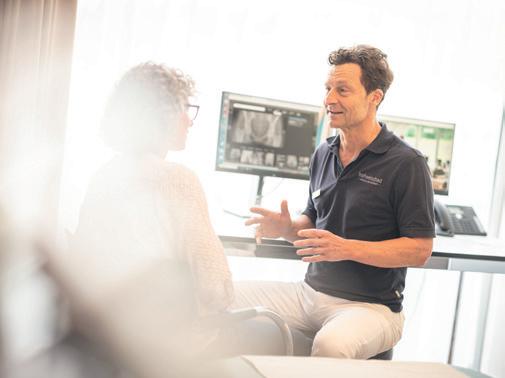
Aktivitätenprogramm – kostenfrei für Hotelgäste – und ein vielseitiges Kulturprogramm im Haus sorgen für Abwechslung, während regionale Ausflüge zu innovativen Unternehmen und traditionellen Handwerksbetrieben führen, die ihre Türen für interessierte Besucher öffnen.
Wer die Region entdecken möchte, kann zwischen Spaziergängen im Glandenstein, Flanieren im malerischen Dorf Appenzell, ausgedehnten Wanderungen oder anspruchsvollen Bike-Trails im Alpstein wählen. Der ResortPark verwandelt sich im Sommer zudem in eine stimmungsvolle Konzertbühne, während im Winter ein zauberhaftes Lichtermeer für magische Momente sorgt. Lesungen an knisternden Kaminen, Abende mit Weinbegleitung oder musikalischem Rahmenprogramm runden das Erlebnis ab. Unternehmen mit 10 bis 60 Personen profitieren zudem von inspirierenden Möglichkeiten für Meetings, Seminare und Workshops im ,Seminarpark’ mit kreativen Outdoor-Arbeitsplätzen am Bachlauf.
Das Medical Wellness Angebot des Resorts basiert auf vier Säulen: Bewegung, Bewusstsein, Entspannung und Ernährung. Ein erfahrenes Team aus Ärzten, Gesundheitscoaches, Ernährungsberatern und Therapeuten begleitet die Gäste individuell. „Als einziges F.X. Mayrzertifiziertes Haus in der Schweiz vermitteln wir nicht nur die Methode, sondern zeigen in Kochkursen, wie man sie im Alltag umsetzt“, erklärt Elias Leu. Ziel ist es, für jeden Gast den individuellen Gesundheitsrhythmus zu finden und zu fördern.
Der moderne Spa- und Wellnessbereich, das ,Bade & Saunahaus’, besteht aus duftendem
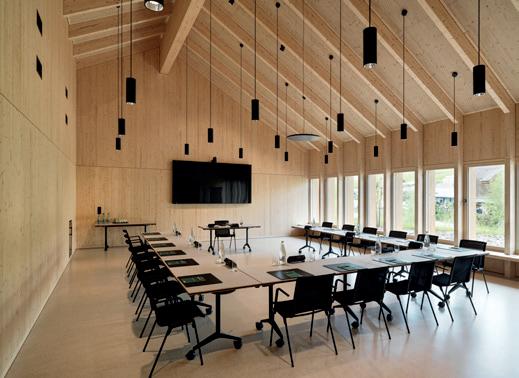
Fichtenholz und ist von Glas umhüllt. Hier genießen Gäste erfrischendes Quellwasser, entspannen im Naturbadeteich oder im 36 Grad warmen Becken, lassen den Alltag in verschiedenen Saunen, dem Sprudelbecken und im Dampfbad hinter sich, und gönnen sich kosmetische und klassische Wellnessbehandlungen, sowie therapeutische Behandlungen, die alle von engagierten Mitarbeitenden mit viel Herz und Know-how durchgeführt werden. „Alles, was Sie brauchen, um den Kopf freizubekommen und ihren Körper zu beleben“, ergänzt Susanne Leu, Direktorin des Hotel Hof Weissbad.
„Wir möchten, dass unsere Gäste neue Kraft schöpfen und inspiriert nach Hause zurückkehren“, beschreibt Susanne Leu die Philosophie des Hauses. Herzlichkeit, Fachkompetenz, höchste Qualität in allen Bereichen, ausgezeichnete Kulinarik und ein umfassendes Wellness- und Gesundheitsangebot machen das Resort Hof Weissbad zu einem Kraftort inmitten unberührter Natur – ein Erlebnis für alle Sinne und ein Ort, an den man immer wieder gern zurückkehrt.
www.hofweissbad.ch
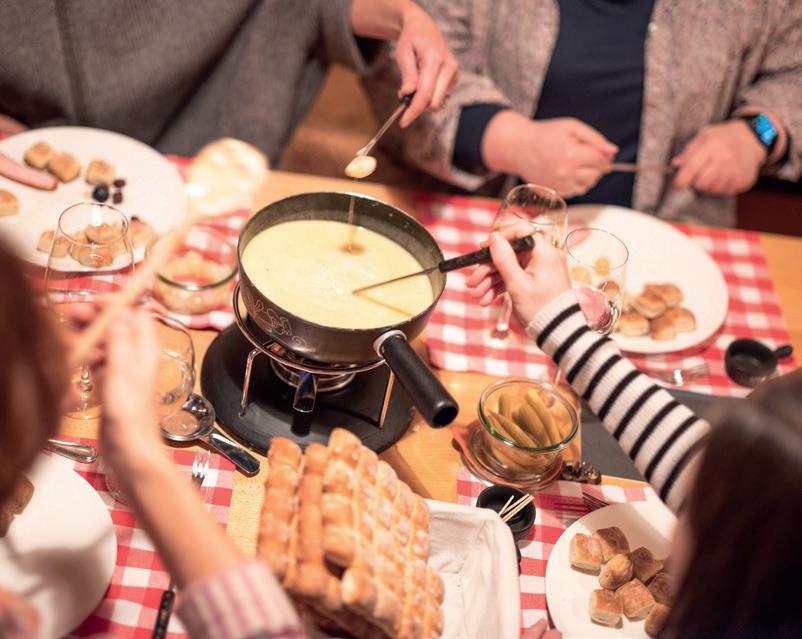

Since December 2024, the historic Mürren Palace has been shining in new splendour. Originally built in 1874, the property has been completely renovated, extended and re-opened as a stylish 4-star superior hotel. The result is a place where history, alpine lifestyle and modern design come together in a unique way.
‘It’s a Palace but not too Palace’ – a phrase that perfectly captures the spirit of Mürren Palace, where sportsmanship and friendship matter more than status.
“We wanted to create a place that honours its roots while being firmly anchored in the present,” says general manager and host Samuel Bichsel. “The hotel radiates the elegance of bygone times while combining it with warm hospitality and contemporary style.”
Perched at 1,650 metres above sea level, Mürren Palace offers its guests breathtaking views of the iconic Eiger, Mönch and Jungfrau peaks. Even the journey to the car-free mountain village of Mürren becomes part of the experience, as guests are personally collected by electric golf cart. “Visitors immediately sense that they have arrived somewhere truly special,” Bichsel emphasises. Whether it is ski-in/ ski-out in winter, snowshoe trails, open air curling or excursions to Schilthorn and Jungfraujoch – at Mürren Palace, the alpine world is at your doorstep.
The rooms and suites are generously sized, from Classic Rooms and Senior Suite Luxe to the spacious maisonette apartments. Most feature a balcony or loggia, blending modern alpine design with the colour palette of the Victorian era. “It’s the details that guests appreciate,” says Bichsel. “From the high-quality espresso machines in every room to the lovingly restored decorative features and much more. They bring the hotel’s history back to life.”
Culinary highlights are served in the lovingly restored magnificent PALACE HALL dating back to 1911. From hearty breakfasts to afternoon coffee and cake, light snacks or elegant dinners, fine cuisine meets lively atmosphere at this grand place. The PALACE CORNER complements the experience with its bar, bistro and terrace, inviting guests to relax and linger.
For its guests’ well-being and relaxation, the hotel’s own spa offers a herbal and Finnish sauna, steam bath, infrared loungers and a private massage room: all with sweeping views
of the surrounding peaks. Guests can also enjoy direct access to the Alpine Sports Centre with its 25-metre pool, massage and outdoor whirlpool and state-of-the-art fitness facilities.
Today, the very first Swiss Palace is also the newest: Mürren Palace is back, inviting guests to become part of its new story.
www.muerren-palace.ch

1874 hotel opening
2024 re-opening as Hotel Mürren Palace
49 rooms
120 beds in 4* superior category
30 Mio. CHF investment
1,650 metres above sea level in carfree Mürren
Seit Dezember 2024 erstrahlt das traditionsreiche Haus in neuem Glanz: das Mürren Palace. 1874 erbaut, wurde es komplett kernsaniert, erweitert und als stilvolles 4-SterneSuperior-Hotel wiedereröffnet. Entstanden ist ein Ort, der Geschichte, alpinen Lifestyle und modernes Design auf besondere Weise vereint.
‚It’s a Palace but not too Palace’ – dieser Gedanke beschreibt die Atmosphäre im Mürren Palace treffend. Denn hier zählen Sportsgeist und Freundschaft mehr als Status.
„Wir wollten mit dem Mürren Palace einen Ort schaffen, der seine Wurzeln ehrt und gleichzeitig fest in der Gegenwart verankert ist“, so Samuel Bichsel, Direktor und Gastgeber. „Das Hotel strahlt die Eleganz vergangener Zeiten aus und kombiniert sie mit besonderer Gastfreundschaft und modernem Stil.“
Auf 1.650 Metern Höhe bietet das Mürren Palace seinen Gästen einen atemberaubenden Blick auf die majestätische Kulisse von Eiger, Mönch und Jungfrau. Schon die Anreise ins autofreie Bergdorf Mürren wird zum Erlebnis, wenn die Gäste mit dem Elektro-Golf-Car abgeholt werden. „Unsere Besucher spüren sofort, dass sie an einem besonderen Ort angekommen sind“, betont Bichsel. Ob Skifahren mit direktem Ski-in/Ski-out, Winterwandern, Schneeschuhtrail, Open Air Curling oder Ausflüge aufs Schilthorn und Jungfraujoch – im Mürren Palace steht Gästen die alpine Welt offen.
Die Zimmer und Suiten des Hotels sind großzügig geschnitten – egal ob Classic, Senior Suite Luxe oder die weitläufigen Maisonette Apartments. Fast alle verfügen über Balkon oder Loggia und verbinden modernes alpines
Design mit den Farben der viktorianischen Epoche. „Es sind die Details, die unsere Gäste besonders schätzen. Die hochwertige KolbenKaffeemaschine in den Zimmer, liebevoll restaurierte Ornamente und vieles mehr. Sie machen die Geschichte des Hauses lebendig.”
Auch kulinarisch setzt das Hotel Maßstäbe. Herzstück ist die liebevolle restaurierte prachtvolle Palace HALL von 1911. Vom reichhaltigen Frühstück über Kaffee und Kuchen bis hin zu leichten Snacks und abendlichen Dinners: Hier trifft feine Küche auf lebendiges Ambiente! Ergänzt wird das Angebot durch das Palace CORNER, wo Bar, Bistro und Terrasse zum entspannten Verweilen einladen.
Entspannung und einen freien Blick auf die Berglandschaft bietet das hauseigene Spa
Das erste Schweizer Palace ist heute auch das neueste: Das Mürren Palace ist zurück und lädt seine Gäste ein, Teil einer neuen Geschichte zu werden.
www.muerren-palace.ch
1,650 metres a.s.l in car-free Mürren mit Kräuter- und finnischer Sauna, Dampfbad, Infrarotliegen und eigenem Massageraum. Über den direkten Zugang zum Alpinen Sportzentrum stehen zudem ein 25-MeterPool, Massage- und Outdoor-Whirlpool sowie ein modernes Fitnessstudio bereit.
1874 hotel opening
2024 re-opening as Hotel Mürren Palace
49 rooms
120 beds in 4* Superior segment
30 Mio. CHF investment




Nestled between mountains, lakes and cobbled lanes, Werdenberg invites visitors to explore a world where culture and nature intertwine. At the heart of this versatile region, the boutique hotel and restaurant Gasthaus Traube welcomes guests from near and far. It is a beloved place where genuine hospitality and refined cuisine come together in perfect harmony.
In the St. Gallen Rhine Valley, Werdenberg is one of Switzerland’s most charming small towns. With its medieval old town and castle of the same name, it boasts more than 800 years of history. From here, horizons unfold in every direction: the principality of Liechtenstein with its castle, the wine region of Bündner Herrschaft with its famous Heidi lore, the unspoilt Toggenburg, the Austrian Vorarlberg, and the shimmering waters of Lake Constance. This is a landscape rich in stories, flavours and encounters – and with some 600 kilometres of marked hiking and cycling trails, it is perfect for outdoor adventures.
Amidst this idyllic scenery, you will find the Traube. For almost two centuries, it has been part of the region’s identity, now reimagined as a boutique hotel, restaurant and culinary hotspot for locals and travellers alike.

A JEWEL BY THE RHINE
Where beer was once brewed, today a haven of indulgence invites you to linger. Following a careful renovation, hosts Kathrin SchertlerSecli and Ivan Secli have created a boutique hotel in Buchs with restaurant, banqueting and seminar spaces – a place where design, gastronomy and history form a perfect symbiosis. Rooted in tradition without being old-fashioned, contemporary without losing its original charm: every bit as authentic as the region itself.
Design lovers, foodies, outdoor explorers and wellness travellers all find their place here. The style balances Swiss tradition with a hint of Scandinavian flair – modern yet warm. Once a rustic barn, the hotel now offers spacious double rooms, perfect for those in search of a little escape, or a base from which to explore Werdenberg and Buchs properly.
CUISINE WITH SOUL
The Traube’s three-restaurant concept ensures the right atmosphere for every palate and mood. In the elegant, wood-panelled
Eingebettet zwischen Bergen, Seen und historischen Gassen lädt Werdenberg zu Kulturund Naturerlebnissen ein. Mitten in dieser vielseitigen Region empfängt das Boutique-Hotel und Restaurant Gasthaus Traube Gäste von Nah und Fern – und bietet einen Ort, an dem traditionelle Herzlichkeit und feine Kulinarik auf einzigartige Weise zusammenfinden.
Im Herzen des St. Galler Rheintals liegt eine Region, die Tradition und Moderne, Natur und Kultur auf besondere Weise verbindet: Werdenberg, mit seiner mittelalterlichen Altstadt und dem gleichnamigen Schloss, gilt als eine der charmantesten Kleinstädte der Schweiz und blickt auf eine 800-jährige Geschichte zurück. Von hier aus öffnen sich Horizonte: Liechtenstein mit seinem Fürstenschloss, die Bündner Herrschaft mit Weinbergen und der berühmten Heidi-Geschichte, das Toggenburg mit seiner alpenländischen Ursprünglichkeit, Vorarlberg auf der österreichischen Seite bis hin zum Bodensee. Wer hier ankommt, findet sich in einer Landschaft wieder, die reich an Geschichten, Genussmomenten und Begegnungen ist – und die, mit rund 600 Kilometern ausgeschilderten Wander- und Bike-Routen, perfekt für Entdeckungstouren in alle Richtungen angebunden ist.
Mitten in diesem idyllischen Umfeld empfängt das Gasthaus Traube seine Gäste. Das Haus ist seit fast 200 Jahren Teil der regionalen Identität und setzt heute als BoutiqueHotel, Restaurant und Genusstreffpunkt für

Einheimische und Besucher aus aller Welt neue Maßstäbe.
EIN JUWEL AM RANDE DES RHEINUFERS
Wo einst Bier gebraut wurde, lädt heute eine wahre Genuss-Oase zum Verweilen ein. Nach einer behutsamen Renovation haben die Inhaber Kathrin Schertler-Secli und Ivan Secli

in Buchs ein Boutique-Hotel mit Restaurant, Bankett- und Seminarräumen geschaffen, das Design, Kulinarik und Geschichte auf besondere Weise vereint. Bodenständig, ohne altmodisch zu wirken. Zeitgemäß, ohne den ursprünglichen Charme zu verlieren - genauso authentisch wie die Region selbst.
Design-Liebhaber, Foodies und Outdoor-Urlauber, sowie Menschen, die auf der Suche nach Ruhe sind, finden hier gleichermaßen ihr Glück. Der fein abgestimmte Stil ist eine Mischung aus Schweizer Tradition and Skandinavischem Flair: zeitgemäß und dennoch warm. Das Hotel, welches aus einst eine urige Scheune war, bietet großzügigen Doppelzimmer, ideal für alle, die eine kleine Auszeit suchen oder die Region Buchs / Werdenberg intensiver erleben möchten.
Die Traube punktet mit einem Drei-RestaurantKonzept, was nicht nur für jeden Geschmack, sondern auch für jede Stimmung den passenden Rahmen liefert. Mit internationaler Fine-Dining-Erfahrung verbindet Küchenchef Jonas Grundner im eleganten, holzvertäfelten Traubensaal handwerkliche Präzision mit einem ungezwungenen Zugang zur Haute Cuisine. Sein Konzept ist ‚Casual Fine Dining‘, also Gerichte, die Seele haben, überraschend


Traubensaal, head chef Jonas Grundner draws on international fine-dining experience, combining craftsmanship with an informal approach to haute cuisine. His vision of casual fine dining delivers dishes full of soul, tasty surprises and a relaxed spirit.
The Braustube offers a fresh take on beloved Swiss classics, served around solid oak tables where conversations flow as easily as the house speciality, Truuba beer.
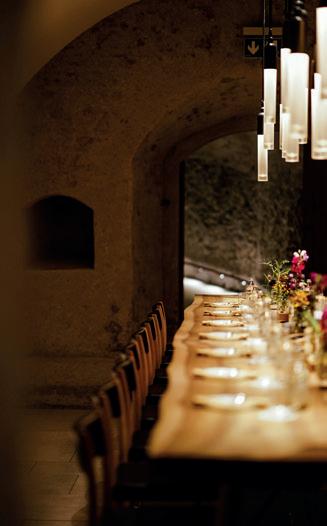
The bright, airy Gartenzimmer – also known as the living room of Buchs – is the hotel’s heart, seamlessly connecting indoors and out. From breakfast to aperitifs, the bistro serves delights from the in-house bakery, from homemade cakes to internationally inspired vegetarian dishes.
A heartfelt priority of the house is its close collaboration with regional producers. “Our relationships with producers are defined by
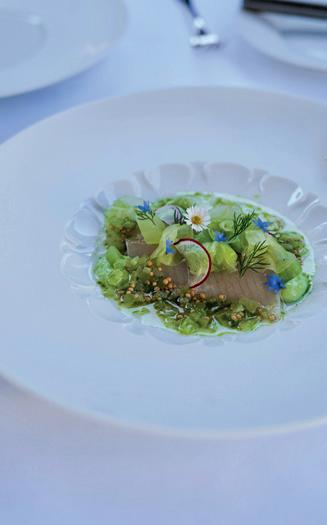

proximity, as we work primarily with the region. Whenever possible, we prefer to buy directly from the farm,” deputy managing director Christian Ihm notes. This farm-to-table philosophy not only guarantees exceptional freshness and flavour, but also makes a clear commitment to sustainability and the local community.
Wine lovers will delight in the Traube’s cellar: with more than 1,100 offerings, including Switzerland’s largest Champagne selection, it is one of the country’s most exciting collections. From rare regional finds to international icons, the list is a real treasure trove. A highlight is the historic ice cellar, now a captivating venue for tastings and various events.
After a day in Werdenberg – spent wandering its cobbled lanes, hiking in the nearby Alps or visiting Lake Constance – the Traube is the perfect retreat. A place to slow down, savour, meet people and let your spirit rest.
It is the interplay of house and region that makes the experience so memorable: Werdenberg provides the stage, the Traube sets the tone. Together, they create moments that linger long after your stay – and beckon you to return.
www.gasthaus-traube.ch
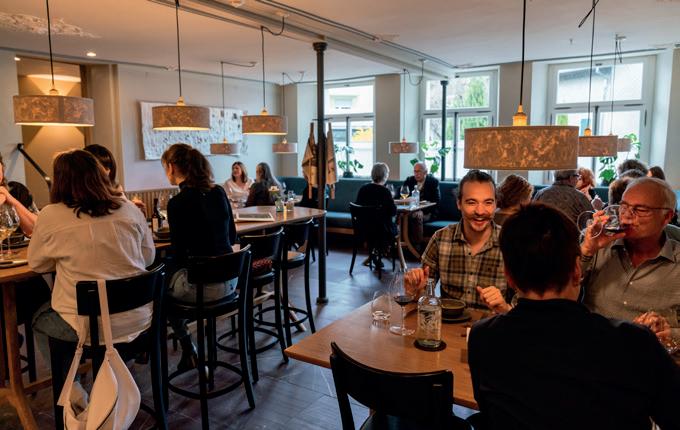
im Geschmack sind und doch entspannt in die Atmosphäre passen.
Ergänzt wird das Angebot durch die Braustube, wo beliebte Klassiker der Hausmannskost saisonal neu interpretiert werden. Am massiven Eichentisch trifft man sich hier auf gute Gespräche, klassische Gerichte und traditionelle Durstlöscher wie das Truuba Bier.
Herzstück ist das lichtdurchflutete Gartenzimmer, auch als Wohnzimmer von Buchs bekannt, das Innen- und Außenwelt nahtlos verbindet. Ob Frühstück, Mittag oder Aperitif –hier entsteht die besondere Atmosphäre
des Ankommens. Das Gartenzimmer bietet ein Bistro mit Leckereien aus der hauseigenen Backstube, von selbstgebackenem Kuchen bis zu international interpretierten Gerichten mit Fokus auf Gemüseküche.
Eine Herzensangelegenheit des Hauses ist die enge Zusammenarbeit mit Produzent:innen aus der Region. „Unsere Beziehung mit den Produzent:innen zeichnet sich durch die Nähe aus, da wir in erster Linie mit der Region zusammenarbeiten. Wir kaufen am liebsten direkt ab Hof“, betont stellvertretender Geschäftsführer Christian Ihm. Dieses Farm-to-Table-Konzept sorgt nicht nur für

unvergleichliche Frische und Geschmack, sondern ist auch ein klares Bekenntnis zur Nachhaltigkeit und Region.
Wer in der Traube einkehrt, sollte sich unbedingt Zeit nehmen, ein bisschen in der Weinkarte zu stöbern. Mit über 1.100 Positionen, darunter die größte Champagnerauswahl der Schweiz, gehört sie zu den spannendsten des Landes. Ob regionale Raritäten oder internationale Spitzenweine, hier schlagen die Herzen der Wein-Connaisseurs definitiv höher. Ein besonderes Highlight ist der historische Eiskeller, der heute als stimmungsvoller Ort für Weinverkostungen und Veranstaltungen aller Art dient.
EIN ORT, DER IM HERZEN BLEIBT
Nach einem erlebnisreichen Tag in Werdenberg – sei es ein Spaziergang durch die Gassen, eine Wanderung in den nahen Alpen oder ein Abstecher zum Bodensee – ist die Traube der perfekte Ort, um zur Ruhe zu kommen. Hier kann man entschleunigen, genießen, Menschen begegnen und die Seele baumeln lassen.
Das Zusammenspiel von Region und Haus macht den Reiz aus: Werdenberg bietet die Bühne, die Traube setzt den Akzent. Gemeinsam entsteht ein Erlebnis, das lange nachklingt und Lust macht, wiederzukommen.
www.gasthaus-traube.ch



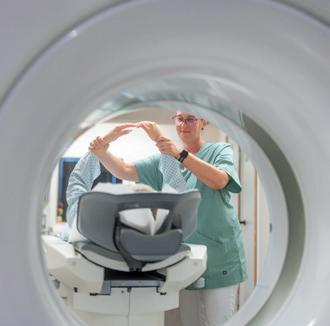
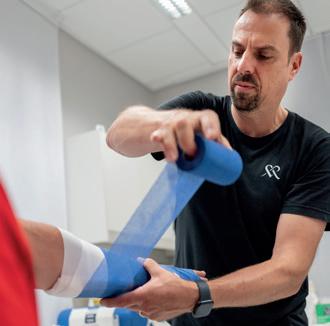
Seit drei Jahren auch auf dem deutschen Markt bekannt, überzeugt das finnische Unternehmen Meliva mit patientenzentrierter Gesundheitsfürsorge – vor Ort und digital.
„Das deutsche Gesundheitssystem genießt weltweit einen guten Ruf. Es ist breit aufgestellt, verfügt über gut ausgebildete Fachärzt:innen und Kliniken und garantiert eine hohe Versorgungsqualität. Doch wer medizinische Hilfe sucht, steht oft vor großen Herausforderungen: lange Wartezeiten, parallele Anlaufstellen, wenig Transparenz. Fachärzte, Hausärzte, Kliniken und digitale Angebote arbeiten häufig nebeneinander statt miteinander”, analysiert Dr. med. Gerald Loos, Geschäftsführer der Meliva GmbH. „Auch die Digitalisierung kommt nur langsam voran. Die elektronische Patientenakte etwa ist zwar eingeführt, wird aber bislang kaum genutzt.”
Finnland geht mit seinem Hausarztmodell einen anderen Weg. Dort bildet der Hausarzt die erste Anlaufstelle, von der aus Patient:innen durch alle weiteren Schritte begleitet werden. Das System ist klar strukturiert, patientenzentriert und eng mit digitalen Lösungen verzahnt. Prävention, Diagnostik, Behandlung und Nachsorge greifen nahtlos ineinander. Für Patient:innen bedeutet das vor allem weniger Bürokratie, mehr Orientierung und bessere Ergebnisse.
Dieses Modell bringt der finnische Gesundheitsdienstleister Meliva nun auch nach
Deutschland. „Unsere Dienstleistungen stehen allen offen, sowohl gesetzlich als auch privat Versicherten. Wir verstehen uns als moderne Schnittstelle zwischen digitaler und persönlicher Gesundheitsvorsorge. Patient:innen können Rezepte online anfordern, eine Videosprechstunde buchen oder sich vor Ort an eine Praxis wenden. Hinter den Kulissen arbeiten interdisziplinäre Teams eng zusammen. So entsteht eine Gesundheitsversorgung, die einfach zugänglich, transparent und effizient ist.”
Melivas besonderer Vorteil ist der holistische Ansatz: Das Angebot reicht von der Prävention über Diagnostik bis hin zu Operationen und Rehabilitation. Damit deckt das Unternehmen die gesamte Versorgungskette ab. Dabei sorgt das innovative Hybrid-Modell dafür, dass digitale und persönliche Betreuung nahtlos ineinandergreifen. „Ein klares Plus für Patient:innen und Fachkräfte. Unsere Tools entlasten Ärzt:innen und Pflegekräfte, die dadurch mehr Zeit für die individuelle Betreuung ihrer Patient:innen haben”, betont Dr. Loos.
Im Vergleich zu anderen Anbietern hat Meliva einen entscheidenden Vorteil. „Während andere Anbieter häufig nur einzelne Fachbereiche abdecken, setzen wir bewusst auf Vernetzung und fachübergreifende Betreuung, sowohl
hybrid als auch integriert. Damit schaffen wir ein Versorgungskonzept, das die Patient:innen stärker in den Mittelpunkt stellt und zugleich die Arbeitsbedingungen im Gesundheitswesen verbessert.”
Als Teil von Mehiläinen, Skandinaviens führendem Gesundheitskonzern, profitiert Meliva klar von der internationalen Erfahrung des Konzerns, der seit Jahren erfolgreich in sechs Ländern tätig ist und die dort gewonnenen Erkenntnisse gezielt in die Weiterentwicklung der Gesundheitsversorgung in Deutschland einbringt.
Mit seinem Anspruch, Gesundheit neu zu denken zeigt Meliva, wie patientenzentrierte Versorgung auch in Deutschland aussehen kann, nämlich unkompliziert, modern und zukunftsorientiert.
www.meliva.de


The clocks may have gone back, but November does not slow down! This month is filled with film festivals, art events, early carnival celebrations and food fairs – not to mention the first Christmas markets twinkling into life. Whatever your passion, you will find something to brighten up the darker days.
TEXT: MARILENA STRACKE
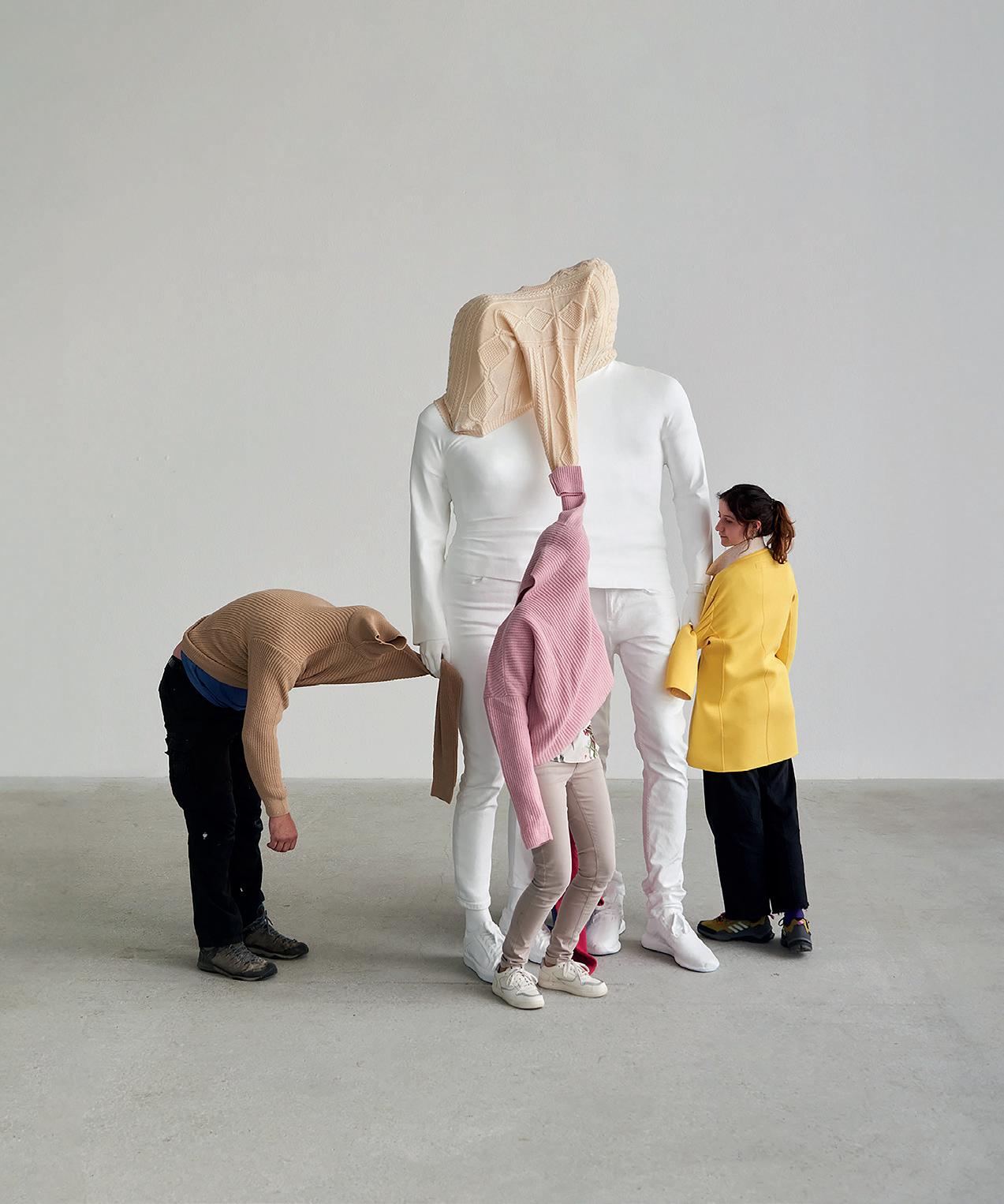
GENEVA INTERNATIONAL FILM FESTIVAL (31 OCTOBER – 9 NOVEMBER)
Celebrate the 31st edition of the Geneva International Film Festival, a firm favourite for filmmakers across the world. Expect international premieres, thought-provoking master classes and buzzing networking opportunities in one of Switzerland’s most dynamic cultural hubs. www.giff.ch
BERLINER MÄRCHENTAGE, BERLIN (6 – 23 NOVEMBER)
Step into the world of myths and magic during the 36th Berlin Fairy Tale Days. This beloved festival brings classic stories and modern fantasy to life through readings, performances and exhibitions across the city. This year’s theme is ‘The Swan Princess’ and it promises to be a cultural highlight for families and dreamers of all ages. www.berliner-maerchentage.de
INTERNATIONAL A CAPPELLA FESTIVAL VOICE MANIA, VIENNA (7 NOVEMBER – 7 DECEMBER)
For its 27th edition, Vienna once again becomes the stage for vocal artistry in all its forms. Voice Mania goes far beyond traditional singing, blending jazz, pop, rock, beatboxing, comedy and vocal experimentation into a month-long celebration. Expect
Berliner Märchentage.
MÄRCHENLAND



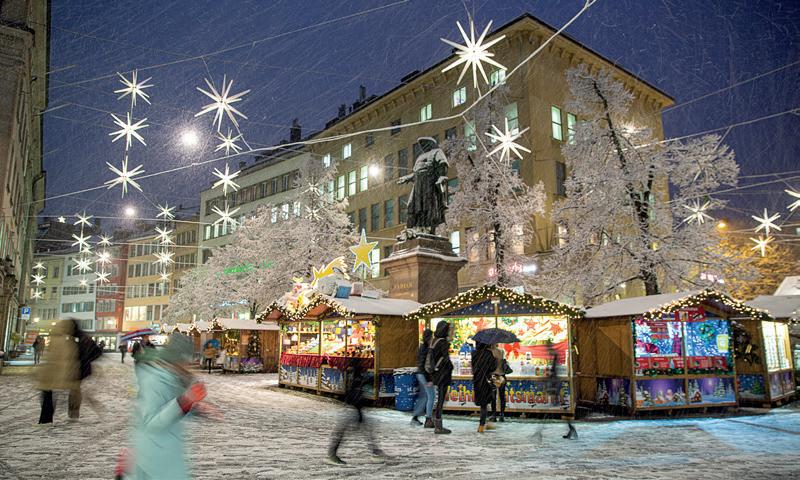
dazzling performances in theatres, clubs and even on the streets of Vienna where the human voice takes centre stage in the most inventive ways.
www.voicemania.at/das-festival
PLAZA CULINARIA, FREIBURG (7 – 9 NOVEMBER)
Southern Germany’s premier gourmet fair returns to Messe Freiburg, attracting more than 35,000 food lovers each year. From live cooking shows to wine tastings and workshops, Plaza Culinaria offers a delicious weekend of culinary inspiration with regional and international flair. www.plaza-culinaria.de
VIENNA ART WEEK, VIENNA (7 – 14 NOVEMBER)
For one week each November, Vienna turns into a city-wide stage for contemporary art. With free exhibitions, studio visits, talks and performances across museums and independent spaces, Vienna Art Week celebrates creativity across the board while keeping culture accessible to everyone. www.viennaartweek.at
CARNIVAL SEASON KICK-OFF, COLOGNE (11 NOVEMBER)
At exactly 11.11am, Cologne bursts into celebration with the official start of carnival season. Thousands of people in colourful
costumes fill the streets, turning the city into a joyful madhouse of music, dancing and laughter. It’s the perfect way to experience Germany’s most famous carnival tradition at its most vibrant, long before the big parades in spring.
www.koeln.de
WIEN, VIENNA (12 – 16 NOVEMBER)
Austria’s leading book fair brings together more than 500 exhibitors and a rich programme of readings, discussions, workshops and book signings. From novels and non-fiction to children’s books and graphic novels, Buch Wien celebrates literature in all its diversity. A cornerstone of the Austrian

literary scene, it attracts book lovers and industry professionals from around the world. www.buchwien.at
OF
(2 7 NOVEMBER – 6 JANUARY)
St. Gallen welcomes the festive season with its enchanting ‘City of Stars’. More than 700 glowing stars light up the historic old town, creating a magical backdrop for the Christmas market. Over 50 wooden stalls offer handcrafted gifts, festive decorations and Swiss delicacies, while the UNESCO-listed Abbey and a towering Christmas tree with 18,000 lights add to the city’s sparkle. www.sternenstadt.ch



This column is about to whom Berlin really belongs – the relentless cyclist.
You have to be both brave and wide awake if you take to the streets of Berlin – it is not for the fainthearted – and least of all for the naive sort, who think it is a good idea to rent an e-bike with beer bottle and/or mobile in one hand, while trying to steer with the other, preferably on the pavement.
Actually, cycling through all seasons in Berlin needs a cool-headed flexibility, knowledge of basic rules and sense of high alert at all times. And yet, most of the residents do it, many of which with their kids accommodated in attached cabins resembling very expensive wheelbarrows.
Cyclists may be a nuisance to some, but the majority has accepted Berlin to be a, sometimes fallible, cyclists’ paradise – fallible as there still aren’t enough safe cycling routes by far. In fact, both residents and visitors should be aware of the risks of exploring the city this way. Sounds stressful? It might ease your mind that more and more bike lanes and streets are in the making due to long-term plans of the past administration –and they are unlikely to be reversed. We may not have yet reached Paris standards, but no matter how slow politics are, the residents have long decided which vehicle should dominate this city.
When I moved to Berlin a long time ago, my mother visited from the small town she was living in at the time, and trustfully stepped on one of the guest bikes – only to realise that cycling in Berlin in no way resembled the world she was used to. In fact, the stress of managing Berlin traffic can put some visitors off right from the start. Mind, a close friend from Australia, who actually grew up here, has recently admitted that the thought of cycling in Berlin freaks her out – and this from the mouth of a born and bred Berliner!
Anyhow, the environment benefits from all the stern individuals who roam this city on their own bikes through all seasons – and so does their purse, of course. You invest in your bike once a year to get it shipshape again –and then you head off once more. Personally, I regard my daily travels from A to B as my own fitness studio – with the plus of being outside and getting that daily dose of sunlight you need to brave the dark months, starting with November. Just one piece of advice: if you’re not familiar with German traffic law, please know that – given there is no sign to say otherwise – right-hand traffic always has right of way. Also, keep an eye out assuming others know the traffic laws as little as you do. And – though it may look uncool – don a helmet before setting off and make sure
your lights are on. All set for joining the city of cyclists? Enjoy the freedom – godspeed and safe travels!

field of interest being art and design, she enjoys observing her history-laden home town in all its quirky detail and ever-changing shape and culture. Apart from writing, the author also engages in English language theatre, the art of which she learned in London.
Another year, another autumn, another occasion for the much-beloved Übergangsjacke. Yes, it’s time again for a piece of clothing that is as German as Stoßlüften (more on that another time) and Abendbrot (regular readers of this column should be familiar with that!).
Anyone who’s ever lived in Germany, might have heard this mysterious word Übergangsjacke which, in true German fashion, doesn’t hide what it’s about. A compound noun as good as they get, with the literal meaning of transition jacket. This in-between jacket is a staple in German wardrobes for when the seasons cannot decide between warm and cold in autumn (and, of course, also in spring).
As German autumn weather can be a bit of a Wundertüte (another good one, literally meaning wonder bag) and you never know what you get – sunshine, cold winds and rain, preferably all in one day – a good Übergangsjacke is your armour against the elements.
Finding the perfect one is a quest that Germans take seriously. It needs to be light but still keep you warm, wind and rain resistance is a must, being able to combine it with sweaters and scarves (Germans without scarves? Unthinkable!) goes without saying. Then, there are the necessary big (enough) pockets and, of course, an agreeable colour that works with whatever else you might choose to wear that day.
Some people might search for years to find a perfect jacket that meets all of these conditions and is not as heavy as a winter coat and not as flimsy as a summer jacket. Oh, yes, there’s an art to the German Übergangsjacke, just as there is to Stoßlüften and a proper Abendbrot. And should you say, “hang on, we’ve got that in the UK as well, we just don’t have that word for it and call it autumn jacket or similar,” I’ll say, that’s exactly my point. Germans take this type of jacket so seriously that they grace it with its very own term. And with that, I’ll leave you to get hunting for your perfect Übergangsjacke, your best friend when the weather can’t decide which way to go…

Barbara Geier is a London-based freelance writer, translator and communications consultant. She is also the face behind www.germanyiswunderbar.com, a German travel and tourism guide and blog that was set up together with UK travel writer Andrew Eames in 2010.
Discover Germany Issue 135, November 2025
Published 11.2025
ISSN 2051-7718
Published by Scan Magazine Ltd.
Print H2Print
Executive Editor Thomas Winther
Creative Director
Mads E. Petersen
Editor
Nane Steinhoff
Copy-Editor
Malin Norman
Graphic Designer
Mercedes Moulia
Contributors
Barbara Geier
Cornelia Brelowski
Jessica Holzhausen
Marilena Stracke
Norbert Eisele-Hein
Silke Henkele
Xander Brett
Cover Photo
© Tanja Schalling
Sales & Key Account Managers
Julia Freisinger
Lawinia Toth
Sophie Blecha
Esther Nainggolan
Publisher:
SCAN CLIENT PUBLISHING
SCAN MAGAZINE LTD
The News Building, 3 London Bridge Street, SE1 9SG, London
Phone: +44 (0)870 933 0423
Fax: +44 (0)870 933 0421
Email: info@discovergermany.com www.discovergermany.com
© All rights reserved. Material contained in this publication may not be reproduced, in whole or in part, without prior permission of Scan Group – a trading name of Scan Magazine Ltd.
This magazine contains advertorials/ promotional articles.
The award-winning beach resort that provides global travelers with the perfect balance of relaxation and adventure in the tropical paradise of Phuket.

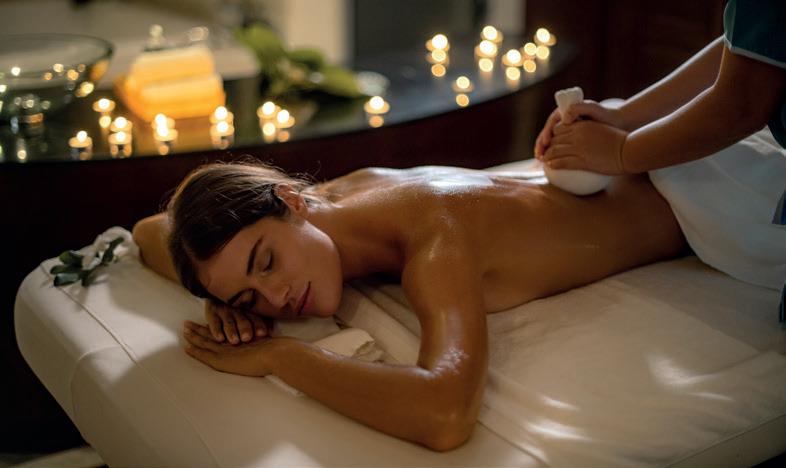



@pullmanphuketpanwa



Der Leipziger Weihnachtsmarkt zählt zu den ältesten und schönsten Deutschlands: ein wahres Wintermärchen mit festlich geschmückten Ständen, Glühweinduft und regionalen Köstlichkeiten. Detailverliebt gestaltete Märkte – etwa am Gohliser Schlösschen oder im Werk 2 am Connewitzer Kreuz – laden abseits des Trubels zum Entdecken ein.
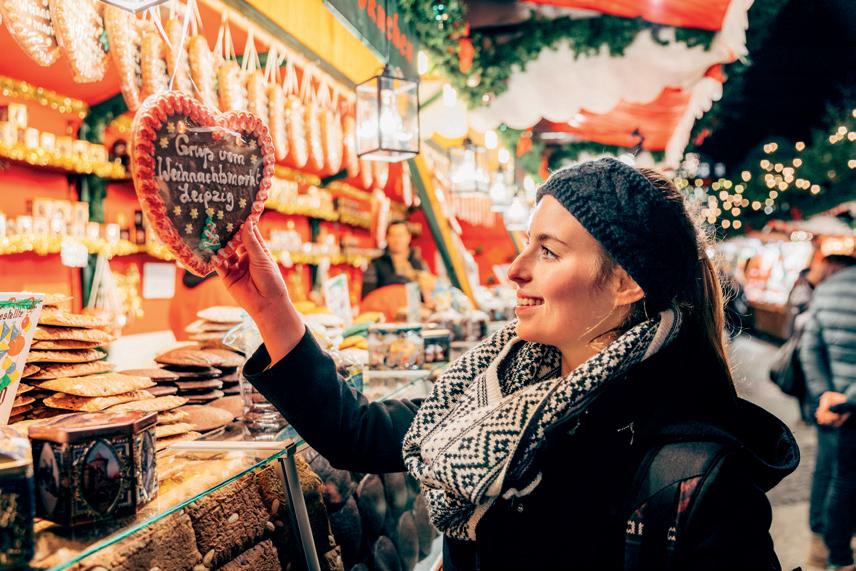
Erleben Sie Leipzig im Advent bei einem Kurzurlaub zu zweit: 2 x Übernachtung mit Frühstück in einem unserer Partnerhotels, Nachtwächterführung in der Innenstadt sowie 3-GangAdventsmenü im historischen Gasthaus Barthels Hof.
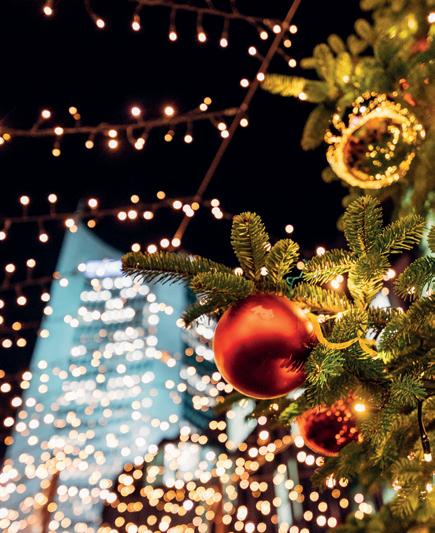
Jetzt Leipzig zur Weihnachtszeit entdecken:
